#keeping the names the same and the references to japan the same
Explore tagged Tumblr posts
Text
"Your Japense, then?"-"Yeah, and proud of it!" Words that would have never been in Beyblade Metal Masters if it had been dubbed by bitches like 4kids.
#the way beyblade is the one anime that sticks to its japanese roots even in dubs#keeping the names the same and the references to japan the same#4kids could never
2 notes
·
View notes
Text
like i tend to hate every fandom cause its always annoying some way or other but theres actually so much i literally bloody despise about the ace attorney fandom and all that random fanon they made up without even realising it has absolutely nothing to do with the games. it isnt even good fanon if that could even exist most of it is total utter rubbish
#theres no point even listing everything i hate about it but its so annoying i literally have to#like some of the fanart like why do you even consider that the same characters#like phoenix has brown eyes in the games its so obnoxious when they keep making one blue like whats the point it looks so stupid#and like the styles and stuff you do realise its not you and your cliche of tumblr fandom mates dont you#dunno the word maybe i should avoid saying 'yasify' even though that lot says it all the time but really cant think of it#also why on earth do they keep feminising edgeworth so much it literally doesnt make any sense did we even play the same games#plus the whole explanation they make up for edgeworths backstory that has nothing to do with the games but they think its actually canon#obviously theyre all completely incapable of portraying emotions reasonably but why is it all so over the top and conpletely made up#not just the totally exxaggerated reactions but the whole stuff about von karma they make up thats total rubbish#like it can be strict and not brilliant and direct them in bad ways and mess them up without making up all that stuff#abmnd the stupid thing how they think phoenix and edgeworth had romantic feelings for each other in primary school its utterly ridiculous#and how theyre convinced of him sending him letters and that rubbish its totally stupid#and how they call edgeworth by his first name like go ahead and show us your talking about a totally differe t character#and phoenix being into art is a stupid fanon he never shows the slightest interest in it at all people just want him to cause they are#and i saw a screenshot interview it said acting though they get that wrong too it was shakespear not american schoolkids#on that topic how they make them into americans like they literally go in america this yadayada completely unironically#how can the whole fandom literally think its set in america its literally the stupidest thing the translaters fault but why do they have to#take it so seriously like its still obviously japan why make it america its literally so random im so sick of america#like it was written as japanese making the text english doesnt change the background context you idiots#also how they keep randomly making characters be parental figures to characters they arent like appollo and phoenix its ridiculous#plus the way they write the actual family relationships its hard to believe theyve ever even had family members the way it sounds like#their only reference for their knowledge of family relationships is a few cliche hollywood films#theres loads of other stuff too im sure but i cant think of it right now
0 notes
Text
Shidou Kirisaki killed for his son, not his wife
After a lot of thinking, I think I've got a solid theory for how Shidou's crime went. Stick with me here
His wife and 2 kids get into a car crash, and only his oldest child survives. He needs organ transplants, but due to the complicated perception of brain death in Japan, there's not enough organ donors.
Shidou starts trying to convince families of brain dead patients to sign them up as organ donors, but doesn't get the organs he needs for his son because he's not in control of what goes where obviously.
He gets more desperate as time goes on and his child's state worsens, and just kills braindead patients himself, making it seem like an accident. Again he's not in control of where the organs go, so he has to kill many people so that the organs can go to his surviving family.
His son dies during the organ transplant, or shortly after.
Shidou turns himself in because he has nothing to live for anymore.
Evidence & other details under the cut v
The car crash
In the intro of Triage, Shidou is walking home with groceries. By itself it's not weird or anything, but it could imply that his wife had the car to drive the kids to or from school at that moment.
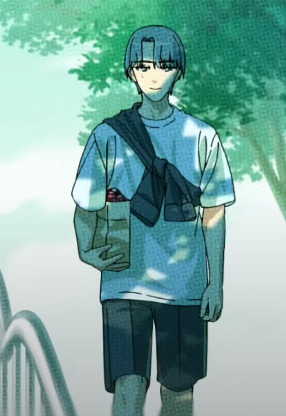
In the scene of Throw Down where Shidou wakes up (alone, in a double bed), it zooms on broken glass on the floor. Glass in cars are made to break into pieces when they suffer shock.
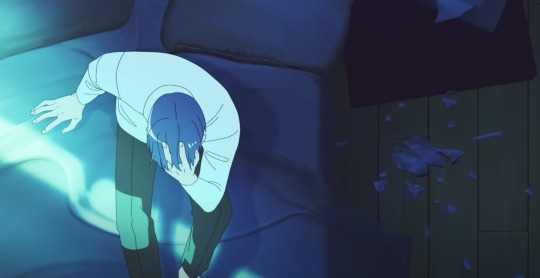

In his T2 interrogation, Shidou is asked that question.

His wife and youngest kid die in the crash, his oldest kid is the only one that survives
In Triage, his youngest child is always clinging to their mother, implying a certain connection between them. (this is going somewhere I swear)
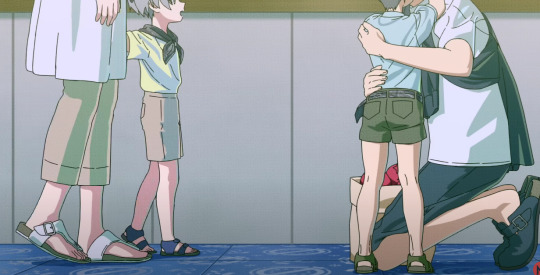
The theme of receipts being patient files is present in both Throw Down and Triage; so when this scene in Triage happens, it implies that he's giving those lives to his son. He does not do the same for his wife, or his youngest kid.
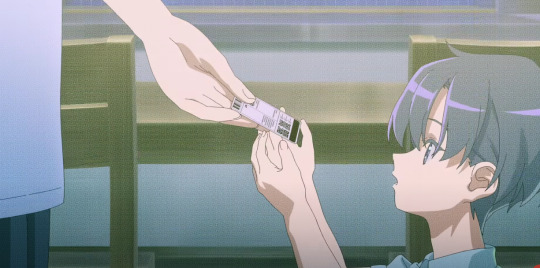
In the part where he puts his hand over his face in Triage, you can see that. Again with the 2 groups.
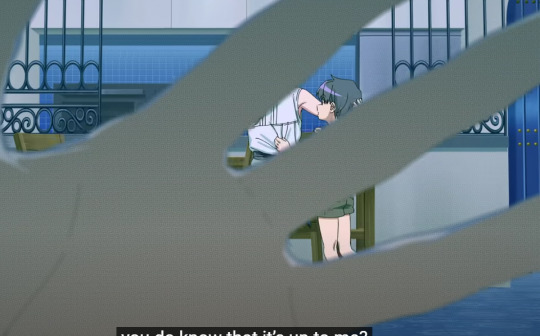

In Throw Down, 2 wilted flowers are under a glass case, while one wilted flower isn't. That could symbolize that 2 of them are enclosed in a coffin, and the last one isn't, even though he's already wilted.
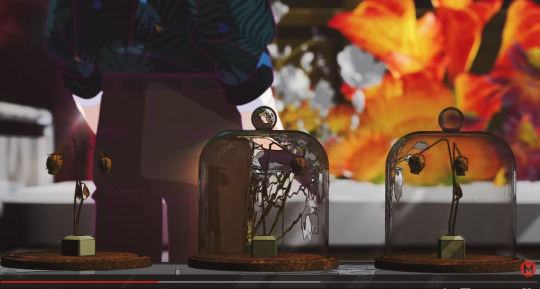
The receipt/patient file that Shidou rips up at the end of Throw Down: it's hard to see what it says exactly (what organ IS that), but you can see that the XY chromosomes are ticked off. So unless his wife is trans (which would be great), the last file to expire, or be destroyed, or the life to die, is a boy's. That's why I keep referring to his oldest child as a boy (unless that child is trans which would be great again, but I doubt that milgram would do that). The name there says something like Rei/Kei/Kai Kirisaki. It would be confusing if both Shidou's son and Mu's victim are named Rei, but that might be the case.
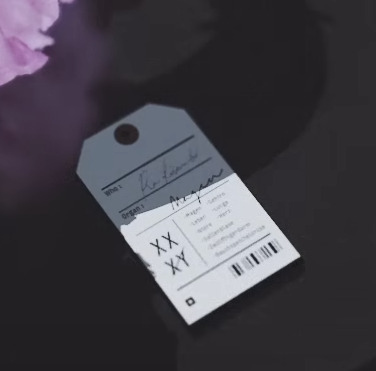
Shidou tries to convince families to sign their braindead relatives as organ donors
Aesculapius:

Shidou stops asking and just takes the organs (or kills the braindead patients) himself, passing it off as accidents
Throw Down: You can see him reassuring a grieving family, and "sniffing out lies"


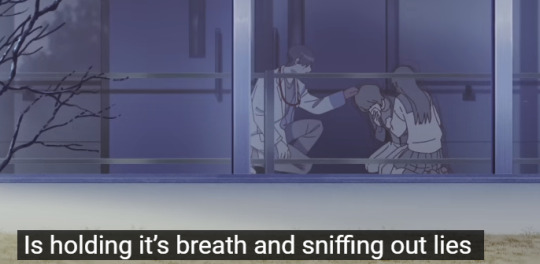
Aesculapius:

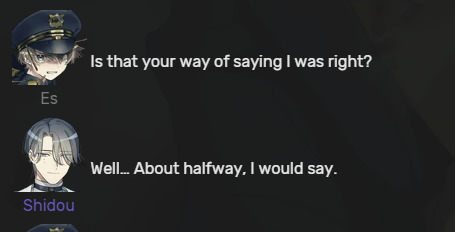
I think it would be weird if his "murder" was just convincing families to sign their relatives up as organ donors (even though that does count as medical malpractice)
His son dies during the organ transplant, or shortly after
Throw Down: His human-shaped flower abomination starts moving again, but after stepping out of the hospital bed, it crumbles into pieces, and Shidou is horrified. Flowers represent the lives he's cutting to add to it.
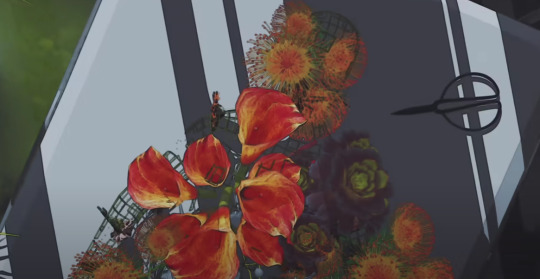

Shidou turns himself in
I have no evidence for that one, but what else would he even do. In the start of T1, he's asking for the death sentence.
Other Fun Facts:
Shidou used to cook pancakes for his kids. That's why he's so insistant on Amane trying them in minigram. (There are two plates of them on the floor.)
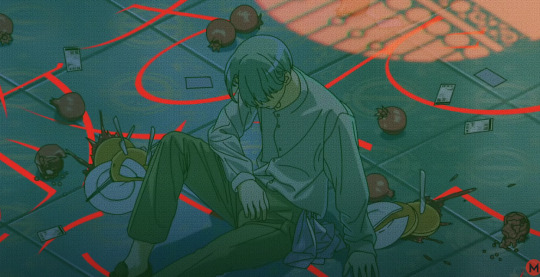
His children liked to draw. probably why he's started drawing as a hobby in milgram.
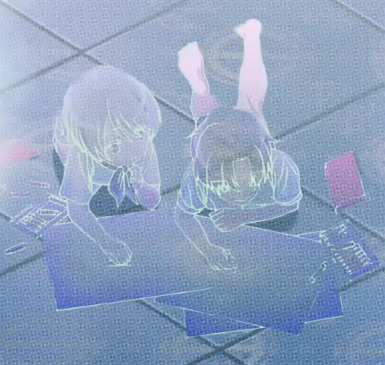
The intro of Triage where he's walking home with groceries is (according to me) a memory of the day he got the news of the car crash. You can see the groceries through the MV, discarded on the floor or rotting. They're pomegranates, whose insides look like human organs - and he gives the receipts for them to his son. At first it's just groceries, but then they're human lives.
The phone call translates to "Hi this is Kirisaki, I'm busy right now, please call later" or something like that, implying he was busy when someone called to inform him of the deaths.
#milgram#shidou kirisaki#milgram theory#talking#i got some of that from a tumblr post#but ive lost the link#most of this is the fruit of my thinking though
202 notes
·
View notes
Text
THE TODOROKI FAMILY: QUESTIONS AND ANSWERS
So this is a giant wall of information I searched for my fics as well as answers to many questions I saw around about the Todoroki family. The answers are based on canon and Japanese culture. Keep in mind things are changing, people are not all the same just because they’re Japanese, and more important than all that I’m not Japanese so, even though I documented myself, I might be wrong on the bits regarding it. Consider all this food for thoughts, a crutch to help you to find info, and not the holy bible and make sure to document yourself better. Occasionally I’ve also added things that might seem the most realistically possible option. Feel free to disagree as I’m not Horikoshi and I don’t make the rules.
I started with general data and then I placed the rest of the information chronologically following their history, discussing canon facts but also things like how divorce works in Japan and why Rei couldn't ask it, beliefs, child abuse and which is its punishment, stance on therapy, schools and so on, plus some info about other things which end up connecting with the Todoroki.
I hope people can find it of some use and yes, it’s really long but I preferred to put everything in a single post. If something relevant about the Todoroki will be revealed in the future I’ll probably update this.
XX WHAT DO THE TODOROKI’S NAMES MEAN?
The meaning of a Japanese name is generally given by the kanji that form that name. Different kanji forming the same name give different meanings. Occasionally the reading of the name (which might even differ from the standard reading for the kanji) is also considered as an additional meaning.
Tokoroki (轟): “roar, thunder, boom resound”. In this specific case it likely refers to the sound of a roaring fire, in fact in the manga the chapter in which Enji fight the High-End called ‘Moeyo Todoroke! VS Nōmu: HIGH END’ (燃えよ轟け!VS脳無:ハイエンド “Flaming Roar! vs. Nōmu: High-End”), however ‘todoroku’ can also refer to “to be well-known; to be famous” which might be a nod to how Shōto is the son of the famous Number 2. It’s a relatively common surname, especially in the Saga Prefecture, Japan.
Enji (炎司): “flame” (炎 ‘en’) and “boss” (司 ‘ji’).
Tōya (燈矢): “lamp” (燈 ‘tō’) and “arrow” (矢 ‘ya’). Tōya is also an ‘alternate reading’ for 18 (‘tō’ と is the reading for 十 “ten” and ‘ya’ や is the reading for 八 “eight”) which is the day in which Tōya had birth.
Fuyumi (冬美): “winter” (冬 ‘fuyu’) and “beauty” (美 ‘mi’). Fuyumi is born short before winter began so her name might also be a reference to that.
Natsuo (夏雄): “summer” (夏 ‘natsu’) and “excellent male” (雄 ‘o’). Natsuo is born in summer so his name might also be a reference to that.
Shōto (焦凍): “burned” (焦 ‘shō’) and “frozen” (凍 ‘to’). His name is a clear reference to his Quirk.
Rei (冷): “cold” (冷 ‘rei’). It might be coincidental but one of the standard ways for how to stay “zero” in Japanese is to say ‘rei’ though of course this ‘rei’ is written with a different kanji (零) and is used in expressions like ‘rei do’ (零度 “zero degrees”). Japanese women normally discharge their maiden name once they marry so Rei is just Todoroki Rei.
Himura (氷叢): “ice” (氷 ‘hi’) and “gathering, collection” (叢 ‘mura’). It might be just me but I couldn’t find traces of people having the surname ‘Himura’ written with those kanji. It’s generally written as 日村 (“sun village”), 緋村 (“scarlet village”), 火村 (“fire village”), 木村 (“tree village”) or other variations. The surname is a reference to how the Himura have an ice Quirk.
XX WHAT DOES THE TODOROKI HERO AND VILLAIN NAMES MEAN?
FLAME HERO ENDEAVOR (フレイムヒーロー エンデヴァー): In English is pretty self explanatory. In Japanese ‘endeavor’ would be ‘doryoku’ (努力 “effort”). [Chap. 356] In Japan there is a stronger belief in effort as opposed to innate ability. Effort is seen as necessary to fulfill a social obligation to family, peers, and community. From when they’re children Japanese people are forced to focus on their effort, seeing it as the cause of success. According to society, if a child does not succeed, they were not trying hard enough. This is unrelated to the child’s grades; children always need to put forth more effort. Also it’s possible originally Enji’s Hero name wasn’t meant to be “Flame Hero Endeavor” as in Chap. 3 he’s called ‘Nenshō-kei HERO ENDEAVOR’ (燃焼系ヒーローエンデヴァー “Burning hero Endeavor”) and only later Horikoshi went for an English word instead.
Shōto (ショート): Although it sounds like Shōto’s given name, here it’s written all in Katakana. Writing something in Katakana either gives it a foreign look or is used to put emphasis on it. Shōto didn’t explain why he picked up such name but he did so in a time in which he was trying to find his own identity. So his choice might have been motive by him not knowing yet who he was going to become or him wanting to be acknowledged for himself, not as an extension of Endeavor. [Chap. 45]
Dabi (荼毘): The kanji in the word Dabi (which means 荼 “suffering/harm” and 毘 “to help” so as to collectively mean “helping from suffering and harm”) are actually used to transliterate a Buddhist terms borrowed from Sanskrit, specifically the word ‘dabi’ (荼毘 “cremation”) used in the sentences ‘Dabi-sō’ (荼毘葬 “cremation burial”) and ‘dabi ni fusu’ (荼毘に付す “performing cremation”). Those terms are used only at Buddhist funerals and not in Shintō ones (it’s worth to remember in Japan Shintō and Buddhism are the two most practiced religions). It’s worth to mention ‘Dabi’ refers only to cremating the deceased’s body, so it generally does not include paying respects to the deceased during the funeral at the ceremonial hall (式場 ‘shikijō’) or removing the casket and transporting the body to the crematorium. Another popular word one could use to refer to cremation is ‘sōren’ (葬斂) which actually refers to a series of ceremonies in which a deceased person is buried, cremated, or placed in a grave but with an IMPORTANT difference compared to ‘dabi’ as ‘sōren’ includes placing the deceased in a coffin with tears and pain where ‘dabi’ merely refers to the act of cremating a body and doesn’t invoke sad and painful feelings. In fact it’s recommended that if you want to imply the sadness of saying goodbye to a loved one or a close one you’ll use ‘sōren’, not ‘dabi’. By choosing this Villain name Tōya subtly implies he doesn’t believe his family mourned him. In addition to this, another reason why Tōya might have chosen that alias is a Japanese proverb which says ‘Ryūtō Dabi’ (竜頭蛇尾 lit. “Dragon Head Snake Tail”) which means “promising beginning, disappointing end” and symbolically refers to the possibility of anticlimax in life, and especially in endeavors. For example one focus so much on achieving a goal that it becomes all-consuming, larger-than-life in importance and value or, one might indeed achieve his great goal, but fail to plan for “what comes next”, creating a kind of anti-climax. Horikoshi was aware of this possible connection to Dabi’s Villain name as he drew Dabi as a snake in the character presentation for Vol. 30, which is the famous volume which contains “Dabi’s Dance”. The whole ‘Ryūtō Dabi’ reference might be referring to Endeavor’s efforts to get a masterpiece that would surpass All Might, destroying his family in the process and causing Dabi to return the favor by destroying Endeavor as a Hero, but it can be seen as a reference to Dabi as well either because he started with a fire more powerful than his father (promising beginning) but then ended up discharged because he couldn’t handle it (disappointing end) or because he too has an all consuming goal and no plan for after he’ll reach it (as he plans to die).
Geten (外典): “outside/foreign/other” (外 ‘ge’) “rule/code/ceremony” (典 ‘ten’). You might be familiar with it being translated as “apocrypha” (外典 ‘Geten’), however that’s because it’s a word meant to refer to non-Buddhist writings (esp. Confucian writings) and therefore it can be used to translate also the word apocrypha (i.e. as opposed to the Biblical canon). Likely the name might be a reference to how Geten wants to follow Re-Destro’s rule and not the Hero society’s rules. "Ulta Analysis" defines this as his Villain name and states that his real name is unknown, likely because Horikoshi didn't want to reveal yet he is also an Himura. Of course, since Geten was recruited into the Meta Liberation Army from when he was a child and he didn’t even went to school to train his Quirk and he seems completely devoted to Re-Destro, it's possible his real name and Villain name are the same, his existance was kept hidden so as not to send him to school and make him train (going to school for the first 9 years is mandatory in Japan) and he had no need to have two identities hence his name and his Villain name are one and the same and he only discharged his surname as the Himura family was finished. We might never know. By the way, yes, Geten is not a Todoroki, I included him because he’s a Himura and therefore related to them.
XX WHICH ARE THE TODOROKIS’ BIRTHDAYS?
Enji: August 8 [Chap. 37]
Rei: currently unknown
Tōya: January 18 [Chap. 240]
Fuyumi: December 6 [Chap. 192]
Natsuo: July 1 [Chap. 189]
Shōto: January 11 [Chap. 11]
XX SINCE WE DON’T KNOW THE YEARS IN WHICH THE TODOROKI ARE BORN, WHICH ARE THE TODOROKIS’ AGES WHEN SHŌTO STARTS ATTENDING U.A. IN APRIL?
Enji: 45, but he’ll turn 46 in August [Chap. 37 which gives his age as 45, takes place in May meaning that in August he’ll turn 46]
Rei: currently unknown
Tōya: 23 [Tōya and Shōto are born in the same month, Tōya on the 18th Shōto on the 11th. In Chap. 302 is said that in spring, when Shōto is 5, Tōya is 13. This means they’ve 8 years of difference so when Shōto is 15, Tōya is 23]
Fuyumi: 22 but she’ll turn 23 in December [Chap. 192 which gives her age as 22, takes place in November meaning that in Deceber she’ll turn 23. This is confirmed also by chap. 302 in which in spring, when Shōto is 5 and Tōya 13, she’s still 12. By the way all this makes her born in the same year as Tōya but 11 months after him]
Natsuo: 18 but he’ll turn 19 in July [Chap. 189 which gives his age as 19, takes place in November meaning that in April he wasn’t yet that age. This is confirmed also by how he’s at the first year of university, so he needs to be of this age. It also means that when his age is given in chap. 302 it isn’t July yet as he’s still 8 when Shōto is 5, Tōya 13 and Fuyumi 12]
Shōto: 15 [In order to attend U.A. high, Shōto needs to be 15. His profile in chap. 11, which takes place in the second week of April, confirms this.]
XX WHICH ARE THE TODOROKIS’ HEIGHT?
Enji: 195 cm [Chap. 37]
Rei: currently unknown. If we compare her height to Enji in the image in chap. 166 she should be taller than Fuyumi however recent chapters seem to depict her as shorter than Fuyumi so either Horikoshi retconned her height or he didn’t realize he draw her too tall in chap. 166.
Tōya: 176 cm [Chap. 240]
Fuyumi: 160 cm [Chap. 192]
Natsuo: 181 cm [Chap. 189]
Shōto: 176 cm [Chap. 11]
XX WHICH ARE THE TODOROKIS’ LIKES?
Enji: Kuzumochi [Chap. 37]
Rei: Gentiana [Chap. 187]
Tōya: Soba [Chap. 426]
Fuyumi: soap opera [Chap. 192]
Natsuo: sashimi, the sea [Chap. 189]
Shōto: Soba noodles (the kind that aren’t hot) [Chap. 11]
XX OTHER EXTRA INFO ABOUT THE TODOROKIS?
Enji: He can switch his beard and mustache flames on and off but he typically leaves them burning as a flashy show of power. Originally his beard was meant to be longer but later in the story it was reduced just to stubbles. [Chap. 37] Blood type AB [Ultra Archive] Fighting style: Short distance combat [Ultra Archive] He is ranked first on the "Heroes That Look Like Villains" ranking. [Q&A from Vol. World Heroes] When he became Number 1, if public support were all that mattered to decide the ranking, he would have been actually 4th and, from this, we can guess he was 5th when All Might was Number 1. [Chap. 185]
Rei: Unknown
Tōya: He hates fish [Chap. 240] Fighting style: Vanguard attack [Ultra Archive] He says “I get motion sick easily” (俺酔いやすいんだ ‘Ore yoi yasuinda’) when Spinner is driving them [Chap. 160]… however Spinner drove much worse in “Heroes rising” and he’s just fine and the same goes for when they ride Machia despite also watching a screen as Skeptic edited [Vol. 30] so either Horikoshi forgot or his stomach isn’t actually so weak. His tear duct got burned, making impossible for him to cry [Chap. 257] and his ability to perceive pain or other somatic sensations was dulled [Chap. 350] He has some heat resistance but it’s nowhere near enough to handle the hotness of his own fire up close. [Chap. 351] It’s remarked more than once by Garaki how Tōya has “good eyes” (良い目 ‘Ii me’) [Chap. 221] and underlined in the story as he’s often the one who first catch sight of something and can reproduce final moves after just watching them a few times which is how he learnt all his father’s final moves but also Shōto’s final move “Phosphor” (燐 ‘Rin’) [Chap. 363] Tōya seems to be more prone to favor his left hand, although he has been shown capable to use his Quirk with his right hand as well or with both of them at the same time.
Fuyumi: She never got over to the fact she couldn’t help Shōto and became a teacher in answer to this. [Chap. 192, Ultra Archive] She encouraged Natsuo to go to university by volunteering to take care of things at home. [Chap. 187]
Natsuo: He decided to go to University due to Fuyumi volunteering to take care of things at home. He has a girlfriend he met when he started university and who seems to have animal ears so she might qualify as a Heteromorph. At the end of the story he plans to move in her family register. [Chap. 187-189-259-426] He has a driving licence (in Japan the minimum driving age is 18 years old for a car and 16 years old for a motorcycle) [Chap. 426]
Shōto: If he uses his ice Quirk for too long he can give himself frostbites. [Chap. 31] Blood type 0 [Ultra Archive] Fighting style: Long & middle distance combat. [Ultra Archive] During the first class buss drive he’s the only student who falls asleep. [Chap. 13]
Geten: He is from one of the HImura branch families, he was found by Re-Destro likely when he was a kid. [Chap. 387] He didn’t go to school but spent his time perfectioning his ‘meta ability’ (aka his control of his Quirk). [Chap. 228]
XX WHAT EXACTLY ARE QUIRKS?
“Quirks” (〝個性〟 ‘kosei’, lit. “Individuality”), formerly known as a “Meta Abilities” (異能 ‘inō’, lit. “Extraordinary Ability”), are “paranormal abilities” (超常 ‘chōjō’) that people started possessing in the BNHA world around 140 years before the start of the story.
Currently Quirks are assumed to be the next stage of evolution in the human race and who has then also has only one joint instead than two in their pinky toe. People without a Quirk are called ‘mukosei’ (〝無個性〟 “Quirkless”). Currently around 80% of the world’s population has a Quirk.
The Quirk can manifest at birth, or at a late age. Generally, by the age of 4 people has manifested their Quirk though it’s not mandatory. Usually a person inherits his Quirk by one of his parents or manifest an amalgamation of his parents’ Quirks. Rarely, a child can manifest a Quirk that is not inherited by his parents and is considered something like a mutation.
The whole collective of physical and genetic traits that compose a person's Quirk (aka the primary Quirk power, as well as the specific body parts that allow said primary power to function properly) are called Quirk Factors (個性因子 ‘Kosei Inshi’).
Quirks are classified as emitter/operative-type (発動系 ‘Hatsudō-kei’ Lit. “operative/invoking/activation type”), transformation/composite-type (変形系 ‘Henkei-kei’ Lit “transformation/deformation/deformity/monster type”) and mutant/heteromorph-type (異形型 ‘igyō-gata’ Lit. “fantastic/grotesque/strange-looking/suspicious-looking/irregular shape”).
Some Quirks can steal or erase other people’s Quirks. Drugs like Trigger (トリガー) can give a boost to an individual's Quirk, simultaneously weakening their sense of reason. Taking advantage of Eri’s Quirk, Rewind, and using her body the Shie Hassaikai created Quirk-destroying bullets who could permanently destroy a person’s Quirk by damaging their Quirk factor.
XX WHAT QUALIFIES AS HETERMORPH?
Who has a Quirk classified as mutant/heteromorph-type (異形型 ‘igyō-gata’ Lit. “fantastic/grotesque/strange-looking/suspicious-looking/irregular shape”). There isn’t really a clear cut between who’s Heteromorph and who’s not.
There isn’t really a clear cut between who’s Heteromorph and who’s not.
The name implies it applies not just to who looks like an animal but to whoever who has a ‘strange’ look, which might imply that whoever doesn’t look perfectly human is an heteromorph, which would mean people like Cementos and Ectoplasm, but also kids like Ashido, Ojiro, Jirō, Sero can qualify as they’ve not human physical characteristics.
If we focus solely on the Quirk and not on the look we’ve Kōda, who is canonically considered an Heteromorph and so is his mother (who suffered discrimination due to it) due to their look, and the same goes for Tokoyami, but whose Quirk, Anivoice, which Kōda inherited from his mother and Dark Shadow are more an emitter type Quirk.
Eraser Head will claim he can’t erase heteromorph Quirks [Chap. 14] but later he’ll use a tail Quirk as an example of how he would be capable to stop the tail from moving even if he wouldn’t be capable to erase the tail [Chap. 135].
It’s possible that, as the manga went on, Heteromorph became an umbrella term for whoever had a Quirk which also strongly alters his look so that he didn’t look like human anymore and whose not human characteristics are permanent hence Erasure can’t erase them.
So likely Natsuo’s girlfriend can be defined as a Heteromorph, though it’s possible since her only not-human characteristic seems to be her ears, people won’t mind them much.
XX WHICH ARE THE TODOROKI QUIRKS?
All the Todorokis have Quirks of the emitter/operative-type (発動系 ‘Hatsudō-kei’ Lit. “operative/invoking/activation type”).
Enji: HELLFLAME (ヘルフレイム “Hellflame”). A powerful fire Quirk. If he uses it too much though he overheat, which slows down his whole system. [Chap. 188]
Rei: Hyōketsu (氷結 “Frost”). An ice Quirk. This might not be her Quirk name but just her Quirk type. [Chap. 291]
Tōya: Sōen (蒼炎 “Blueflame”). A fire Quirk much more powerful than the one of his father, so powerful his flames are blue. Geten is the first to call his Quirk like that [Chap. 230] and later this became it’s official name. However Tōya’s flames weren’t blue at the start so it’s possible his Quirk was originally registered with another name, likely HELLFLAME (ヘルフレイム “Hellflame”) same as his father hence that’s why his Quirk’s name was kept hidden for so long. Tōya also has a minor ice Quirk, which he manifests when he’s close to death and decides to copy Shōto’s Phosphor. Ironically his body has low fire resistance and great ice resistance.
Fuyumi: An ice Quirk. Her Quirk never got an official name but if Hyōketsu (氷結 “Frost”) is Rei’s Quirk real name it can be that Fuyumi’s Quirk also shares that name.
Natsuo: An ice Quirk. His Quirk never got an official name but if Hyōketsu (氷結 “Frost”) is Rei’s Quirk real name it can be that Natsuo’s Quirk also shares that name.
Shōto: Hanrei Hannen (半冷半燃 “Half-Cold Half-Hot”). He has a fire Quirk on his left side and an ice Quirk on his right side. Thanks to them he can regulate his temperature much more easily than his father. [Chap. 11]
Geten: He’s not really a Todoroki but his Quirk is Hyōsō (氷操 “Ice Ply”) [Chap. 387]
XX ARE FIRE QUIRKS RARE?
They aren’t uncommon. In addition to Todoroki Enji and his two sons, Tōya and Shōto, other known characters displaying a fire Quirk are Midoriya’s father, Midoriya Hisashi (緑谷 久) who can breathe fire, Kamiji Moe (上路萌) aka Burnin (バーニン), one of Enji’s sidekicks, an unnamed guy shown at the beginning of the story,when it was explained guys with Quirk started appearing all around plus we’ve this bit from from the manga:
Todoroki Tōya ‘Ennetsu-kei no “kosei” nanzo jimusho ni mo irushide ore ka nanimono ka nante kangaenakattaro.’ 轟燈矢「炎熱系の〝個性〟なんぞ事務所にもいるしで俺か何者かなんて考えなかったろ。」 Todoroki Tōya “There are also other people in your agency with a hot fire type of ‘quirk’ and similar, so you probably didn't think about who I was or something like that.” [Chap. 291]
In the anime instead Tōya says:
Todoroki Tōya ‘Honō-kei no “kosei” wa mezurashiku mo naikara gimon sura dakanakatta ka ~?’’ 轟燈矢「炎系の〝個性〟は珍しくもないから疑問すら抱かなかったか~?」 Todoroki Tōya “Fire-type quirks aren't that uncommon, so you never even questioned it, did you?” [Ep. 124]
Also, while we don’t know which is Onima’s Quirk, we know he can witstand the heat just fine so it’s possible he has a fire or heat related Quirk.
All this to say that no, they aren’t rare.
XX ARE ICE QUIRKS RARE?
Hard to say. In addition to the unnamed woman shown at the beginning of the story,when it was explained guys with Quirk started appearing all around, the only other guys which we know have an ice Quirk are people from the Himura family or related to it.
The Himura family used to be large but they didn’t want to mix their blood with people with other Quirks and, due to marrying between distant relatives slowly reduced their numbers.
So while the story presents us with more characters with an ice Quirk (Todoroki Rei and all her 4 children, her father, Geten), that’s because they’re all related to the same family (and Quirk transmit genetically). For all we know the only ones having an ice Quirk in Japan might be the Himura and their relatives… or not. The story never commented about it. However, exactly because no one, seeing Shōto use his ice Quirk commented on how rare it was to have an ice Quirk, likely ice Quirks aren’t that uncommon.
XX WHAT ABOUT THE TODOROKIS’ HERO AND VILLAIN COSTUMES?
Enji and Shōto’s costume are made of special heat-resistant fibers. [Chap. 54/259]
We also know that Shōto’s jacket had a cooling/heating device in the collar which monitors Shōto’s temperature and help regulating it. [Chap. 54]
Shōto’s tactical vest is also capable to cool him off or heat him up. The very first one though was only meant to heat him up as he was refusing to use his fire side. [Chap. 54]
Enji’ gauntlets store up heat and compress it so as to help him to condense and release his power. It’s the latest compression tech made from an American support company with the help of also Melissa Shield. [Chap. 239]
Shōto’s gauntlets store up heat and cold and compress it so as to help him to condense and release his power. [Chap. 259]
Shōto has an utility belt in which he stores first aid supplies (water, painkillers, disinfectant). [Chap. 54/259]
Shōto’s short boots are quipped with spikes to keep him from slipping on icy surfaces. [Chap. 54]
Tōya, after the battle at Deika, has flame-retardant clothes made by Detnerat and an hyper puch in which he stores his hyper hair-dye remover. [Chap. 240/344] Likely the clothes he had before were also flame-retardant ones courtesy of Giran and paid by Shigaraki, as the Vanguard Action Squad was handed its equipment before attacking the summer camp. [Chap. 73] For the Final War his clothes are made to be super-duper heat resistant and pure while like traditional Japanese burial clothes. They made them using Detnerat technology, thanks to Skeptic hacking the production system of abandoned workshops. [Chap. 344]
We’re told nothing about Geten’s costume but it’s easy to guess it comes from Detnerat too. It likely helps him heat up.
By the way in real life flame-retardant clothes are specially designed so that it's less likely to catch fire when exposed to combustion and high temperatures. These materials are made flame-resistant by the application of flame-retardant chemicals. A chemical additive in the fiber or treatment on the fabric is used to provide some level of flame retardancy. During a fire, chemically dependent fabrics rely on a chemical reaction to extinguish the flame. In cases where the fabric does ignite, it won't continue to burn once the heat source is removed. This gives the wearer valuable escape time and helps to minimize injuries. Fabrics that have been treated with a fire retardant are usually certified for one year. If the clothes are washed in a washing machine like any other article of clothing, the chemicals dissipate over time. On the other hand, something that is not washed will last significantly longer. Also, in real life they have a really strong smell due to the chemicals used.
XX HOW DO THE TODOROKIS CALL EACH OTHER?
To sum it up as much as possible they usually use
Todoroki Enji: Rei, Tōya, Fuyumi, Natsuo, Shōto
Todoroki Rei: anata (あなた “you” [polite but also the way you call your husband]) [for Enji], Tōya, Fuyumi, Natsu-kun (夏くん “young Natsu”), Shōto, okā-san (お母さん “mother”) [for her mother]
Todoroki Tōya: otō-san (お父さん “father”), okā-san (お母さん “mother”), Fuyumi-chan (冬美ちゃん “little Fuyumi”), Natsu-kun (夏くん “young Natsu”), Shōto, obā-chan (おばあちゃん “grandma”), kōri yarō/kōri YARŌ (氷野郎/氷ヤロ “ice-guy/ice-bastard”) [for Geten]
Todoroki Fuyumi: otō-san (お父さん “father”), okā-san (お母さん “mother”), Tōya Nī (燈矢兄 “big brother Tōya”), Natsu, Shōto
Todoroki Natsuo: anta (あんた “you” [rude]) [for his father], okā-san (お母さん “mother”), Tōya Nī (燈矢兄 “big brother Tōya”), nē-chan (姉ちゃん “big sister”), Shōto
Todoroki Shōto: oyaji (親父 “old man”), okā-san (お母さん “mother”), Tōya Nī (燈矢兄 “big brother Tōya”)/Dabi (荼毘), nē-san (姉さん “big sister”), Natsuo Nī (夏雄兄 “big brother Natsuo”)
Himura tōshu (氷叢当主 “Himura family Head”): ENDEAVOR-sama (エンデヴァー様), TOP HERO-Sama (トップヒーロー様)
Geten: Dabi (荼毘), sōen no tsukaite Dabi (蒼炎の使い手荼毘 “blue flame user Dabi”), sōen (蒼炎 “blue flame”)
Kurumada Untenmaru: ENDEAVOR, JARINKO (ジャリンコ “student who can’t keep up in school/brat”) [for Shōto]
That’s of course not all they use, according to circumstances they can switch to other terms but, for more details, I’ve a series of 4 posts about this which explains in details how do they call each other and in which circumstances. You can just check the final one which is a summary of the other 3, or just dig into the three posts, part 1, part 2, part 3.
XX WHO OF THE TODOROKIS CALL FUYUMI ‘YUMI’ AND SHŌTO ‘SHŌ’?
No one. It’s just a fandom thing.
XX WHAT ABOUT TODOROKI ENJI’S BIRTH FAMILY?
HIS FATHER died when Enji was a middle school boy. He tried to save a girl from a scoundrel and both he and the girl ended up dead instead, the area around them devastated. As the image shows three corpses the scoundrel probably died as well. It’s unknown if Enji’s father was a Hero and it’s unknown if that guy was a Villain as, in order to be a Villain, one doesn’t have to just commit crime but TO USE THEIR QUIRK to commit crime. Considering the large devastation of the area and that Enji might have inherited his Quirk from his father it’s possible the man had a fire Quirk, tried to use it and ended up causing an explosion instead. However that’s just speculation as we don’t even know from which parent Enji inherited his Quirk. [Chap. 356]
Since Enji’s father photo is in the Todoroki’s Butsuma’s room this tells us ENJI WAS THE MALE FIRSTBORN (as traditionally the male firstborn would be the one taking care of the Butsudan in which his parents would be enshrined). There are no info on him having younger brother or younger or older sisters so he likely was an only child. [Chap. 356]
There are no info on HIS MOTHER but as she’s not shown at the Miai or living with the Todoroki she’s likely dead (traditionally she would be expected to take part to the Miai and would be supposed to live with her male firstborn). [Chap. 301]
When Enji meets up with the Himura family head not a word is spent on his lineage, only on his accomplishments, meaning the Todoroki likely didn’t have an old or prestigious lineage. [Chap. 301]
Since Enji and Shōto are born in the Shizuoka prefecture, the family is likely from that area and resides there. [Ultra Archive]
XX WHEN WAS ENJI BORN?
On August 8th, around 10 years after All Might was born and around more than 90 years after All for One was born.
XX WHEN DID ENJI’S FATHER DIE?
In spring/summer of when he was in middle school, during a rainy day. Enji will consider that incident as his ‘origin’.
XX HOW OLD WAS ENJI WHEN ALL MIGHT CAME BACK TO JAPAN?
He should have been around 13 and in middle school. Likely his father’s death and All Might’s first action in which All Might saved so many people aren’t connected as that is probably taking place in autumn and it wasn’t raining. We don’t know if All Might came to Japan before Enji’s father’s death or after it, though they took place in a period close enough.
XX WHAT SCHOOL DID ENJI ATTEND TO?
We know he was a student at U.A. High School (雄英高校 U.A. Kōkō). [Chap. 3] It’s unknown if he managed to attend university. Probably not as at 20 he was already Number 2 in the Hero ranking, meaning he had already started working and might not have had time for studying.
XX WAS ENJI CHILDHOOD FRIEND/CLASSMATE WITH HIS DRIVER KURUMADA UNTENMARU OR WITH SAND HERO SNATCH/HIGAWARA SAJIN?
Kurumada is one year older than Enji so he couldn’t be in his same class when they were young (elementary and middle school). We’ve no info if Enji knew Kurumada before the latter became his driver… we just know they know each other by a long time and Kurumada currently has an exclusive contract with Endeavor. [Chap. 250] Snatch is one year younger than Enji so he couldn’t be in his same class when they were young. They’re both Heroes so they both went to a Hero school but while we know Enji went to U.A. high, we’ve no info if Snatch attended U.A. and if he and Enji knew each other for other reasons that weren’t their Hero work. [Chap. 160]
XX DID ENJI WENT TO U.A. WITH SOMEONE WE KNOW?
All Might went to U.A. prior to Enji attending to it and the same goes for Gran Torino who taught in U.A. prior to Enji attending to it. Best Jeanist and Edgeshot went to U.A. after Enji attended it and the same is even more true for Midnight, Eraser Head and Present Mic.
It’s however said that when Enji was in U.A. Recovery Girl was working there [Chap. 192] and it’s implied the same is true for Nezu. [Chap. 319]
XX WHAT DID ENJI DO AFTER FINISHING U.A. HIGH?
Enji finished high school in March, in the year in which he would turn 19. The norm would be working as a sidekick for some Hero for a few years but it’s not mandatory and one can open his own Hero agency. Considering how quickly Enji became Number 2 it’s possible he went independent and opened his own agency just after finishing U.A. high.
XX HOW OLD WAS ENJI WHEN HE BECAME NUMBER TWO?
20, becoming the first Hero to become Number 2 at such a young age. [Chap. 165] If you’re wondering about All Might, at 20 All Might wasn’t in Japan but in USA as he left for USA after he finished U.A. High to attend to university there. We don’t know which ranking he had there or if he had one. We however don’t know if Enji become Number 2 in the November Japanese Hero Billboard chart of the year in which he turned 20 or if he did so in the one in May of the following year, before turning 21. Before becoming Number 2 the earliest Enji might have entered in the top 10 is 19 as Hawks is the first who made it in the top ten at 18 [Chap. 185] and Enji would have had really a too short amount of time between the time he finished U.A. (end of March) and the Japanese Hero Billboard (May) to get in the top ten. By the time the next Japanese Hero Billboard would take place he would be 19 already.
XX WHICH INFO WE HAVE ABOUT ENDEAVOR AGENCY?
“Endeavor Agency” (エンデヴァー事務所 ‘ENDEAVOR Jimusho’) is the Hero Office founded by the Flame Hero: Endeavor aka Todoroki Enji. We don’t know if it’s in Tokyo, like Īdaten (Īda’s brother’s agency) and All Might’s agency or if it’s in Shizuoka (where Enji lives). Burnin says it has over 30 sidekicks called “Flaming Sidekickers” (炎のサイドキッカーズ ‘Honō no SIDEKICKS’) though it probably didn’t start with so many. [Chap. 245] The place is very busy with sidekicks either on patrol or standby although they handle over 100 requests every day from emergencies to escort missions to special events. [Chap. 245] From the way Burnin talk it seems unless it was Enji who requested for a specific intern, students who would do the work study in Endeavor agency would be assigned to sidekicks. It might be just my impression though. [Chap. 245] Heroes are researched regularly for rescue, evacuation or battle so generally an agency decides to emphasize either rescue or battle but in Endeavor Agency they tackle all three. [Chap. 247]
The agency is also equipped with accommodations so that Enji and his sidekicks as well as eventual interns can sleep and eat there. [Chap. 249] In Ep. 105 it seems it also includes a training place.
We only know by name three of his sidekicks, Kidō (キドウ ‘KIDŌ’), whose quirk “traject” (軌道 ‘kidō’) allows him to change trajectory of things and who, by the time of the Final War, has been working for Endeavor by 10 years (so he started around the year after Tōya ‘died’, when Enji was 37) [Chap. 349] and Onimā (オニマー ‘ONIMĀ’), whose Quirk is unknown but gives him some fire resistance [Chap. 349] and who are defined as a cut above the other sidekicks. [Chap. 248] They start appearing in the manga from chap.55. The last sidekick we know is Burnin (バーニン ‘BURNIN’), real name Kamiji Moe (上路萌) who, according to Midoriya is a famous sidekick who had birth in the year Enji turned 21 on the same day as Tōya (January 18th) and who’s 169 cm tall and those favorite thing are festivals. Like many other sidekicks she joined Endeavor agency because she has strong ambitions and while she wasn’t an Endeavor fan she gained respect for him by watching him work. [Chap. 244] Her Quirk is “blazing hair” (燃髪 ‘Nenpatsu’). Despite Midoriya calling her a famous sidekick she appears in the story solely by chap. 245, likely because that’s when Horikoshi created her. As she however appears in “Vigilantes” as one of Endeavor’s sidekicks she likely should have joined him earlier. If she had joined Enji immediately after ending a Hero school she became one of his sidekicks 3 years after Tōya’s ‘death’ when Enji was 39.
Kurumada Untenmaru (車田運天丸) is Endeavor’s driver. He caters only Heroes and has an exclusive contract with Endeavor and they’ve known each other for a long time. He’s born on March 4th, he’s 180 cm and his favorite thing are flowers. He likes to make a “pahhh!!” (ケエ---!! ‘Kee----!!’) sound and calls Enji’s interns ‘JARINKO’ (ジャリンコ “student who can’t keep up in school/brat”). It’s unclear if he’s considered civilian personel working at Endeavor agency or if he’s just someone who works for Enji.
XX WHAT ABOUT TODOROKI REI’S BIRTH FAMILY?
We are told HER MOTHER is still alive when Shōto was five, as Rei phones to her to ask for help. [Chap. 39]
In the manga we aren’t given clear info about HER FATHER. An adult male was with Rei at the Miai she had with Enji. In the anime [Ep. 130] the voice actor voicing him is credited as ‘Rei no chichi’ (冷の父 “Rei’s father”) and Enji’s Anime only monologue tell us that said male is the ‘Himura-ke no tōshu’ (氷叢家の当主 “Himura family head”). While the anime isn’t always reliable, either they asked Horikoshi about this one or went for the simplest explanation possible so I think they’re reliable enough.
Since Rei’s marriage with Enji caused the end of the main house of her family, it means Rei has no male brother, as the family line would be normally continued by the male son. If a family were to have no male son they could have their daughter’s husband take their surname and become the next heir but when they married Rei off it was clear Enji has no interest to become a Himura and continue their family line (not mentioning he didn’t have the right Quirk). While it’s possible Rei had one or more sisters who also got married off to the best offering I see this chance as slim, so likely Rei was an only child. [Chap. 387]
Rei’s birth family is named Himura (氷叢).
The Himura are a distinguished family with a prestigious lineage who, by the time Todoroki Enji was 20, had became poor, though they were still capable to hide it.
The Himura used to be ‘Shōya’ (庄屋 “village heads”) which means during the Edo period (1603-1868), they were in charge of the village affairs under the direction of the magistrate and worked as the leader of the village. The term was used predominantly in the Kansai regions (other regions used other names), so we can assume the Himura were originally from that region. Successful Shōya despite being technically peasants, were often better off than samurai, or even top class Daimyo, lived in large mansions, owned large tracts of farmland, and were also intellectuals representing the village due to their work involved in document creation. The families that served as Shōya during the Edo period were often from prestigious families or previously were powerful vassals of warlords of the Sengoku period.
Due to the ‘Nōchi kaikaku’ (農地改革), the reform of the agricultural land ownership system carried out by the Japanese government in 1947 under the direction of the Supreme Commander for the Allied Powers which intended to limit the amount of farm land one household could own to about the amount of land that one family could farm themselves, without outside labor many landlords were forced to sell all their land to the government.
In order to keep their land, which likely was much more than they should have been allowed to and therefore to maintain their wealth and pride the Himuras split their family in many branch families and share the land among them.
That’s because the ‘tōshu’ (当主 “family head”), which is basically the person who has inherited the headship of the family and have authority over all his family members (with the duty to protect them as well as the right to disown those who violate his wishes) and over the family’s customs and rituals as well as being responsible for the management of the family property, belongs to the ‘honke’ (本家 “main household” lit. “source house”) would also exercise his authority on the ‘bunke’ (分家 “branch households” lit. “part house”).
Due to this the control would still remain in their hands even if they would technically comply with the law as the land would be split to the various families. The marriages between distant cousins though caused the family to steadily shrink. With the end of the main family line the few remaining clans are scattered. Geten was from one of the branch families and got picked up by Re-Destro.
Geten, being also a Himura from a branch family is related to her, though it’s likely they’re only distantly related. He’s likely the son of one of her cousins or of a young uncle.
It’s worth to mention back in Edo era not everyone had a surname, surname were made mandatory for everyone only in 1875 and, before this date, only people of high rank such as nobles and samurai had a surname, however some Shōya were given the privilege to bear one as well as to wear a katana and were treated like members of the samurai class.
The common people used, in case of need, the name of their place of birth, for example, their village.
Now… Himura is written with the kanji for “ice” (氷 ‘hi’) and “gathering, collection” (叢 ‘mura’)… but the interesting part is that ‘mura’, written with this kanji 村 means “village”.
So it’s possible originally the Himura were originally the Shōya of an Hi village, and then they took the word Himura, changed the kanji so as to make it sound less common people and turned it into their surname… either by becoming important enough to gain the right to a surname or much later, in 1875 (I like to think they gained the right to their surname but that’s just me) or maybe even after this date, when they gained their Quirk.
XX WAIT, THE HIMURA WERE INCESTUOUS? ISN’T THAT A CRIME?
Currently, by Japanese law, in order to marry among them, relatives had to be at least second cousins or more distantly related (4th degree or higher). In the past laws were less strict. Anyway, as long as the Himura were sticking to this, they wouldn’t commit any crime.
XX DID REI HAVE A BOYFRIEND BEFORE GETTING MARRIED?
In the prototype for Shōto that Horikoshi wrote is said Shōto “was born from a disgusting practice called ‘crossbreeding’ used to further strengthen a Quirk. His mother was chosen by his father for this. His mother had a boyfriend. His mother lost her mind. She hated half of her son and hurts him. Shōto hates her and seeks affection from his father, who however is only interested in those who are strong. Overcoming his father, becoming more powerful than him: for this reason he aspires to become a hero stronger than his father...”
The word used is ‘koibito’ (恋人 “boyfriend/lover”). It’s unclear if in this prototype Rei got herself a love interest prior to being forced to marry Enji or after it but it’s clear things were changed a lot from the prototype version and in the story is never mentioned Rei had someone she loved before or after marrying Enji so it’s entirely possible this part got scrapped away. [Ultra Archive]
XX WHICH IS THE FLOWER REI LIKES/LOVES?
In canon is never said but from the visual we can say it’s the Gentiana, in Japanese ‘Rindō’ (リンドウ/竜胆), a genus belonging to the Gentianaceae family. As it has over 300 species, it is considered a large genus. Gentians are notable for their mostly large trumpet-shaped flowers, which are often of an intense blue hue.
Gentians are pretty important in Japan.
The emblem of the Minamoto clan, Minamoto being the noble surname bestowed by the emperor of Japan on those of the imperial family who were excluded by the rank of succession, has as on its emblem the Sasarindō (笹竜胆) three Rindō on five bamboo leaves (笹 ‘sasa’). By the way Rindō (リンドウ/竜胆) means “dragon innards” and, apparently, this name was given to it by the Chinese due to how its roots are intensely bitter, like bile. There’s a theory that says that the first kanji (竜) which means ‘dragon’, was chosen to indicate the potency of this bitterness while the second refers to how these bitter roots are commonly used in traditional herbal medicine to promote stomach health, ease inflammation, and induce calm.
Rindō’s meaning in flower language in Japan is usually the one of “victory” (勝利 ‘shori’) as it refers to its ability as a spiritual herb that can triumph over illness (so giving them to Rei also takes a ‘get well’ meaning… but also when Rei offers it to Enji it can be tied to her hope he’ll win).
It seems its other meaning of “sense of justice” (正義感 ‘seigi-kan’) could also refer to how it blooms straight up, as if it’s confident in the eventual triumph over disease.
Other meanings of Rindō in general are “faithfulness/sincerity” (誠実 ‘seijitsu’) as they bloom solely on sunny days, “lonely love” (寂しい愛情 ‘sabishī aijō’) and “I love you who are sad” (悲しむあなたを愛する ‘Kanashimu anata o aisuru’) as they don’t grow in clumps.
Bluish purple Rindō also mean “filled with confidence” (満ちた自信 ‘Michita jishin’) as the flower is considered to represent nobility (either because purple is the color of nobility or due to it being on the Minamoto clan emblem).
Likely though, the Gentiana we see during the series belong to different species as Rei has them in different months of the year (November when Enji fights the high-end, march when the Paranormal Liberation War end).
The Gentians we see in November are likely the ‘gentiana scabra’, a species of gentian with a blue (青色 ‘Ao iro’)/purple color (紫色 ‘murasaki iro’), also called Japanese Gentian. In Japan they are The Gentian, in fact they’re called just Rindō (リンドウ/竜胆). They blossoms in Autumn, from September to November… so it’s fine for Enji to gift them to Rei in November for the Hero Billboard chart.
The Gentians we see in March are likely a ‘gentiana zollingeri’ or Fude Rindō (フデリンドウ), another gentian typical of Asia which is either white or blue and whose flowering period is Spring, usually from March to May… or it’s a ‘Gentiana thunbergii’ or Haru Rindō (ハルリンドウ) which is also typical of Asia and has the same flowering period.
Of course since Enji bought them it’s entirely possible they’re still ‘gentiana scabra’ blooming out of season because they were grown in a greenhouse. Do your pick.
XX HOW OLD WAS ENJI WHEN HE MARRIED?
We don’t know the exact age but it was after he became Number 2, meaning after he turned 20 and prior to turning 22 as Tōya was conceived around April in the year in which he would turn 22.
XX DID REI MARRY AT 16? ISN’T THAT ILLEGAL?
As far as I know we don’t know Rei’s age so I can’t answer this one. Back when BNHA started women could, however, marry at 16 if her family gave permission (recently the law had been changed so she would need to be 18) and age of majority in Japan was 20 (again the law has changed and now it’s 18).
Enji is 20/21 when he gets married. Considering Horikoshi’s liking for married couples to be 4 years apart it’s possible she was 16/17 and, for her to marry at that age back then, was perfectly legal EVEN THOUGH SHE WAS A MINOR by Japan’s law as long as she had her parents’ permission.
Currently Japanese law doesn’t allow a minor to marry so, if the story has started now, we wouldn’t have this discussion… unless one were to come from a country were age of majority is, let’s say, 25, and were to try to force its country’s view on what constitute age of majority on a Japanese character.
Still, even if it’s possible Rei married as a minor… the truth is we don’t know. For all we know she could be the one 4 years older than Enji… or she could have his same age. Until Horikoshi releases her profile with her age we’ll never know.
I like to headcanon her as 4 years younger than Enji because it adds to the drama and fits with what looked like her social role in the family (sacrifice herself to either continue the Himura family or to economically save it) so I don’t think she would have waited a lot before getting married.
It’s worth to remember in Japan, women had traditionally been expected to marry at a young age, and those who were unmarried after the age of 25 were metaphorically referred to as “(unsold) Christmas cakes” (クリスマスケーキ) in reference to items which are still unsold after the 25th.
So really, I don’t expect Rei to be older than Enji.
On the other side, since Rei’s age at the time of her marriage has zero relevance in the story, in the beginning Horikoshi might have planned to have her marry at 16/17 but, if he’ll ever release Rei’s profile he might retcon it to 18 so as to abide to the actual Japanese law and save himself from discussions and complains.
We’ll see if we’ll ever get Rei’s profile.
XX WASN’T ENJI’S MARRIAGE WITH REI A CRIME SINCE HE BOUGHT HER?
Rei (and her parents in case she were a minor back then) gave consent and she was given other options as well as the option to refuse Enji and she chose to marry him. Her words, not mine. [Chap. 301/302]
Also in Japan is perfectly okay to have arranged marriages with no love between the parties involved, actually Japan has a long tradition of considering marriages done out of love as ‘wrong’ especially in high class families.
What we see in chap. 301 is a Miai (見合い), a meeting in which the parties were brought together expressly for the purpose of marriage usually on the initiative of the parents, a friend of the family, or a go-between.
The whole thing would start with both parties examining all eligible persons for marriage, checking their photographs and other information like their name, age, health, education, occupation and marital status of all members of the candidate’s family and can also include income, occupation, physical attractiveness, religion, social standing, hobbies, bloodline (as in checking in the family there were no cases of hereditary illness or mental illness), social status. Information aren’t just given by the family, it’s okay to get them through investigation as well.
If both parties find the other satisfactory a meeting is held. If the meeting goes well things can progress and end in marriage. Usually if one of the two parties doesn’t find the other satisfactory they should reply “NO” as soon as possible, say the next morning, preferably with some good reasons, because it would be impolite if the one who doesn’t like the other answers so after the other side says “yes”.
Even if both of them say “yes”, this doesn’t necessarily mean they have decided to marry soon and they can spend even more than half a year without even being engaged and with still the option to refuse the other. In Rei and Enji’s case though, considering the interests at play, they likely had things go quickly.
The dialogues say Enji approached the Himuras asking for a Miai, but, considering Rei’s family, it’s possible they were already at work to search a husband for Rei, likely inside the family or, if they really were desperate for money, had let known around they were interested in having Miai for her daughter.
Clearly, even if Enji likely didn’t come from the same prestigious lineage, nor was a Himura, he could bring on the table money and the personal prestige which the Himura wanted, making him suitable as a candidate.
Likely, when Rei said she had options, she means she had her pick of ‘suitors’ her family approved and that, among them, she chose Enji.
Her options were poor? She felt pressured to marry Enji so as to help her family? Undoubtedly but as she wasn’t forced to marry against her will it’s not illegal.
To quote another series in which a mother discusses the Miai and eventual marriage of her son with him:
“Of course, we have no desire to rush into an immediate engagement or marriage, right? It isn’t a problem if you deepen your friendship, and then when you settle down as you age, have her moved to our family register. Marriage isn’t something you do after you start liking someone. You fall in love after you do it, right? If you marry just based on emotions, you’ll definitely regret it. There’s definitely nothing wrong with choosing a person with a secure background for your partner in life, and then building up emotions of love. A wedding is instantaneous. But your life as a married could after that is very, very long. So you should search with prudence, and not leave it up to momentary emotions. Don’t you think that your mother and the rest of us would be better at that than a person immature in life experience such as yourself? I am proud of you, my only son. I want to make you grow so that you will never be embarrassed no matter where you go. ...And you are the only grandson to carry Father’s blood. ......We must prudently choose a fitting partner for you. Your partner definitely won’t be selected based on your parents’ profit and loss. ......I will let you meet a suitable and truly wonderful woman. Maybe there is some immature youth inside of you that’s alienating you from this. ......But at least listen to what your mother says on this point. Have I ever failed to think of your sake?” [“Umineko no naku koro ni” by Ryukishi07]
These are the kind of beliefs and the sort of pressure that exist in high class families.
Nowadays in Japan it seems the 20% of newlyweds are married by an arrangement and the 80% are love marriages. This gives you an idea of how still common are marriages made by an arrangement.
XX WHY ENJI WANTS TO MARRY SOMEONE WITH AN ICE QUIRK?
Enji couldn’t surpass All Might. He thought it was due to his Quirk’s limitations. In fact if he uses his Quirk too much his body’s temperature rises and his physical functions decline. He thought by mixing his fire Quirk with an ice Quirk the ice Quirk would compensate by lowering the temperature so that the owner of the dual Quirk could use the fire at full potential for a longer time becoming effectively stronger than him and therefore capable to surpass All Might in Enji’s place. [Chap. 31, 93, 188…]
XX WHY REI (AND OTHER PEOPLE IN THE STORY) AREN’T GROSSED OUT BY ENJI’S WISH TO HAVE A CHILD THAT WILL CARRY ON HIS AMBITIONS?
Because, although things are changing, in Japan it was pretty common for parents to expect their male firstborn to carry on their ambitions and inherit their job and it was believed it was part of the duties of the firstborn to do so… actually it was offensive for the firstborn to be passed over for a younger sibling as it would imply he wasn’t capable to fulfill his duty and that, in short, he was a failure.
In fact although things are slowly changing, there’s still a hierarchy between siblings. The first male son was the one who would inherit everything and therefore the one on whom would fall most of the duties that came from filial piety, like taking over the family home, continuing the family job, fulfilling his parents’ wishes and aspirations, marrying who his parents wanted, provide his parents with grandchildren, taking care of his aging parents and, later on, of their funeral rites and maintaining the Butsudan in which they would be enshrined. For this purpose the family would put special care in the education of the first male son. Nowadays there’s less pressure to do all this but expectations remain ingrained in society and the firstborn’s siblings would be expected to show deference and respect towards the male firstborn and support and help him. At the same time fewer expectations would be pushed on them and they would be more free to pursue the career and love interest they would prefer.
XX WHAT ABOUT THE EUGENIC PART OF IT? ISN’T IT A CRIME?
Quirk marriage is never defined as a crime in the story.
Shōto calls it the result of an old-fashioned way of thinking that lacked in ethic, not a crime.
Todoroki Shōto ‘Kosei kon. Shitteru yo na. “Chōjō” ga okite kara dai ni~daisan sedai-kan de mondai ni natta yatsu… Jishin no “kosei” o yori kyōka shite tsuga seru tame dake ni haigūsha o erabi…… kekkon o shiiru. Rinri-kan no ketsuraku shita zenjidaiteki hassō. Jisseki to kane dake wa aru otoko da… Oyaji wa haha no shinzoku o marume komi haha no “kosei” o teni ireta. Ore o ALL MIGHT ijō no HERO ni sodate ageru koto de jishin no yokkyū o mitasōtte kotta.’ 轟焦凍「個性婚知ってるよな。〝超常〟が起きてから第二~第三世代間で問題になったやつ…自身の〝個性〟をより強化して継がせる為だけに配偶者を選び……結婚を強いる。倫理観の欠落した前時代的発想。実績と金だけはある男だ…親父は母の親族を���め込み母の〝個性〟を手に入れた。俺をオールマイト以上のヒーローに育て上げることで自身の欲求を満たそうってこった。」 Todoroki Shōto “Quirk marriage. Do you know about it? After the ‘exceptional/supernatural’ happened, between the second and third generation they became a problem… In order to pass in inheritance a further strengthened version your “quirk” you choose a spouse… and get her married to you by force. Old-fashioned way of thinking which lacks in ethics. He’s a man with achievements and money… My father persuaded my mother’s relatives and obtained my mother’s “quirk”. Through raising me to be a Hero greater than All Might he wanted to fulfill his own desires.” [Chap. 31]
The doctor uses the word ‘kinki’ (禁忌) which can be translated as “taboo” but that when used for medical purpose has the meaning of “contraindications” (Enji wanted a kid with fire and ice and got a kid with a stronger fire and ice resistance).
Ishi ‘Mezurashī reidesu ne… Honō no kosei inshi wa yori irokoku hiki tsugarete iru nodesuga. Nikutai wa Okā-san no hō o tsuyoku hiki tsuide shimatterundesu. Tsumari… Honō e no taisei yori mo hyōketsu… Samusa ni tekisei no aru karada nandesu. MaA… DESIGN jimita koto wa ne… Kono “kosei” jidai kinki nande… Yameto ita hō ga.’ 医師「珍しい例ですね…炎の個性因子はより色濃く引き継がれているのですが。肉体はお母さんの方を強く引き継いでしまってるんです。つまり…炎への体制よりも氷結…寒さに適性のある身体なんです。まア…デザインじみたことはね…この”個性”時代禁忌なんで…やめといた方が…」 Doctor “That’s a rare case… The fire quirk factor is more prominently inherited, but his physical body is more strongly influenced by his mother’s. In other words… his body is more suited to freezing… to the cold than to fire. Well… anything resembling design… has contraindications/is taboo in this age of “Quirk”… so it’s better to avoid it…” [Chap. 301]
It’s likely they can’t legally forbid it as feelings can’t be proved and the other option would be to ban people with different Quirks from marrying. For example, although born from a marriage made out of love Bakugō is the successful result of mixing two different Quirks. How would his parents prove they married out of love and not in hope to produce a strong Quirk?
But what’s Japan stance on eugenic?
Just so you know Japan had a Eugenic Protection Law, in place from 1948 to 1996, which allowed authorities to forcibly sterilize people with disabilities, including those with mental disorders, hereditary diseases or physical deformities, and leprosy and forced abortions if either parent had those conditions. In 2024 the court has judged it unconstitutional and rejected the government’s claim that the 20-year statute of limitations should prevent it from paying restitution so that only NOW people who suffered forced sterilization are being paid compensation. In October 2023, the Supreme Court also ruled that a law requiring transgender people to undergo sterilization in order to change their gender on official documents was unconstitutional.
Also, apart from a short period in which Japan considered having Japanese blood mixed up with foreign blood to strengthen up the race, the predominant theory was to keep race purity so as to preserve the uniqueness of being Japanese. Again, things are changing.
I couldn’t really find info about which is the Japanese stance in regard to eugenic aimed at making babies smarter as I couldn’t find info about people attempting to do so. I would say Horikoshi criticizes it as no one pats Enji’s back in the story and tells him how smart he was at doing what he did, his experiment backfires and Shōto openly criticizes this.
XX DO THEY LIVE IN MUSUTAFU OR IT’S JUST U.A. IS IN MUSUTAFU?
So it seems the idea the story takes place in Musutafu (結田府) comes from how in Vol. 2 here was an image of Backdraft on the dust cover of volume two of the Japanese manga, which is a fire safety awareness ad for Musutafu Fire Department. The point is… not only they might have asked him to be the poster character for that advertisement just because he’s famous, but at June 2021 Drawing Smash exhibition they showed provisional hero licenses and the licenses had U.A.’s address on it which was “Shizuoka Prefecture, Koriri City, 1-2” (静岡県垢離里市1-2 ‘Shizuoka ken Koriri-shi 1–2’). Okay, there was no reading so another possible reading for 垢離里 can be ‘Korisato’ however I think this new fictional location is actually based on Corellia, a “Star Wars” planet with a strong culture of training pilots and which is therefore known for producing many excellent ones, such as Han Solo and Wedge Antilles. It would fit since Koriri, having U.A. high instead produces many excellent Heroes.
As Midoriya, Bakugō, Shōto, Tokoyami and Jirō are all born in Shizuoka prefecture, they’re all probably living relatively close to U.A. high.
What’s more, public schools in Japan are usually named after the location that the school is in they’re in so since Midoriya and Bakugō go to Aldera Middle School (折寺中学校 ‘Aldera Chūgakkō’), they’re probably in Aldera. Shōto goes to Corusan Middle School (凝山中学校 ‘Corusan Chūgakkō’) so, unless his middle school is a private one, the Todoroki residence (轟邸 ‘Todoroki Tei’) probably in Corusan, Tokoyami is in Entobira Middle School (円扉中学校 ‘Entobira Chūgakkō’) so he’s probably in Entobira, Jirō is in Besubin Middle School (辺須瓶中学校 ‘Besubin Chūgakkō’) so she’s probably in Besubin.
There is however someone who goes to a Musutafu Middle School (結田府中学校 ‘Musutafu Chūgakkō’), and those people are Kirishima and Ashido… who are however from the CHIBA PREFECTURE so Musutafu is likely there.
Long story short, U.A. high isn’t in Musutafu and Shōto probably lives in Corusan. There’s also to say though all this “Star Wars” related names were used as some sort of inside joke by Horikoshi so he might not even thought that hard at them. They’re Easter eggs, probably they’re not meant to mean more than that.
It’s unknown if Endeavor agency (エンデヴァー事務所 ‘ENDEAVOR Jimusho’) is in Shizuoka or in Tokyo like Īdaten (Īda’s brother’s agency) and All Might’s agency.
XX WHEN WAS TŌYA CONCEIVED?
Around April in the year in which Enji would turn 22.
XX WHEN WAS TŌYA BORN?
On January 18th, in the year in which Enji would turn 23.
XX WAS TŌYA BORN PREMATURE?
Nope, it’s a mistranslation. Tōya is, like Shōto, a ‘Hayaumare’ (早生まれ) which means “someone born between January 1st and April 1st (the school entrance date)”. The Hayaumare will start school on the year of their 6th birthday while everyone else will start school on the year of their 7th birthday as Japanese schools requires all their students to be ALREADY 6 at the beginning of school. This means the Hayaumare are the youngest kids in the class, hence Tōya might have been smaller and might have developed later compared to his classmates. [Chap. 302]
XX WHEN TŌYA’S QUIRK MANIFESTED?
Before Fuyumi was conceived, meaning pretty early as Tōya is born on January 18th and Fuyumi should have been conceived around March. [Chap. 291]
XX WAIT, DON’T QUIRKS MANIFEST AT 4 AND IF ONE IS PAST 4 AND HASN’T MANIFESTED HIS QUIRK THIS MEANS HE’S QUIRKLESS?
Nope to both. Remember the Luminescent Baby? He manifested his Quirk as a newborn. 4 is simply the age around which one should have manifested his Quirk. [Chap. 1] Remember Yoichi? He had a Quirk that allowed him to pass his Quirk and that he never manifested before meeting Kudō. [Chap. 59] It stands to reason that people with peculiar Quirk might not end up manifesting by the time they’re 4 or even never in their whole life (think to a person who, for example, has a Quirk that allows them to breathe in space… and never happen to discover it as life circumstances never lead them to do such thing or something equivalent). The only way to know if one is Quirkless is to check if they have an extra joint in the pinky toe or not. If one has it, he’s Quirkless. [Chap. 1] That’s why at 5 Tenko isn’t declared Quirkless even though he doesn’t manifest a Quirk, because he doesn’t have the extra joint in his pinky toe so he should have a Quirk. [Chap. 235] His parents couldn’t know All for One stole it. [Chap. 419]
XX IS FUYUMI TŌYA’S TWIN?
No, she’s born after him. As in, months after him.
XX WHEN WAS FUYUMI CONCEIVED?
In the same year in which Tōya had birth, around March, so when Tōya was around 2 months old and Enji hadn’t turned 23 yet.
XX WHEN WAS FUYUMI BORN?
On December 6th, in the same year as Tōya’s, so when Tōya was 11 months old and Enji has turned 23.
XX WHY ENJI AND REI HAD FUYUMI?
Because they believed Tōya only had a fire Quirk and Enji wanted a child with a dual Quirk and because Rei agreed with having more children as she believed they would support each other. [Chap. 291]
XX WHEN FUYUMI’S QUIRK MANIFESTED?
Likely pretty early as the visual tell us she was still an infant when her father was aware she only had an ice Quirk. [Chap. 291]
XX WHEN TŌYA STARTED TRAINING?
Likely around 3 as he started to burn himself before he turned 4 so it had to be prior to it and it’s hard to think Enji started training him when he was 2. [Chap. 291]
XX DID ENJI TRAIN TŌYA AS HARSHLY AS SHŌTO?
We don’t know but Tōya seems delighted to train with his father so he doesn’t live his training as something unpleasant or that he’s forced to do. [Chap. 291] He’s disappointed when his father stop training him and insists for him to resume his training. [Chap. 301] Of course Enji had just started training him and he’s VERY SMALL so it’s possible he didn’t go as hard with him yet and since he was forced to cut those training sessions he never got to get hard with him. On the other side Tōya is a kid who kept on training even if he burned himself so he might not have lived harsh training negatively but more like a challenge. There’s also to say that when he first wrote Chap. 301/302 Horikoshi meant for Shōto’s training to get really bad only AFTER Tōya’s death, and his behavior would end up on driving Rei insane… only to realize this would retcon what he previously said and correct this. Long story short, we don’t know how hard the training was, just that Tōya liked it.
XX DID TŌYA ALWAYS BURN HIMSELF WITH HIS FIRE?
Likely no, as his father managed to teach him how to raise the temperature of the fire and the day Tōya started to burn he expected him to start teaching him an ultimate move which isn’t exactly what you teach to your child at his first lesson. Apparently his body started changing as his hair started to turn white and with the body changing he lost his fire resistance. Likely, considering how lightly he and his father are dressed, he started to burn himself in late spring or summer. It gave him around 6 months of training. [Chap. 291]
XX DID ENJI KEEP ON TRAINING TŌYA WHEN HE STARTED BURNING HIMSELF?
Very likely no. While we don’t know if he attempted training Tōya some more before deciding to bring him to a doctor because he kept burning himself with his Quirk, we see that always in spring/summer Tōya was brought to a Quirk specialist in Central Hospital and Enji was told Tōya’s Quirk burned him and that he shouldn’t use it. Tōya is still in light clothes when he complains rather loudly about his father’s refusal to train him and Enji will complain with Rei on how he can’t persuade Tōya to stop using his Quirk and thinks having another baby would persuade Tōya to give up, in fact around October of that same year Natsuo is conceived. Long story short, Enji surely stopped after the doctor told him Tōya’s Quirk burned him. [Chap. 291/301]
XX WHY DIDN’T ENJI AND REI JUST GIVE TŌYA SUPPORT ITEMS?
Because there weren’t ones good enough to support him and Enji knows this intimately. Enji himself uses support items to lower his own temperature and 20 years after Tōya started burning they still aren’t effective enough, not even when he updates his costume with the last tech and he has also fire resistance.
By the way, many miss it because it’s written solely in his profile in the volume version but we know Tōya did get support items in form of flame-retardant clothes made for him by Detnerat, one of the top ten companies in support items and still burned himself (and his previous clothes were likely also flame-retardant clothes received from Giran once he joined the League). If Detnerat couldn’t give him something more effective, it’s because they didn’t have anything better to offer to help him deal with his Quirk. [Chap. 240/344]
XX WHEN DID TŌYA LEARN WHY ENJI HAD CHILDREN?
Prior to Natsuo being conceived so pretty young. As the doctor who visited him at Central Hospital knew about it, it’s possible it came up in the discussion they had with him while Tōya was present, hence Tōya overheard it. On the other side it’s possible Enji let it slip when he thought Tōya could fulfill his dream as it’s implied he told Tōya he could surpass All Might. We don’t really know. [Chap. 301]
XX WHEN WAS NATSUO CONCEIVED?
In the same year Tōya started to burn, around October, when Tōya was still 3, Fuyumi wasn’t yet 3 and Enji has turned 26.
XX WHY ENJI AND REI HAD NATSUO?
Enji believed that Tōya would give up on using his Quirk if he were to have a sibling that could surpass him due to having a perfect Quirk and he also wanted said perfect Quirk, hence he persuaded Rei to have a third child. He thought to kill two birds with one stone.
What got killed instead were the chances the Todoroki family had to be a happy, functional family. [Chap. 301]
XX WHEN WAS NATSUO BORN?
On July 1st, in the year in which Tōya is 4, Fuyumi would turn 4 and Enji would turn 27.
XX WHEN NATSUO MANIFESTED HIS QUIRK?
We don’t know. Shōto was conceived around April, when Natsuo was still 2 (but would turn 3 in July). It’s possible that Natsuo manifested his Quirk as early as his siblings but Enji waited before trying a 4th time or it’s possible Natsuo manifested it a little later.
XX WHEN WAS SHŌTO CONCEIVED?
Around April, in the year in which Tōya has turned 7, Fuyumi would turn 7, Natsuo would turn 3 and Enji would turn 30.
XX WHEN ENJI ARRESTED TAKAMI?
In autumn and it seems in an interview it was said he did so when Keigo was 6 so this happened when Tōya was 7, Fuyumi was 6, Natsuo was 3 and Enji 30. Take this with a grain of salt as I hadn’t seen said interview, just heard about it. When Enji arrested Takami, Ending saw Enji for the first time.
XX WHY ENJI AND REI HAD SHŌTO?
Same reason as why they had Natsuo. [Chap. 301]
XX WHEN WAS SHŌTO BORN?
On January 11th, in the year in which Tōya would turn 8, Fuyumi would turn 8, Natsuo would turn 4 and Enji would turn 31.
XX WHEN SHŌTO’S QUIRK MANIFESTED?
Pretty early as we see he could ice his snot while sleeping as a baby. [Chap. 302]
XX DID REI AGREE TO HAVE FIRST NATSUO AND THEN SHŌTO OR DID ENJI TAKE HER BY FORCE?
We don’t know. When Enji wanted to have a third son, Rei believed it would be cruel toward Tōya for them to have other babies. Enji then claimed this would help Tōya give up on using his fire. Rei doesn’t seem persuaded nor happy but she might have agreed not so much because she wanted to but because according to Confucianism a woman is obligated not to act on her own initiatives and, at home, she must submissively obey or follow her father before getting married, her husband after getting married, and her sons after her husband’s death. As she came from a prestigious family this teaching was surely imparted to her so she might have felt pressured to agree not so much due to Enji pushing but merely due to her education that would tell her she should do what he says.
In short she might not have said no and Enji might not have had to physically force her but, if we look at her expression, she clearly wasn’t happy with it when Enji decided to have Natsuo nor when he decided to have Shōto… even though she clearly loved all her children. [Chap. 301]
XX DO ALL THE KIDS REALLY WANT TO BECOME HEROES AS TŌYA SAID?
In Midoriya’s Middle school class they do, though it’s also possible some kids say so to conform to their classmates [Chap. 1]. We see that Kirishima’s classmates would like to go for U.A. but decides they’re not fit of it and chose another school [Chap. 144].
Long story short it’s very likely in Tōya’s elementary school class all the kids are saying they’ll become Heroes… but also equally likely by the time they’ll reach high school many will give up on that dream. Still, if Tōya wants to make friends in his class, he needs to conform to them and also wish to become a Hero. As he’s the firstborn of an Hero, society likely expects he’ll follow in his father’s footsteps. Remember what Tensei said?
Īda Tensei ‘Nn… Tashikani sofu - ryōshin HERO de… Seken ja ore ga HERO yatteru no mo tōzen mitai ni iwa rerukara na.’ 飯田天晴「んん…確かに祖父・両親ヒーローで…世間じゃ俺がヒーローやってるのも当然みたいに言われるからな。」 Īda Tensei “Hmm… because for sure my grandfather and parents are heroes… therefore society says it’s natural for me to be a hero.” [Chap. 54]
Tenya doesn’t suffer of the same expectations because he’s the second born. However after Tensei’s incident, people would have turned their expectation on him even if Tenya wasn’t in a Hero school, thinking it would be logical for him to inherit the mantle of Ingenium. Mind you, the expectations are a lot less now that in the past but they’re still there.
XX WAIT, WAS TŌYA ALSO BULLIED AS MIDORIYA?
We don’t know.
He likely didn’t fit in his class during Elementary and Middle school. Enji said he should make friends at school, meaning they’re aware he has none and Tōya tries to explain him they’re different from him (they can see they’ll become Hero and likely get their family support while he’s constantly told by his father he can’t).
Todoroki Enji ‘DAME da! Naze wakaran! Soko made no yakedo o otte naze wakaranainda!! Tōya…!! Omae wa soto o miro. Fuyumi ya Natsuo to asobe!! Gakkō de tomodachi o tsukure! HERO igai ni mo… Takusan no sekai ga aru… Wakaru darō! Sō shite iku uchi ni wasureru.’ 轟炎司「ダメだ!何故わからん!そこまでの火傷を負って何故わからないんだ‼燈矢…‼おまえは外を見ろ。冬美や夏雄と遊べ‼学校で友達をつくれ!ヒーロー以外にも…沢山の世界がある…わかるだろう!そうしていく内に忘れる。」 Todoroki Enji “No! Why don’t you understand? How can you not understand when you’ve been burned so badly!! Tōya…!! Look outside. Play with Fuyumi and Natsuo!! Make friends at school! There are so many worlds out there other than heroes… You’ll understand! As you do so, you’ll forget.”
Todoroki Tōya ‘Gakkō no ko wa mina HERO ni narutte sa…! ……Wakaru hazu nai daro…! Ore wa otō-san no kodomo nanda kara.’ 轟燈矢「学校の子は皆ヒーローになるってさ…!……わかるはずないだろ…!俺はお父さんの子どもなんだから。」 Todoroki Tōya “All the kids at school say they’ll become heroes…! There’s no way I’d understand…! After all I’m my dad’s child.” [Chap. 301]
Later Rei insists he should spend time with his classmates (implying they’re aware he doesn’t do it) and Tōya succinctly tells her he doesn’t need friends and that they live in different worlds, implying he has none.
Todoroki Rei ‘Matte! Mata oyama ni iku kidesho…! Tamani wa CLASSMATE to asonde mitari…’ 轟冷「待って!またお山に行く気でしょ…! たまにはクラスメイトと遊んでみたり…」 Todoroki Rei “Wait! You’re going to the mountains again, aren’t you?! Sometimes you can hang out with your classmates.”
Todoroki Tōya ‘Tomodachi nanka iranai! Sekai ga chigau!’ 轟燈矢「友だちなんかいらない!世界が違う!」 Todoroki Tōya “I don’t need friends! We’re in different worlds!” [Chap. 302]
The fact he doesn’t have social relations in class makes him different which is often a cause of bullying… but not necessarily. Think also at Shōto, at how he initially kept apart from the class saying he wasn’t there to make friends and how the kids in Class A seem to be his first friends.
Bullying (いじめ ‘Ijime’) in Japan, especially as depicted in manga, tends to involve power dynamics, with a group of students or classmates targeting a single victim which is perceived weak. Now… here I’ll talk more of how it get depicted in manga/anime as in real life it’s a lot more complex.
Midoriya is represented as weak, he’s timid, polite, not strong and Quirkless so it fits with the trope of a perfect victim of physical and verbal bullying.
Tōya and Shōto have their strong/dangerous Quirks and were likely good at fighting back. They’re also not looking timid or polite. Very likely Tōya and Shōto refused social interaction and are children of someone important. This kind of characters are generally not used in manga to represent victims of physical bullying, if in a story someone tries to attack them, they defend and teach them it’s better not to.
The most they get is social ostracism (people would keep away from them, wouldn’t invite them to join in their activities, wouldn’t pick up them when they’ve to choose among classmates). Since they would be depicted as not wanting it in the first place though, stories generally don’t depict this as bullying but as the natural answer to their attitude.
People might gossip about them and criticize their behavior which will feel like a ‘I’m better than you’ attitude but they wouldn’t do it on their face or would look scared if overheard.
Something similar to the relationship between Shōto and Yoarashi, when, after seeing Shōto act like that with him at the exam, Yoarashi refuses to interact with Shōto and accuses him to be like his father. Yoarashi though tells all that to his face because he’s also represented as a strong character who can match Shōto. There’s a high chance that, in their classes, Tōya and Shōto were perceived as the strongest so they didn’t have anyone who would try to put them in their place and so they continued to live their school life in willing social isolation. Tōya and Shōto will also try to keep on doing the same thing outside of middle school, Tōya keeping away the league members and Shōto initially wanting to keep away his classmates at U.A. high.
The story later will show that all Shōto needed to open up was someone reaching out for him… which fits with the trope of this kind of character (though how much they open up after the main character reaches for them can vary).
Mind you, all this is speculation based on tropes popular in manga, which seem to fit Tōya and Shōto. We’ll never know if they were bullied because they refused to interact with the class.
XX IS TŌYA SHOWING SIGNS OF PSYCHOPATY FOR TRYING TO MURDER SHŌTO?
As sad and troublesome as it is, children normally have a lower ability, compared to adults, to control their emotions and a lower grasp to the consequences of their actions, so a child of 8 who loses it and tries to attack someone else, be it his infant sibling, in a fit of jealousy and desperation in order to get his father’s attention is not something that’s okay but it’s something that can happen, as not only his emotions can take over and overrule his brain, but a child desperate for attentions can resort to try to get negative attention (attention received by doing something wrong), and one of the easiest ways to do so is by hitting someone or something.
Normally children don’t have a fire Quirk (nor their sibling has fire resistance) so the attack might seem tamer (a kick or a punch or a slap) but this doesn’t mean they can’t be equally dangerous (especially if the target is a baby).
During the fact Tōya is depicted as highly distressed and years later Tōya is shown admitting he was in the wrong and still showing remorse (psychopaths lack the ability to feel remorse).
If Enji hadn’t decided to just keep the children forever parted and had instead handled things better, that would have been remained an isolated case and would have probably turned into a ‘funny family anecdote’ of the time in which Tōya tried to burn Shōto and failed.
Even better, if he hadn’t let his son get so distressed the whole incident wouldn’t have taken place.
I’ll toss in that for a child having attention both in regard to his whereabouts but also in regard to his emotions is a PRIMARY NEED that, if not fulfilled, can have serious, long lasting psychological consequences. We can all guess how dangerous it is not to pay attention to where a child is and what he’s doing but, to give you an idea of how bad emotional neglect in children can be, here there’s a list of the most common symptoms: depression, anxiety, apathy, failure to thrive, hyperactivity, aggression, developmental delays, low self-esteem, substance misuse, withdrawing from friends and activities, appearing uncaring or indifferent, shunning emotional closeness or intimacy. It doesn’t end here because who was emotionally neglected as a child will have to deal with the consequences as an adult as well. For start they might not know how to deal with their emotions when they occur. But other common effect of childhood emotional neglect in adulthood are: post-traumatic stress disorder, depression, emotional unavailability, increasing likelihood for an eating disorder, shunning intimacy, feeling deeply, personally flawed, feeling empty, poor self-discipline, guilt and shame, anger and aggressive behaviors, difficulty trusting others or relying upon anyone else and they might become parents who also emotionally neglect their own children in return (actually it seems the most common cause for emotionally neglecting a child is that the parent suffered of it as well).
So yes, Tōya had already gotten to a point in which his psychological health had deteriorated quite a bit and his parents should do something to support him. [Chap. 301/302]
XX WHY DIDN’T THE TODOROKIS SEND TŌYA TO THERAPY SINCE HE WAS CLEARLY COPYING POORLY WITH THE SITUATION?
Therapy exists in Japan and it’s a viable option but… it’s also strongly stigmatized and carries along a connotation of shame as it’s generally seen as something only ‘crazy people go’.
People are viewed as weak and blamed if they fall prey of a mental illness and, anyway, supporting them is viewed as their family’s duty not a therapist’s duty, with families more willing to read books about how to help or to ask guidance to elders than to turn to therapists (by the way, as said before, till 1996 people with mental disabilities suffered of forced sterilization in Japan due to the eugenic protection law, and mental illness in the family was one of the reasons why a person wouldn’t be considered acceptable for marriage so even if the law was abolished you don’t want to be judged as someone who has mental problems or to have one of your kids judged as one who has mental problems).
If “Simultaneous Quirk counseling” (一斉”個性”カウンセリング ‘Issei ‘kosei’ counseling’), Quirk counseling for short, is meant to represent ‘therapy for who has Quirk problems’… well, Horikoshi used it to depict his lack of faith in therapy as it’s represented as extremely unhelpful each time it turns up, and Rei’s 10 years in hospital didn’t help her either. We also see it’s not just Tōya who doesn’t get therapy but little Eri, despite what she went through doesn’t get it either, nor does Kōta despite losing his parents.
What ‘heals’ Rei is Shōto going to visit her, what ‘heals’ Eri is going to the school festival, what ‘heals’ Kōta is being saved by Midoriya… and don’t take me wrong, they’re all things that can help but, normally, therapy would also do play a part in real life.
It’s also possible that Tōya was sent to Quirk counseling but it’s canonically never said.
XX DID ENJI CALLED SHŌTO A ‘MASTERPIECE’ AND HIS OTHER CHILDREN ‘FAILURES’?
Enji called Shōto ‘saikō kessaku’ (最高傑作 “greatest masterpiece”) in Chap. 34. The dialogue seems to imply it’s not the first time he calls him as such.
Todoroki Enji ‘Ii kagen kodomo jimita hankō o yamero. Omae ni wa ALL MIGHT o koeru to iu gimu ga arunda zo. Wakatteru no ka? Nī-san-ra to wa chigau. Omae wa saikō kessaku nanda zo!’ 轟炎司「良い加減子どもじみた反抗をやめろ。おまえにはオールマイトを超えるという義務があるんだぞ。わかってるのか?兄さんらとは違う。お前は最高傑作なんだぞ!」 Todoroki Enji “You look like an irresponsible child, quit your rebellion. You have a duty that’s called ‘surpass All Might’. Do you understand? You’re different from your older brother and your other siblings. You are my greatest masterpiece!” [Chap. 34]
I couldn’t find a single instance in which he refers to his other kids as ‘shippaisaku’ (失敗作 “failed creative work”), who use that term to refer to himself and his siblings is Tōya because that’s how he felt Enji saw him and his siblings.
Todoroki Tōya ‘Boku wa chichi no riko-tekina yume no tame ni tsukura reta. Shikashi, dōyara boku wa shippaisaku datta yōde hodonakushite mikagirare suterare wasurerare mashita.’ 轟燈矢「僕は父の利己的な夢の為につくられた。しかし、どうやら僕は失敗作だったようで程なくして見限られ捨てられ忘れられました。」 Todoroki Tōya “I was created for my father’s selfish dream. However, it seems I was a failure, and I was soon abandoned, cast aside, and forgotten.” [Chap. 290]
Todoroki Tōya ‘Soryā, ano toki wa ore ga warukatta yo…!! Shōto ni tsumi wa nakatta mono… demo Otō-san mo warukattanda yo! Ore-tachi wa shippaisaku dakara aite ni sa renai. Sugoi yona… iranai ko o tsukutte… kore ga gendai HERO nanda ze.’ 轟燈矢「そりゃあ、あの時は俺が悪かったよ…‼焦凍に罪はなかったもの…でもお父さんも悪かったんだよ!俺たちは失敗作だから相手にされない。すごいよな…要らない子をつくって…これが現代ヒーローなんだぜ。」 Todoroki Tōya “Well, I was wrong back then…!! Shōto was innocent... but Dad was wrong too! We are failures so no one pays attention to us. It’s amazing... raising unwanted children... this is what a modern hero is.”
Todoroki Tōya ‘Shōto, kaettanda yo ore. Mae yori jakutaika shiten noni sa, kitai shiteru MON nante aru HAZU nai no ni. (Mata mite moraeru yō ni… demo sa…) Kitto… kawatte ite hoshikattanda… Mitakatta nda… ore o unda imi o… (3-nen-buri no kawaranu kōkei ga…) aratamete oshiete kureta. Ore ga shippaisaku de imi wa naku. Kono kazoku wa mō ore o kako ni shita.’ 轟燈矢「焦凍、帰ったんだよ俺。前より弱体化してんのにさ、期待してるモンなんてあるハズないのに。(また見てもらえるように…でもさ…)きっと…変わっていてほしかったんだ…見たかったんだ俺を生んだ意味を…「(3年ぶりの変わらぬ光景が…)改めて教えてくれた。俺が失敗作で意味は無く。この家族はもう俺を過去にした。」 Todoroki Tōya “Shōto, I went home. I was weaker than before, so there’s no way I could have expected anything. (I wanted to be able to get him to look at me again...but...) I guess... I wished for things to have changed... I wanted to see… the meaning behind my birth… (the same scene after three years…) Once again I was taught/shown that I was a failure and there was meaning in me. This family had already made me a thing of the past.”
Special mention for Natsuo who say it and yet doesn’t… what does this mean? That the text says ‘shippaisaku’ (失敗作 “failed creative work”) but the reading given is ‘ore-tachi’ (おれたち “we”) so even though he’s talking with Enji, Enji can’t hear him saying “failures” just “we”.
Todoroki Natsuo ‘Iette… MeE awaseta koto mo nai kuse ni kyū ni yoku iu ne. Ore sa, Shōto ga soba suki nante hajimete shitta yo. Anta ga shippaisaku (read: ore-tachi) to kakawara senai yō ni shitetakara. Okā-san mo nē-chan mo naze ka yurusu nagare nanda kedo sa, ore no naka ja IKARE yarō zessan keizoku chū da yo! Kawatta yōde zenzen kawattenai! Shippaisaku (read: ore-tachi) wa hottarakashi, kikoete kuru okā-san no himei, Shōto no nakigoe! Tōya nī no koto mo sa… No.1 ni natte kyōteki taoshita tokoro de kokoro kara kieru HAZU nai. Katte ni kokoro gawari shite! Ippōteki ni yori modosoutte ka! Kimochi warui ze! Soo yuu toko wakatten no!?’ 轟夏雄「言えって…目エ合わせたこともないくせに急によく言うね。俺さ、焦凍がそば好きなんて初めて知ったよ。あんたが失敗作(おれたち)と関わらせないようにしてたから。お母さんも姉ちゃんも何故か許す流れなんだけどさ、俺の中じゃイカレヤロウ絶賛継続中だよ!変わったようで全然変わってない!失敗作(おれたち)は放ったらかし、聞こえてくるお母さんの悲鳴、焦凍の泣き声!燈矢兄のこともさ…No.1になって強敵倒したところで心から消えるハズない。勝手に心変わりして!一方的に縒り戻そうってか!気持ち悪いぜ!そーゆーとこわかってんの!?」 Todoroki Natsuo “Say it... even though you've never even looked at me in the eye, you're saying that all of a sudden. This is the first time I’ve heard that Shōto likes soba. It’s because you didn’t let him get involved with failures (read: us). Mom and big sister for some reason are in the process of forgiving you, but inside I’m still thinking of you as a crazy bastard! You may seem to have changed, but you haven’t changed at all! How you ignored the failures (read: us), hearing mom’s screams and Shōto’s cries! And the same goes for big brother Tōya... Even if you became No. 1 and defeated a strong enemy, there’s no way all this will disappear from my heart. You changed your mind on your own! And you’re trying to unilaterally get back together with us! That’s disgusting! Do you even understand that kind of thing!?”
As said before, carrying on a father’s ambition and inheriting his work was considered the male firstborn’s duty. If he gets passed over for a younger sibling it’s implied he failed in his duty hence he’s a failure so Enji doesn’t really need to say Tōya (and his other siblings) are failures because that’s implied when he pass them over for Shōto. Although this belief is slowly being abandoned in Tōya’s case he likely feels it’s even stronger as he knows his father had kids for that purpose.
Long story short, it’s possible Enji never used it to define his kids but they sure felt as such.
XX WHEN ALL FOR ONE GAVE TENKO THE DECAYING QUIRK, CAUSING HIM TO DESTROY HIS FAMILY SO THAT HE COULD THEN TAKE HIM HOW OLD WERE THE TODOROKI FAMILY MEMBERS?
Tenko was 5 and it was summer so it likely happened in the summer of the year in which Tōya would turn 8, Fuyumi would turn 8, Natsuo would turn 4, Shōto would be born and Enji would turn 31.
XX WHEN AKAGURO CHIZOME DROPS OUT OF SCHOOL AND STARTS MAKING SOAPBOX SPEECHES (OFTEN IN FRONT OF A STATION) ABOUT THE NEED FOR “HERO REVIVAL” HOW OLD WERE THE TODOROKI FAMILY MEMBERS AND DID TŌYA HEARD HIM?
It likely happened in the summer of the year in which Tōya would turn 8, Fuyumi would turn 8, Natsuo would turn 4, Shōto would be born and Enji would turn 31. We’ve no proof whatsoever Tōya ever heard of him before he became Stain.
XX WHEN BUBAIGAWARA JIN RUNS DOWN WITH A MOTORCYCLE A YOUNG MAN AND CONSEQUENTLY LOSES HIS JOB AND BECOMES HOMELESS HOW OLD WERE THE TODOROKI FAMILY MEMBERS?
It likely happened in the autumn or winter of the year in which Tōya would turn 8, Fuyumi would turn 8, Natsuo would turn 4, Shōto would be born and Enji would turn 31.
XX WHEN TOGA HIMIKO’S QUIRK MANIFESTED AND HOW OLD WERE THE TODOROKI FAMILY MEMBERS?
Likely after she turned 3 (her birthday is on August 7th) and prior turning 4 as her parents stopped signing her height to the wall after she turned 3. This means it happens when Tōya was 9-10, Fuyumi was 8-9, Natsuo was 5-6, Shōto was 1-2 and Enji was 32-33.
XX WHEN OBORO SHIRAKUMO DIED HOW OLD WERE THE TODOROKI FAMILY MEMBERS?
Shirakumo died when he was 17, in October, in the year in which Tōya would turn 9, Fuyumi would turn 9, Natsuo would turn 5, Shōto would turn 1 and Enji would turn 32.
His body was retrieved by Garaki Kyūdai who turned into the Nōmu Kurogiri and handed him to All for One who later used him as babysitter for Shigaraki Tomura. [BNHA Chap. 254]
XX DID ENJI ABUSED (AS IN ‘PHYSICALLY BEAT’) HIS CHILDREN AND WIFE? SHOULDN’T HE BE PUNISHED FOR THAT?
I’ll try to be as factually accurate as possible with this one. Sit down comfortably as this is gonna be long.
Through the manga we never see Enji raising a finger toward Tōya, Fuyumi or Natsuo, and all Natsuo and Tōya will complain about is how he completely ignored them, not that he hit them.
They also knew he believed Shōto to be a Masterpiece (Enji even said it out loud to Shōto in canon, remarking how he wasn’t like his siblings), which made them feel they were failures in his eyes (credits when it’s due, he never said they were failures, just that Shōto wasn’t like them).
We see Enji sending Rei on the ground twice [Chap. 39/302].
In Chap. 39, when she tries to protect Shōto, the sound effect implies he slapped her, and, even though the anime in episode 105 tried to ‘soften the scene’ by implying he did hit her because she grabbed him and he wanted to push her away, he still hit her. In Chap. 302 the way Rei is on the ground, crying and looking scared to death, implies she was hit, and the way he grabbed her shirt as he yells at her as well as the fact later she’ll panic when she’ll see Shōto as she exchanges him for Enji, seems to imply he did hit her again, or, at least, scared her enough to cause her to fear him to the point of paranoia. So we’ve at least two instances in which he beats his wife.
In the first instance he’s witnessed by Shōto. In the second instance he’s witnessed by Fuyumi, Natsuo and Shōto. Tōya wasn’t shown around so he might not have witnessed this.
Of course there could have been more instances, likely there were considering how Rei was scared, but I’ll stick to what was shown to us.
We don’t see him hit Shōto but, during training, we see Shōto being on the ground and throwing up as Enji yells at him to get up [Chap. 39-202] and on the ground with Enji having some sort of pole in his hands, others scattered around in Chap. 350.
The Japanese version on Chap. 39 is a lot more vague than the English version as in the English version they say ‘if you get knocked down by a hit like this’ but in the Japanese version it’s:
Todoroki Enji ‘Tate. Konna mono de taorete ite wa ALL MIGHT wa oroka zako teki (read: VILLAIN) ni sura…’ 轟炎司「立て。こんなもので倒れていてはオールマイトはおろか雑魚敵(ヴィラン)にすら…」 Todoroki Enji “Stand up. If you are to fall down due to something like this, forget (beating) All Might, (you won’t beat) not even a small fry enemy (read: Villain)…” [Chap. 39]
‘Konna mono’ means “like this thing”.
‘Taorete’ means “to break down (e.g. from overwork), to fall, to collapse, to drop, to fall senseless, to fall ill, to go down to the ground from an upright position, usually by accident”. It’s the verb you use if you suddenly faint or fall down because you are very ill or weak or if you collapsed following a vigorous exercise session at his home, not due to being hit.
This leaves open the possibility Shōto fell sick not after being hit but after being driven to exhaustion… and we know using fire can be taxing and Enji wanted him to use his fire… but the scene in Chap. 350 seems to imply also there was fighting, not just Quirk using in Shōto’s training.
Also, in Chap. 202, Enji holds a Shinai, a Japanese sword typically made of bamboo used for practice and competition in kendō… but that is also often used in Japan by coaches to punish/beat the athletes they’re training.
We never see Enji hit Shōto outside of training, not even when Shōto is rude to him and Enji hadn’t started yet his atonement path. In “School Briefs” Natsuo says Rei wanted to protect Shōto from Enji’s training, not by other forms of physical abuse. This seems to imply, outside of training, Enji didn’t hit Shōto.
Unless I’m missing something, this is all we have.
So, where does all this leads us?
Let’s start with Rei.
In Japan, from 2001 it was prohibited for a person to inflict physical harm or bodily injury upon another person, even between spouses [Act on the Prevention of Spousal Violence and the Protection of Victims].
What will then be done?
If the person receiving harm notify or report this to the police and can prove WITH EVIDENCE (her statements, doctor’s notes testifying the damage received) she received harm and that they are in a case in which they are highly likely to receive serious harm to the life or body from renewed spousal violence, a Protection Order will be issued to the abuser by a district court, subject to a written petition to the court.
The Protection Order will forbid the abuser to get close to the victim and, possibly, to the victim’s children and relatives for 6 months. They might also ordered to vacate the residence shared as the main home with the victim, and not to loiter in the vicinity of the victim’s residence for a period of 2 months.
Only if they violate the Protection Order they are punishable by imprisonment with work for not more than one year or a fine of not more than one million yen.
So the most Rei could obtain had she reported the abuse with enough evidence to prove it happened and she had reasons to fear for her life, would have been to have Enji be forced to stay away from her for 6 months. If she had also filed a claim for damages caused by assault or mental abuse, in a separate civil process, she could hope to get economical compensation.
If she does nothing or doesn’t have enough evidence (very likely Rei didn’t go to a doctor so that he would write down the extent of the damage received and, by the time she snapped and attacked Shōto, bruises might have disappeared) nothing will be done, the most that might happen will be they will be offered counseling from a police officer or Spousal Violence Counseling and Support Centers.
Generally though, the police will consider it as a private family matter and let things be as the police are not obliged to investigate when ‘domestic disputes’ are reported (yeah, that’s how they’re called). Even if things are changing, if the matter becomes public, society will also tend to blame the wife even if she’s the victim and won’t be kind to the kids either.
As of today Japanese law does not explicitly provide for domestic violence in terms of prosecutorial considerations.
However… there’s an up side. In May 2023, the Japanese Diet passed a revised domestic violence prevention law which went into effect April 2024.
The revised law marks a departure from its original version, which limited protection orders to individuals who had already experienced physical violence and faced an imminent threat to their life or body. Now, it extends to those facing serious mental harm—a crucial expansion given that 60% of domestic violence consultations to the Cabinet Office’s support hotlines involve mental abuse. Moreover, the duration of protection orders has been extended from six months to one year, and stricter penalties have been imposed on those who violate protection orders. Originally punishable by imprisonment of up to one year and a fine of up to one million yen, violators now face up to two years in prison and fines of up to two million yen.
While Japanese law continues to not expressly provide criminal penalties for domestic violence the court may now impose the following penalties for crimes related to domestic violence (assault and injury) under the Penal Code.
Assault (暴行 ‘bōkō’) may entail imprisonment with work for not more than two years, a fine of not more than JPY 300,000, or misdemeanor imprisonment without work or a petty fine.
Injury (傷害 ‘shōgai’) may entail imprisonment with work for not more than 15 years or a fine of not more than JPY 500,000. Typically, imprisonment may be between six months and three years with two to five years of probation, depending on the severity of the crime. Police is also a bit more pressured into doing investigations.
While all this is well and good the high evidentiary standard placed on victims, complicated legal procedures and insufficient access to legal representation may deters victims from trying to pursue justice.
By the end of BNHA Rei doesn’t seem interested to seek justice but likely will not have enough evidence to offer beyond the fact that Enji is willing to confirm it… but… since this whole thing is so recent, it likely wasn’t incorporated into BNHA, Horikoshi might have even missed the changes in the law.
What about the abuse the kids received?
In Japan what Tōya, Fuyumi and Natsuo suffered is classified as Psychological Abuse and they check almost all the boxes of it.
In fact they were ignored and they were made feel as they were rejected, they were aware Shōto was ‘favored’ as in ‘viewed as a Masterpiece’, different from them (not that it did Shōto any good), and, in Fuyumi and Natsuo’s case, they witnessed him committing violence toward their other parent.
In Shōto’s case there’s Psychological Abuse as he witnessed Enji committing violence toward their other parent and, I guess, one could make a case for the yelling Shōto received during training to also count (verbal abuse is a part of psychological abuse) and, of course, there’s Physical Abuse occurring during the training.
The Child Abuse Prevention Act (2000) is the first piece of legislation to explicitly mention child abuse and say that Rei or people like welfare workers, individuals who work at schools, mental health professionals, physicians, nurses and lawyers are obliged to report child abuse if they witness it. There are however no repercussions if they decided not to report the fact they witnessed abuse.
After making a report, the Child Guidance Center will assess the report and the first responses to the report will usually be within the first 48 hours. Action from the CGC varies from visiting the home of the child, conducting family assessments, or gathering information from settings like schools or hospitals. The CGC can also provide emergency protection and custody for the family if necessary, as well as providing other methods to support the family. The children are generally taken away from parents only if their life is judged in serious danger.
Again, things need to be proved with evidence.
Psychological abuse is one of the hardest things to prove. Children are heard but they’re often considered unreliable… and yes, this applies to even when they grow up, because they might remember wrong facts that happened in their childhood. People working for the Todorokis isn’t on duty to report things and they might decide against it (the manga though, never showed them witnessing anything).
Rei could do the report but she clearly isn’t reporting anything that happens in the house.
As Rei comes from a traditional family she’s likely psychologically under the Confucianism belief that a woman is obligated not to act on her own initiatives and, at home, she must submissively obey or follow her father before getting married, her husband after getting married, and her sons after her husband’s death. In short, she probably thinks she deserves the beating as, in Shōto’s case, she opposes to Enji and in Tōya’s case, she failed to look after him which wasn’t just disobeying to what her husband asked her but that in Japan is seen as the exclusive duty of the mother. In fact, when she phones to her mother she doesn’t ask for help because she gets beaten but because she thinks she can’t stay with the kids because she fears she’ll hurt them.
What about the physical abuse Shōto received?
In 2019 Japan enacted a law banning parents and other guardians from physically punishing children following several fatal cases of abuse dealt out in the name of discipline. The most notable thing is that, despite parents being banned from physically punishing children… there are no penalties for offenders and, as said before, the biggest action that can be taken would be to move the children away from the abuser.
BNHA started in 2014 with chapter 39 and 202 being printed before the law was in action hence Enji’s behavior was even less reproachable by Japanese eyes.
What’s more Enji isn’t punishing Shōto but ‘training him’.
While abuse of children is prohibited in Japan, there are no laws that explicitly extend this prohibition to the world of sport.
Although the Japanese government and sports organizations have attempted, in recent years, to address physical abuse of children, child protection guidelines that apply to sports organizations, to date, have been non-binding suggestions, with no clear mechanisms for ensuring compliance.
The story draw strong parallelism between Hero training and sport training so Hero training likely falls under the same ‘laws’.
In fact when Enji trains (read: abuse) Shōto, Horikoshi likely meant for him to mirror a certain Japanese stereotype of abusive father/trainer that had been VERY present in old spokon manga and anime… but that’s actually older than them.
This is the plot of “Renjishi” (連獅子 “Two Lions”) a kabuki dance (which should be dated 1861), I’ll quote a description for it I found in the net but you can find others in a similar tone:
“A depiction of a lion’s strict training. The father lion pushes his cub over a ravine into a deep valley, maintaining a strict demeanor but in truth waiting anxiously to see if his son can climb back. Folklore has it that lion cubs are kicked off a ravine by their parent and must climb back up with intense effort. The brave attitude of the cub in the face of his father’s strict training is an emotional scene. A drama depicting the love between parent and child.”
Manga and anime took it in strides, depicting abuse be it in the form of insane training methods or physical beatings (体罰 ‘taibatsu’) as a perfect valid method to train someone, with expressions like ‘Tatakinaousu’ (叩き直す “Beat up someone until you fix them”) or ‘Karada de Oboeru’ (体で覚える “Remember with your body”) and considering fathers who would take upon themselves the task to train (read: abuse) their children, as model fathers.
The most famous case in manga and anime is Hoshi Ittetsu a character from the manga (and anime) “Kyojin no Hoshi” (1966 – 1971) who WAS CONSIDERED THE IDEAL FATHER FIGURE in the mid-Showa era for how his whole life ended up revolving around supporting his son’s dream to become a baseball player, no one caring he forced his own dream on his son (as, as said before, it was judged a completely normal behavior) or that he pushed his son through a way worse abusive training than Enji did. As Enji initially shared many similarities with him, Hoshi Ittetsu might have been a direct or indirect source of inspiration for Enji.
In real life in 1964 the Japanese Women’s Volleyball Team won the Olympics but the training regime they were forced to underwent was abusive… but it seems since they won no one cared and the players even thanked the coach (“He was tough, for sure. But just as much, there was kindness with coach Daimatsu. It’s why everyone respected him” said one of the players) and this inspired “Attack no. 1” another anime which shows the main character undergo abusive (and humanly impossible to bear) training to become the best volleyball player.
That’s just not really a thing of the past.
In Japan, there’s an unwritten rule that permits coaches and sporting mentors to slap, kick and punch players to get them to “toughen up” and older generations often still view physical abuse or contact for discipline as a necessary part of teaching or coaching.
In September, 2012, 15 female judo athletes filed a written complaint to the All Japan Judo Federation stating that their coach, Sonoda Ryuji, slapped, kicked, beat them with bamboo sticks, and forced them to compete injured in the run-up to the Summer Olympics in London. The federation refrained from launching a full investigation and retained Sonoda as head coach. When the athletes took their complaint to the Japanese Olympic Committee, which was busy with preparations for Japan’s bid for the 2020 Olympics, in December only a few women were interviewed about the abuse in January. It was only until their story had received media attention that Sonoda stepped down on February 1st, bringing worldwide attention to Japan’s problem of physical punishment in professional sports at a time when Tokyo is bidding to host the 2020 Olympics.
While Enji is no professional trainer, likely his abuse of Shōto would be handled with even more leniency as it would be viewed as ‘training’ (by the way in the manga we see other episodes made by other people of training made by other people that can be considered ‘over the top’ and the manga generally gives a pass at them, often with the excuse that the one undergoing it is okay with being trained in such way).
Long story short for everyone who wonders why in the manga Enji isn’t legally punished for the abuse he caused his family to suffer, this is because no OFFICIAL report was made (sorry, Tōya’s video doesn’t count), never mentioning they would need to provide VALID EVIDENCE, which would probably be hard to find by now. They are however in luck because Enji admitted what Tōya said in the video. Tōya didn’t mention Rei’s abuse so this wouldn’t help Rei’s cause, just the ones of his siblings but let’s pretend Enji even admitted Rei’s abuse.
For the whole thing to be put under trial they still need an official report from one of the victims or again the police can shrug it off as a private family matter.
So okay, let’s assume Rei reports it.
Enji’s punishment would be to be forced to stay away from her for 6 month. I doubt they’ll judge the children being still in danger of abuse and therefore needing to be moved away from the house but let’s assume they do. Having his family live away from him was exactly what Enji planned to do when he gifted his family a house.
At the end of the manga Horikoshi punished Enji by basically destroying his life. Trust me, he gave him much worse than keeping him away from Rei for 6 months and entrusting his children to someone else (Shōto is basically already living away from him since he stays in U.A. dorms as for Natsuo, he’s moving out of his house and getting married).
XX WHAT ABOUT THE FACT THE TODOROKIS DIDN’T LOOK AFTER TŌYA? ISN’T THAT A FORM OF ABUSE? AFTER ALL, DUE TO THIS, TŌYA ALMOST DIED…
In Japan it’s still okay to leave children unattended.
In 2023 in Japan’s Saitama it was proposed an anti-child abuse ordinance that would ban parents and others from leaving children of third-year elementary school age and below alone at home as they could be vulnerable to heatstroke, accidents, kidnappings, fires and falls. The ban has stirred controversy, with criticism nationwide it could place an undue burden on child-rearing households and, in the end, it had been withdrew. Another excuse given to justify leaving children alone and fight the ban was that being left alone promotes their independence.
Long story short, Enji insists for Rei to look after Tōya, but it’s not a crime to leave him alone unsupervised even when he was younger than 13, and plenty of Japanese people refuse to see it as a form of abuse.
I think Horikoshi, remarking Tōya’s parents should have looked after him, is subtly disagreeing with the idea it’s okay to leave children alone.
XX WHY ENJI TRIED TO PUSH ALL THE RESPONSIBILITY TO WATCH TŌYA ON REI, PRIORITIZING HIS HERO WORK? IT WAS CLEARLY A MISTAKE, AND WHY HE KEEPS ON MAKING THAT MISTAKE THROUGH ALL THE STORY COSTANTLY PRIORITIZING HIS WORK INSTEAD THAN HIS FAMILY?
We’ve two reasons for this, one is that, as Tōya said, Enji is a coward (Chap. 426), as Enji himself will admit he didn’t want to face responsibility and so he did his best to avoid facing it (Chap. 252). Placing all the responsibility on Rei and hiding behind his Hero work was just convenient, not necessary, for example, back then Shōto was just a baby he could have used the time he’ll later use to train Shōto to spend time with Tōya, Fuyumi and Natsuo. Instead he didn’t. Tōya said he wanted to go on Sekoto Peak with Enji on Enji’s free day but here Tōya was, waiting until late in the evening (the sky is dark) alone up on a mountain, and even though it should be Enji’s free day, he doesn’t show up. He doesn’t want to show up. And Tōya himself knows how Enji will excuse himself in fact, when he wakes up, he tells himself his father didn’t come because he should have had work to do (Chap. 350) but Enji will admit that the truth was he didn’t know what to say to him (Chap. 302) so he didn’t went there to face him.
The other reason is that… in Japan it’s believed is the mother’s work to watch over the children (to the point they’re expected to stop working when they’ve one and if they don’t they’re viewed as selfish) while the father should just focus on working.
Work is judged more important than family, that’s why Enji will keep on tackling things prioritizing his work, not his role as a father, so when Tōya will turn out to be alive he won’t dump everything to try and find his son and try to reason with him but will continue do his Hero work and his Hero friends won’t encourage him to take care of his family, as it should be more important, no, they’ll encourage him to go back to work, as to them that’s more important and it would be more important even if All for One wasn’t threatening the whole Japan.
In the long run it’ll eventually lead to AFO’s defeat but, in the process, it will condemn Tōya to a slow death, Rei and Fuyumi will get scars and Natsuo will decide to never meet up with Enji again. I don’t know if there will be another Todoroki family chapter but, if this is all we get, the Todoroki family is dismembered and won’t recompose and, even if future chapters were trying to put it back together it would be only a short time thing as Tōya is still meant to die.
Could Enji have saved his family if he had worried about it first?
We’ll never know but it’s made abundantly clear his focusing solely on his work didn’t help his family.
It’s noteworthy even if BNHA criticizes parents neglecting their family, it doesn’t try to say ‘parents should prioritize their family first’, it’s likely trying to advocate for a balance between both possibly because Enji (and Nana as well) ends up in a situation in which neglecting their work would mean All for One’s victory and therefore the end of their families just the same.
This might mirror the real life situation of Japanese workers, who have to work a lot of hours so they end up not having time for their family and working that many hours isn’t optional. If they don’t work their family won’t have food, so in a way it’s a matter of life and death, but at the same time if they end up neglecting the family too much the family will break just the same.
A meta can probably be written on this topic digging more on Japanese worklife and its comparison with Enji’s worklife but I don’t think that’s the place for a meta so I’ll just stop here.
XX COULDN’T REI GET A DIVORCE?
Let’s start with mentioning in Japan there’s a huge social stigma that falls on the whole family (parents and children) in case of divorce, but especially on the woman (in the past only males could ask for divorce and you’ve to keep in mind that a woman was expected to obey to the husband so this has developed the idea if a divorce takes place no matter the reason, the woman is at fault). Things are changing as women are fighting for this, but we aren’t yet at the point in which if a woman divorce people won’t think ill of her.
As a general rule, in Japan you cannot get divorced if either spouse is not agreeing.
There are three methods to get divorced.
If Rei and Enji agree they can get divorced through a “divorce by agreement” (協議離婚 ‘kyogi rikon’).
If Enji doesn’t agree, then Rei must next attempt to get divorced through conciliation administered by the family court (調停離婚 ‘chotei rikon’). Basically they talk their case to the conciliation committee which proposes alternatives to resolve the disagreement and have them both agree to the divorce.
If Enji still doesn’t agree, the next option is to get divorced through a court determination (審判離婚 ‘shinpan rikon’) or a trial (裁判離婚 ‘saiban rikon’).
If the court issues a judgment at the conclusion of the trial whereby it “accepts a party’s application for a divorce,” then even if Enji is not agreeing to the divorce, Rei will be able to get divorced.
Note that the last option can be used solely if:
(i) a spouse has committed an act of unchastity;
(ii) one were abandoned by a spouse in bad faith;
(iii) it is not clear whether a spouse is dead or alive for not less than three years;
(iv) a spouse is suffering from severe mental illness and there is no prospect of recovery;
(v) there is any other grave cause making it difficult to continue the marriage (for example one party has beaten the other, which however would require again for Rei to report her abuse and have enough evidence to prove it).
Also note that a court may dismiss a suit for divorce if it finds that continuing the marriage is reasonable taking into account all circumstances, even in the case where there is one of the causes listed above (yeah, even if said cause is one spouse was beating the other).
But why Enji and Rei shouldn’t reach an agreement in regard to the divorce since, thanks to it, Rei would escape abuse and Enji is clearly unhappy with Rei? Just due to the social stigma?
Rei might get money from Enji if they come to an agreement, so that her own needs and possibly even those of the Himuras would be covered but, as said before, the social stigma would be VERY bad for Rei, who also was married to Enji because his family hoped to get advantages from Enji’s status.
However there’s actually more at play, because if the parents divorce, custody of the children will be granted to a single parent.
One of the main causes of disagreement between Enji and Rei and which caused him to become abusive with Rei, is Shōto’s training. If Rei gets custody she will be able to refuse Enji permission to put Shōto through abusive training which is what Enji doesn’t want. If Enji gets custody he’ll do as he please with Shōto’s training which is what Rei doesn’t want.
If they could have gotten to an agreement, they probably wouldn’t have gotten to the point of abuse and divorce, so it’s unlikely they’ll find one now.
Long story short, if Enji doesn’t agree to a divorce is highly unlikely that Rei can get one, and if he agrees, it’s very likely Rei will lose custody over Shōto.
Maybe, when she was about to snap, she would have been willing to give up on Shōto since she said she couldn’t be with her children any longer, so she might have been even willing to go to that extreme… but then she snapped, hurt Shōto and lost that chance.
It’s worth to note Japan has in 2024 approved a law that by 2026 will allow divorced couples to share custody of their children but this wouldn’t really solve the problem as they would just continue to argue over Shōto… and, of course, Horikoshi couldn’t know about it by the time he made his manga.
XX DID TŌYA KNOW IS MOTHER GOT BEATEN BY HIS FATHER?
When Rei is hit by Enji Tōya is never around and he won’t mention it in his video denouncing Enji so he might not have known. We’ll probably never know.
XX DOES REI LOVE TŌYA?
Horikoshi wanted Rei to be the stereotype of a loving mother so yes, she does love all her children. Specifically Horikoshi even made scenes showing she cared for Tōya.
She’s shown worrying for Tōya, thinking having another child would be cruel toward him, though ultimately Enji will persuade her two have two more.
Todoroki Rei ‘Sore wa… Anmari da yo…! Zankoku ja nai! Anata ga kodomo ni nani o motome teru ka Tōya wa mō shitteru!’ 轟冷「それは…あんまりだよ…!残酷じゃない!あなたが子どもに何を求めてるか燈矢はもう知ってる!」 Todoroki Rei “That’s… too much…! That’s cruel! Tōya already knows what you want from your children!” [Chap. 301
Before Tōya snaps, seeing his distress she had tears in her eyes (like Fuyumi) and realizing he was overheating she insisted they had to cool him down.
Todoroki Rei ‘Hiyasanakya!’ 轟冷「冷やさなきゃ!」 Todoroki Rei “We have to cool him down!” [Chap. 301]
She insists that Tōya wants for Enji to look at him.
Todoroki Rei ‘……Ano ko wa anata ni mite hoshīnda yo.’ 轟冷「……あの子はあなたに見てほしいんだよ。」 Todoroki Rei “…That boy only wants you to see him.” [Chap. 302]
She even scolds Enji when he refuses to do so with an excuse.
Todoroki Rei ‘HERO? Nigeteru dake janai no…’ 轟冷「ヒーロー? 逃げてるだけじゃないの…」 Todoroki Rei “Heroes? Aren’t you just running away…?” [Chap. 302]
Later she tries to stop Tōya from going to train on Sekoto Peak and she showed she was worried because he seems to be suffering, when she learnt Tōya died while she was hospitalized she got psychologically worse, and in the end she’ll even apologize to him and will risk to die burned in an attempt to try to save him. Long story short Horikoshi showed Rei loved Tōya. It doesn’t mean she was a good mother as she made many mistakes and in “School Briefs” is said in order to protect Shōto she ended up neglecting her other children… but she loved him.
XX DOES THE TODOROKIS (AND ESPECIALLY ENJI) DRINK ALCOHOLICS?
In the manga we never see Enji drink alcoholics. In “School Briefs” we hear someone gifted him some top-shelf stuff, from which Fuyumi drink a little to celebrate the New Year Eve. We’re told Natsuo is still one year too younger to drink (the age in which you can drink is 20 in Japan) but that he’ll join her for the next year and that looks forward to when Shōto will be of age to drink with them as well. Fuyumi also say she looks forward to drink with her mother once she’ll be home so we can assume Rei drinks as well. We’re also told Fuyumi gets tipsy after a few sips. Ironically though we don’t get info about Enji drinking sake or beer or wine or other alcoholic drinks.
In the “My Hero Academia Party Time! Acrylic Stand” set he was depicted drinking a glass of wine though. My guess is he drinks like any other normal Japanese person so Horikoshi didn’t feel the need to depict the whole thing.
We never see Tōya drink either. If he does or not is up to speculation.
On a different note always in “School Briefs” All Might mentioned Enji claiming he liked coffee (he even made a commercial for it). Shōto as a child instead loved to drink a yogurt drink with a cartoon cow on the carton.
XX HOW HOT IS TŌYA’S BLUE FIRE?
Red flames reach temperatures ranging from 525°C to 1000°C. The hue indicates how chilly it is: the lighter the color, the colder it is. A brighter red, closer to orange, will be closer to the 1000°C threshold on the scale's upper end.
Orange flames range between 1100°C and 1200°C.
White flames are hotter, ranging from 1300°C to 1500°C. When the white is brighter, the temperature rises.
Blue flames climb even higher, reaching around 2500°C to 3000°C being the hottest flames.
If a flame is of a colour different from the above, this usually means the presence of certain chemicals or compounds that can alter the color of a flame.
Green flames are usually associated with the presence of copper and boron with methanol. They are typically the same temperature as orange and yellow flames, because the green color comes from chemical additives and isn't an indication of heat on its own.
Purple flames are usually associated with the presence of potassium. They are typically the same temperature as blue flames, because the purple color comes from chemical additives and isn't an indication of heat on its own.
It's worth to mention that the exact hue of flames is up to debate, especially in the case of blue flames. Some tend to say the hottest they get the closer to a violet hue they get, some instead stick on defining that color as still blue.
XX WE KNOW THE LAST TIME ALL MIGHT AND ENJI TALKED WAS 10 YEARS BEFORE THE SPORT FESTIVAL, THEREFORE IN THE YEAR IN WHICH REI WAS HOSPITALIZED AND TŌYA DIED. WAS THAT TALK CONNECTED TO ONE OF THOSE TWO EVENTS?
Nope. In this is what was actually said:
ALL MIGHT ‘Chō hisashiburi! 10-Nen mae no taidan furi ka na! ? Mikaketakara aisatsu shi tokou to omotte ne.’ オールマイト「超久し振り!10年前の対談振りかな!?見かけたから挨拶しとこうと思ってね」 All Might “It’s been a long time! It’s from the talk/conversation show from 10 years ago, right! ? I saw you and thought I’d say hello.” [Chap. 31]
In the English version All Might says just ‘the last time they talked was ten years ago’, but it’s a slight mistranslation. Actually 10 years ago they had a ‘taidan furi’ (対談振り) where ‘taidan’ (対談) means “a discussion between two people which is usually set up as a special occasion and whose topic is set in advance”… while ‘furi’ (振り) is “show”. So basically, 10 years ago they didn’t have a casual chat or one due to work or something but merely ended up together in some sort of talk show / combined interview and were made to talk. The anime makes it even more obvious because in it the sentence is:
ALL MIGHT ‘10-Nen mae, media de taidan shite irai ka na! ?’ オールマイト「10年前、メディアで対談して以来かな!?」 All Might “I think it’s been since we had a conversation with the media 10 years ago!?” [Ep. 19]
Likely Enji went to that talk show PRIOR to his wife’s hospitalization and his son’s death as they both happened around the end of the year and, had it happened afterward, discussing of such topics would have been almost a taboo in Japan so it’s unlikely such things were discussed.
On a sidenote, later Natsuo will say Enji doesn’t appear on talk shows, which contrast with what’s said in this chapter… as well as how Enji was shown on a TV show in chap. 1.
Todoroki Natsuo ‘Okāsan, aitsu kinō seishiki ni NUMBER ONE ni natta yo. Seken wa okāsan ya kyōdai ni shite kita koto, kazoku o dō atsukatteta ka shiranai yo. Aitsu TALK bangumi toka denaishi.’ 轟夏雄「お母さん、あいつ昨日正式にNo.1になったよ。世間はお母さんや兄弟にしてきた事、家族をどう扱ってたか知らないよ。あいつトーク番組とか出ないし。」 Todoroki Natsuo “Mom, he officially became No. 1 yesterday. People don’t know what he did to mom and our siblings, or how he treated his family. He doesn’t even appear on talk shows.” [Chap. 187]
Very likely Horikoshi inadvertently changed Enji’s characterization (as he likely didn’t remember of his cameo appearance in chap. 1 and of this line in chap. 31), though if you want to compromise you might say that Enji STOPPED taking part to talk show after Tōya’s death and that when he appeared on the screen in chap. 1 it was either an old recording or it wasn’t a talk show but an interview regarding to a job.
XX WHAT HAPPENED FIRST, SHŌTO’S INCIDENT AND REI’S HOSPITALIZATION OR TŌYA’S DEATH?
Shōto’s incident and Rei’s hospitalization happened first as said in Chap. 250 and in the volume version of Chap. 302.
However in the magazine version of Chap. 302 it was said that Tōya’s death happened first and while the chapter was later retconned for the volume version (in a not really bright way) the idea Tōya’s death happened first remained.
XX WHY REI SINGLED OUT SPECIFICALLY SHŌTO WHEN SHE SAID SHE COULDN’T BE WITH HER CHILDREN AND THAT THEY REMINDED HER OF ENJI AND NOT TŌYA, THOSE GAZE SHE HAD CONNECTED TO ENJI?
What Rei said was:
Todoroki Rei ‘Okā-san… watashi HENna no… mō DAME kodomo-tachi ga… hinihini ano hito ni nite kuru… Shōto no… ano ko no hidarigawa ga tokiori totemo minikuku omoete shimau no. Watashi… mō sodaterarenai. Sodatecha DAME na no…’ 轟冷「お母さん…私へンなの…もうダメ子どもたちが…日に日にあの人に似てくる…焦凍の…あの子の左側が時折とても醜く思えてしまうの。私…もう育てられない。育てちゃダメなの…」 Todoroki Rei “Mom… I’m becoming strange/I’m going crazy… I’m not good anymore for the children… day by day they look more and more like that person… Shōto… that child’s left side, sometimes I can’t help but think it’s so ugly/unsightly. I… I can’t raise them anymore. I must not raise them…” [Chap. 39]
The Doylist answer is that when Chap. 39 was released Horikoshi hadn’t planned yet the whole Tōya’s plotline, actually he might have not yet planned for one of Shōto’s siblings to turn into a Villain and for the others to be more than mob characters (kind of like Asui’s siblings). The result is that the flashbacks we see care only about Shōto and focus only on him.
When however Horikoshi decided to give not just to solely Shōto and Enji a plotline but to add Tōya and then whole Todoroki family, he had to adjust things… which created any sort of retcon. It happens.
The Watsonian answer can be she was going to mention Tōya too… but then she saw Shōto and didn’t make in time to mention him. Do your pick. Since the problem at hand is the result of a retcon there’s no real right answer and fans are free to come up with the explanation they prefer.
XX WHY SHŌTO GET SCARRED BY BOILING WATER WHEN HE CAN HAVE FIRE DANCE ON HIS SKIN?
Likely for plot reasons. It’s likely either the Anthropic Principle (for any given story, there exist basic elements that, no matter how improbable or impossible their occurrence, are required for the story itself to happen, or there would be no story) or we’re expected to repeat the MST3K Mantra (some details in the story don’t need to make sense because they ultimately don’t matter).
If you really want to get a medical explanation, by stretching things you can blame it on Rei inadvertently making the burn worse by trying to cool it down with ice. Contrary to what many things cooling down a burn with ice actually makes the burn worse as it’ll cause further damage to the tissue. Ice or very cold water on a burn decreases blood flow to the burnt area, which can reverse the healing process. Ice can inadvertently make the skin too cold, leading to frostnip, a dangerous precursor to frostbite and increasing the risks of infections. Honestly though I doubt that Horikoshi had this in mind when he caused Shōto’s scarring.
The correct way to handle a (first degree) burn is to use cool (not cold) water for 5 to 20 minutes by running tap water over the burn, dipping the burned area in water or using a clean, wet towel, moisturize it with things like aloe vera, use a clean, dry cloth or nonstick bandage to protect the burn from pressure or rubbing against anything, keep it clean with mild soap as needed and use an antibiotic cream to prevent infection.
If the burn is more than around 7 cm wide or is on the face, neck, hand or foot one should also get medical attention. This means both in Shōto and Tōya’s case the kids should have been taken to a doctor or to a hospital for first aid assuming the burns were just first grade burns. If there were blisters they were second grade burns and one should seek medical care asap.
XX IF THERE’S SOCIAL STIGMA ON MENTAL HEALTH WHY REI GETS HOSPITALIZED?
The Doylist answer is it was a good way for Horikoshi to remove Rei from Shōto’s life.
The Watsonian answer is likely that Enji didn’t plan to personally take care of her and couldn’t entrust her to his children as she hurt one of them (because yeah, they’re still family and due to filial piety should do it so they could be considered a viable option even if they’re still children) and the Himura likely refused to take care of her.
Probably the whole family doesn’t tell around why she had been hospitalized.
However there’s another option and that is that she was diagnosed with ‘shinkei-suijaku’ (神経衰弱 “Nerve-weakness’), which in Japan is treated with Morita therapy involving mandatory rest and isolation, followed by progressively more difficult work, and a resumption of a previous social role. Unfortunately, no well-designed studies have been conducted to assess the effectiveness of such supportive approaches compared to psychological or pharmacologic approaches. The diagnosis is sometimes used as a disguise for serious mental illnesses such as schizophrenia and mood disorders. It might very well be what the manga have the doctors use on Rei since she’s basically kept mostly isolated. In English it should be the equivalent of neurasthenia, an old term to denote a condition with symptoms of fatigue, anxiety, headache, heart palpitations, high blood pressure, neuralgia, and depressed mood. Alternatively it can be called as nervous breakdown.
Being diagnosed with neurasthenia comes with a plus as in Asia it’s considered an acceptable medical diagnosis that conveys distress without the stigma of a psychiatric diagnosis so there wouldn’t be any stigma on Rei being hospitalized for it.
The fact ‘Ultra Archive’ defines her as ‘worn out by Enji’s actions’ and that Enji apologizes to her ‘for wearing her down’ [Chap. 390] seem to confirm this.
Long story short, there’s a huge chance the family is either not telling Rei is hospitalized or they’re being vague or telling she just has neurasthenia.
If it can be of additional help people who had experienced psychiatric hospitals in Japan said they cure people by giving them pills and they hardly talk at them, even during check up the doctors tend to avoid spending time talking and that the hospitalization tends to be long, at least 10 months. Rei with her 10 years goes well above this though.
On a general line in 2022 the United Nations Committee on the Convention on the Rights of Persons with Disabilities harshly criticized as inadequate Japan’s measures for people with mental disabilities .
If you’re interested in all this I really recommend you to research for it.
XX AT WHICH HOSPITAL REI GET HOSPITALIZED?
At Fujitani Hospital (藤谷病院 ‘Fujitani Byōin’), her room is number 315. [Chap. 187]
Fujitani can be translated as “wisteria valley” and this hospital is apparently not a real place. There’s a Fujitani clinic (藤谷医院 ‘Fujitani iin’) in Osaka but it’s clearly not the same place. Japanese fans speculated the name comes from one of Horikoshi’s assistants, Fujiya (藤谷), whose surname is written the same, though the spelling is different. Honestly I couldn’t see any spelling notation for the hospital so it can be we’re just spelling it wrong… or I missed the spelling notation.
The hospital is likely not close to the Todoroki home.
In chap. 189 Fuyumi and Natsuo in order to return home after visiting their mother take a taxi.
Episode 25 instead shows Shōto had to walk quite a bit, then take a train then walk some more.
The hospital shares a vague resemblance with Shizuoka Municipal Shimizu Hospital (静岡市立清水病院 ‘Shizuoka shiritsu shimizu byōin’) but it’s likely coincidental. It might have been inspired by the National Center of Neurology and Psychiatry or NCNP (国立精神・神経医療研究センター ‘Kokuritsu Seishin - Shinkei Iryō Kenkyū CENTER’) in Tokyo but again, it’s not the same hospital.
XX DID FUYUMI BLAME TŌYA FOR THEIR FAMILY PROBLEMS?
No, in canon she didn't do it not even once, it's just a fandom thing.
If we look at canon we've few interactions between Fuyumi and Tōya but none points out this.. In their first interaction, when they're small children (Tōya is 3, Fuyumi probably not yet 3) to a Tōya who insists he can take burns, Fuyumi only said she doesn't want him to get burned because she worries if he's hurt.
Todoroki Tōya ‘Fuyumi-chan. Chotto yakedo suru kurainanoni sa! Zenzen gaman dekiru no ni sa! Ore no karada no koto wa ore ga ichiban yoku wakatterunda.’ 轟燈矢「冬美ちゃん。ちょっと火傷するくらいなのにさ!全然がまんできるのにさ!俺の身体のことは俺が一番よくわかってるんだ。」 Todoroki Tōya “Fuyumi-chan, it’s just a little burn! I can totally bear it! I know my body better than anyone.”
Todoroki Fuyumi ‘Demo Fuyumi mo Tōya nī BOROBORO na no shinpai iyatsu.’ 轟冬美「でも冬美も燈矢兄ボロボロなの心配嫌っ。」 Todoroki Fuyumi “But Fuyumi too doesn’t want to worry about big brother Tōya getting hurt.”
Todoroki Tōya ‘Fuyumi-chan ni wa wakan ne ̄ yo! Onna no ko ni wa wakan neNda!’ 轟燈矢「冬美ちゃんにはわかんねーよ!女の子にはわかんねンだ!」 Todoroki Tōya “Fuyumi-chan doesn’t understand! Girls don’t understand!”
Todoroki Fuyumi ‘Shinpai chitennoni!!’’ 轟冬美「心配ちてんのに‼ 」 Todoroki Fuyumi “I’m worried!!” [Chap. 301]
She indeed doesn't understand why he's okay with burning himself but she's not blaming him or anything.
Later, after Shōto is born, when Tōya is crying and saying his grievances to his father, she also has tears in his eyes as she is older (7) and understands her brother is in pain.
The last time she's shown interacting with him is when she asks him to play with her and Natsuo.
After Tōya's reveal she'll blame herself for having been too scared to act and capable to only act in a way that saved appearances.
Todoroki Fuyumi ‘Koware teru no o shirinagara... Kowakute fumikomenakatta... Uwattsura de tsukurou koto shika... Shite konakatta.’ 轟冬美「壊れてるのを知りながら...怖くて踏み込めなかった...上っ面で繕うことしか...してこなかった。」 Todoroki Fuyumi “I knew it (our family) was broken... but I was too scared to step in... All I could do was patch it up... on the surface.” [Chap. 302]
We saw indeed that when her father was beating up her mother she was curled in a corner, crying and hugging Natsuo protectively, clearly scared.
Not even once she says their family broke due to Tōya or blamed him for their family situation. Actually no one did. The one that is always blamed is Enji.
Yes, she doesn't want to discuss their family situation, she's shown being afraid Shōto could do something without his father's permission and is willing to forgive Enji when he says he wants to change.
Comparatively, if Tōya only tried to win his father's love until he came to believe his family didn't care about him dying, Fuyumi instead never stopped.
Never once though she's shown blaming her siblings for their situation and once she admits she understands Natsuo's feelings toward their father.
Todoroki Fuyumi ‘Watashi datte Natsu mitaina kimochi ga nai wake janainda… demo… CHANCE ga otozure terunda yo…. Shōto wa otō-san no koto dō omotteru no?’ 轟冬美「私だって夏みたいな気持ちがないわけじゃないんだ…でも…チャンスが訪れてるんだよ…焦凍はお父さんの事どう思ってるの?」 Todoroki Fuyumi “It’s not that I don’t share Natsu’s feelings… but… an opportunity has presented itself… What do you think of father, Shōto?” [Chap. 249]
XX WHEN, WHERE AND HOW THE FIRE THAT ALMOST KILLED TŌYA TOOK PLACE?
It took place in winter, when Tōya was 13 but about to turn 14, Fuyumi was also 13, Natsuo was 9, Shōto was 5 about to turn 6 or 6 already and Enji was 36 on Sekoto Peak (瀬古杜岳 ‘Sekoto take’) a mountain area where Enji himself used to train in the past, likely not too far from the Todoroki residence.
The kanji which form the name mean “rapids, current”, “the past, ancient times, (archaic, obsolete) the deceased”, “careless, woods, grove”. Sekoto is written always in Katakana (セコト) so it might be a reference to an English word or a place (maybe one from “Star wars”?), though, if that’s the case, I couldn’t find which one. It sounds a bit like the word “second” which might be a jab at Enji but it’s still not the same.
Tōya said he wanted his father to come with him there on one of Enji’s holiday days, so it was likely a holiday day. We know it’s in winter and the visual tells us it’s night.
Due to the pain for his father not coming to see him Tōya’s emotions spiraled out of control, he overheated and ended up setting himself to fire, starting from his tears. This lead to the peak to also take fire. The fire was so hot Tōya’s jaw detached from him but he still managed to toss himself in a nearby river and was then found by All for One. The jaw bone instead was found either by the police, the firemen or Enji who also went on the peak searching for Tōya AFTER HE SAW THE FIRE and lead to the assumption Tōya died there. [Chap. 302/350]
XX WHY ENJI DIDN’T GO TO SEKOTO PEAK?
Canonically Enji went on Sekoto Peak… only he did so only when he saw the fire and therefore was too late to save his son. But I guess you mean why he didn’t go there earlier. Enji said he had no idea what to say to Tōya so he thought it would be simple if he just didn’t show up.
XX WHY TŌYA COULDN’T STOP HIS FIRE ON SEKOTO PEAK WHILE HE COULD DO IT JUST FINE AT 3, WHEN HE FIRST BURNED HIMSELF? WHY HIS TEARS TOOK FIRE WHEN THEY NORMALLY DIDN’T?
Same as why Shōto got burned, likely for plot reasons so blame the Anthropic Principle and repeat the MST3K Mantra.
The idea is he was overwhelmed by his own emotions of pain for his father not being there, hence the fire started from his tears. Symbolically it works like a charm. Practically… it stumbles in all the sort of contradictions and problem and we can answer it solely by saying ‘Quirk magic’.
If you really wanna push it we can speculate All for One managed to make him ingest some version of Trigger which caused him to lose control of his Quirk on that specific day but that’s likely just baseless speculation. After all, All for One could reach Tōya at any time thanks to Kurogiri’s warp Quirk, all he had to do was to wait for the mountain to take fire… though again, it could be wondered what if the mountain weren’t to take fire, what if Enji were to show up?
Either Horikoshi had a plan that got scrapped so we’ll never know.
XX WHICH ARE THE CONSEQUENCES OF ALL THIS?
Tōya is declared dead but he actually ends up in one of Garaki’s orphanage and spends 3 years there in coma. [Chap. 350]
Rei learns of his death in hospital and get even worse. [Chap. 302]
Enji decides he’ll train Shōto even harder now, following perfectly the Sunk cost fallacy mentality. [Chap. 302]
By the way the sunk cost fallacy is a logical fallacy that entails sticking with a losing or failed venture because you’ve already invested a significant amount of time, money, or other resources that you can’t get back. It’s basically the tendency to follow through on an endeavor if we have already invested time, effort, or money into it, whether or not the current costs outweigh the benefits. Tōya was assumed death, meaning that insisting on training Shōto wouldn’t bring him back (remember how Enji said if he were to have a child with a dual Quirk this would stop Tōya from trying to become a Hero?) not make his death worth it, nor make Shōto like Enji or training, and ignoring his other two surviving children wouldn’t help either. Yet Enji perseverated in the same mistakes that led to everything that went wrong in his family because he felt since he sacrificed Tōya, caused Rei’s insanity and Shōto to hate him, giving up now would mean everything he sacrificed previously to be useless… without realizing if he perseveres in making mistakes, things are only going to go downhill.
XX IS THE ALTAR PLACED IN TŌYA’S ROOM?
The ‘altar’ is a Butsudan is a shrine commonly found in temples and homes which looks either a defined, often ornate platform or simply a wooden cabinet sometimes crafted with doors that enclose and protect a Gohonzon (御本尊) or religious icon, typically a statue or painting of a Buddha or Bodhisattva, or a calligraphic mandala scroll. Its primary use is for paying respects to the Buddha, as well as to family members who have died. The Butsudan is commonly seen as an essential part in the life of a traditional Japanese family as it is the centre of spiritual faith within the household, especially in dealing with the deaths of family members or reflecting on the lives of ancestors. The room whose principal or exclusive function is containing a Butsudan is called Butsuma (仏間).
All this to say that no, the Butsudan is not in Tōya’s room, not only the two rooms have different doors, Shōji (doors consisting of translucent or transparent sheets on a lattice frame) for the Butsuma and Fusuma (door which are vertical rectangular panels often painted) for Tōya’s room (which was also Natsuo’s room by the way) but the Butsudan always existed in the Todoroki house, way prior to Tōya’s birth, as, at first, in the Butsudan should have been enshrined Enji’s parents, never mentioning even if they weren’t the family would still have a Butsudan for religious purposes and likely, in a large traditional house like the one the Todoroki had, they gave the Butsudan a room with the SOLE function to host it. The Butsudan can be visited by guests that want to pay respect to the family’s deceased so, if possible, it’s usually not placed in the night area where the bedrooms are (by the way in two floors house the bedrooms are usually upstairs).
After Tōya died and was enshrined there however, for the Todoroki the Butsudan is the place in which Tōya resides and so the Butsuma is considered also ‘Tōya’s room’ to them as Tōya resides there, so this might have caused confusion with what is said in “School Briefs” about Natsuo spending plenty of time in ‘Tōya’s room’ after his brother’s death.
Objects Tōya might have enjoyed in life as well as offering in food and incense are brought there and the family can sit in front of the Butsudan and talk to Tōya.
The Butsuma is however clearly not Tōya’s old room, Tōya’s old room is either still Natsuo’s room or Natsuo has moved out of it (the house is big). Likely Natsuo moved out. In Japan there’s the belief that the spirit of the deceased can permeate in his possessions which need to be handled with respect so it’s possible Natsuo just preferred to get another room in their large house.
By the way the photo we see of Tōya is a ‘Iei’ (遺影 “memorial photograph”).
The Iei can be either a formal portrait or a snapshot of the deceased but normally the photo chosen is usually one in which the person is looking directly into the camera and if it’s part of a larger picture, it is cropped to show only the head and shoulders. The landscape behind the photo is removed and replaced with a grey background. The chosen picture may depict the deceased as they wanted to be remembered, but more often than not depicts that person in a manner that reflects how the living wish to remember them. Tōya is wearing a Gakuran (学ラン), which is the uniform for many middle-school and high-school boys in Japan. The colour is normally black, but some schools use navy blue. Tōya’s Gakuran is the one of his middle school. The choice though might not be because the Todoroki wanted to remember him as a student but because the Gakuran is considered also a formal wear you can wear at cerimonies. The Iei is the visual aid so that whose who will go talk to Tōya will see him looking back at them.
XX WHICH ARE THE PHYSICAL CONSEQUENCES TŌYA SUFFERS DUE TO HIS INCIDENT AND HOW GARAKI FIXED HIM?
Tōya lost his jaw, which needed to be replaced. His skin burned so he got skin graft made with regenerative tissue over the totality of his body.
For unknown reasons in the anime they made some of thos skin grafts of a darker colour, as if he’d burn them again.
As he was shown capable to cry he hadn’t burnt his tear ducts yet. We don’t know when he did burn them. His organs were damaged, his ability to sense pain or other somatic sensation was dulled. He spent three years in coma and, after waking up was supposed to die in a month without medical help. Apparently his grudge kept him alive. [Chap. 350]
His grudge keeping him alive works very well like a metaphor to ghosts being unable to leave the mortal realm due to it.
By the way damaging the tear ducts to the point they can’t produce tears anymore also means you don’t produce enough lubrication for your eyes which can lead to inflammation and damage of the eye's surface. Your eyes will feel uncomfortable and may sting or burn. Tōya though might not realize his eyes feel uncomfortable due to the dulling of his perceptions of his somatic system.
The tear ducts though can be damaged to the point they produce a too low production of tears to cry but will still partially lubricate the eye.
Haemolacria, a physical condition that causes a person to produce tears that are partially composed of blood, is most often provoked by local factors such as bacterial conjunctivitis, environmental damage or injuries.
The Doylist answer to why Tōya cries tears of blood though is that it’s likely just a stylist choice to better represent his pain.
XX WHEN AND WHAT HAPPENS WHEN TŌYA WAKES UP? DID HE REALLY BURN THE ORPHANAGE DOWN AND KILLED ALL THE CHILDREN?
Tōya wakes up 3 years after the Sekoto Peak fire. If it’s 3 exact years we’re in winter, when Tōya was 16 but about to turn 17, Fuyumi was also 16, Natsuo was 12, Shōto was 8 about to turn 9 or 9 already and Enji was 39.
He finds himself in one of the many orphanages owned by Garaki, he’d like to go back home, claiming to believe his father didn’t come to him due to work, that he wants to show him what he can do now and that he has to apologize to his family. However he’s told by All for One (through a computer) he can’t go home as he’s completely changed and that they failed to return his body to his previous strength. All for One would like for him to join his family but Tōya refuses and escapes.
According to Horikoshi Tōya didn’t burn the orphanage down, he couldn’t as his fire was too weak by then due to what he went through, and the fire he light was Quickly extinguished by Sun-Sun Haruaki and there were no casualties which allowed the orphanage to continue without the police investigating over the matter. The anime seems to differ as the fire depicted in it is way too huge to be easily extinguished by one person and go unnoticed. [Chap. 350]
XX WHO’S THE SUNFLOWER GUY WHO TRIED TO KEEP TŌYA AT THE ORPHANAGE? A TEACHER OR A DOCTOR?
From how he’s dressed and the fact they’re in an orphanage we can safely say he’s a teacher. The girl calls/talks about ‘sensee/sensei’ (せんせー/先生). ‘Sensei’ is an honorific which shows respect used for anyone who’s in a position to teach something (in this case it can be translated as “teacher”) or has mastered an art form or some other skill (in this case you can translate it as “master”) or to address other professionals or people of authority, such as clergy, accountants, lawyers, physicians and politicians. Horikoshi said his name is Sun-Sun Haruaki (スンスン 晴明). Garaki Kyudai, in order to hide the whole mess with Tōya escaping from the place, had him take the blame for accidentally start the fire so that no one investigated on who started it. [Chap. 350]
XX WHO’S THE GUY WHO TALKED WITH TŌYA AT THE PC? GARAKI OR ALL FOR ONE?
All for One.
In the manga we can recognize him from the personal pronoun he uses (‘boku’ [僕/ぼく] where Garaki uses ‘WASHI’ [ワシ]), the anime makes it even more obvious as we can hear All for One’s voice. [Chap. 350]
XX WHAT HAPPENED TO TŌYA AFTERWARD?
He went back home and saw that his father was still only focused in training Shōto. He came to think his death didn’t change anything and, after paying his respects to the Butsudan he left home, symbolically declaring dead his older self, Tōya, and becoming Dabi. Symbolically, since Tōya believed he was cremated but wasn’t mourned properly (remember what said before about how ‘Dabi’ merely refers to the act of cremating a body and doesn’t invoke sad and painful feelings but there’s another word for cremation, ‘sōren’, which includes placing the deceased in a coffin with tears and pain?) he metaphorically becomes a ‘yūrei’ (幽霊 “faint spirit”).
Yūrei are spirits of the dead who have not been able to move on to the afterlife due to unfinished business or unresolved emotions or a failing in properly performing the funeral rites. According to Buddhist belief, these spirits are trapped in a state of purgatory and unable to find peace until their issues are resolved. The yūrei then exists on Earth until it can be laid to rest, either by performing the missing rituals or resolving the emotional conflict that still ties it to the physical plane. If the rituals are not completed or the conflict left unresolved, the yūrei will persist in its haunting. Yūrei are frequently depicted as being accompanied by a pair of floating flames or ‘hitodama’ (人魂 “human soul”) in eerie colors such as blue, which is supposed to represent their sorrow… which can be viewed as a reference to Tōya’s flames.
Tōya represents more likely a ‘Onryō’ (怨霊 “vengeful spirit”). Onryō are believed to be capable of causing harm in the world of the living, injuring or killing enemies, or even causing natural disasters to exact vengeance to “redress” the wrongs it received while alive, then taking their spirits from their dying bodies. Onryō are often depicted as traumatized, bitter, or just furious by what happened during life and exact revenge in death. These kinds of ghosts appear extremely vengeful, ruthless, heartless, brutal, cruel, deranged, egotistical, selfish, bloodthirsty, and cold-hearted.
Back to the story, from that moment on Tōya trains his Quirk to return it to its original strength and watches videos of his father fighting so that by watching him he learns all his moves.
According to the anime he moved into an abandoned building/house and there he trained. As the flooring is different from the one of the orphanage I guess it’s not the orphanage even though it reminds me an old school… but there’s plenty of wood things that aren’t burned so again, it’s probably not the orphanage (besides in the manga it couldn’t be the orphanage as it never burned down and continued its activity). He also found himself a portable pc to use to watch Enji’s actions and learn his moves.
Now if this wasn’t what happened to him in the manga, then what could have happened to him?
In Japan, people aren’t concerned about homeless people and think they’re responsible for their situation which brings them shame and stigma and it’s almost illegal to beg or sleep on the streets. Many parks in Tokyo are being locked at night to keep homeless people from sleeping there or hiring security guards to take them out.
So other options where a homeless person could live in Japan is hidden under bridges (as we see Tenko and Jin doing). Young men who manages to get some money usually become Net café refugees (ネットカフェ難民 ‘NET CAFÉ nanmin’) as that’s the most economical place in which to sleep. Although such cafés originally provided only Internet services, some have expanded their services to include food, drink, and showers. As he’s young he could have tried mixing with the Toyoko Kids (トー横キッズ “KIDS next To(ho)” where Toho is a cinema in Kabuki-cho), kids that runaway from their house and stay all night in Shinjuku streets. Some of them for days some of them only one night. They suffer neglect, abuse or just they feel like they don’t fit with their families that’s why they have luggage some of them stay at manga cafe or love hotels too in groups. Most of the girls among them are forced to work in the sex industry, while the boys works as protectors. Part of them also partake in illegal activities. The people and the police pretend not to see them until they just chase them away en masse in some ‘cleaning of the streets’ operation. It might be argued Tōya as adopted a ‘Jirai Danshi’ (地雷男子 “Landmine Boy”) style, the male version of the ‘Jirai Kei’ (地雷系 “Landmine style”) which in theory should give off a feeling of a person who’s self destructive or even violent to others, which is often associated with Toyoko Kids… though I’m not really good at judging styles so I might be completely off track.
On the other side it’s possible he lived as a Jōhatsu (蒸発 “evaporation” as in “disappearing without leaving any trace”). It describes people cutting ties with their old lives, often vanishing from one day to another without letting a single person know. The reasons can range from failing an exam to losing a job and its subsequent compromised financial security, escaping from Japanese mafia or debt collectors, on cutting ties with their abusive families. Those people get into a vicious cycle of not having secure housing, which in turn excludes them from the labor market, so they are forced to take insecure and informal jobs becoming non-regular or temporary employees who often do lower-paid jobs not subject to the minimum wage or social security or even resorting to illegal jobs. They would often be eligible to receive social assistance but many are reluctant to get it because if they apply for it, they could be caught (as they live without an ID since they escaped) or because there’s also a stigma associated with accepting it. Japan, more specifically Tokyo but also other cities, have a history dating 1972 of outsourcing some works (example: cleaning and weeding on metropolitan government-owned land including parks, bay landfill sites and prefectural roads) to the private sector who would then hires day laborers usually among the homeless. Note that originally it was possible to get a day labor even if one didn’t have an address but by 2021 it became harder to do so (the 2020 summer Olympics in Tokyo pushed the government to try to hide the homeless problem). By the way it seems talking of Jōhatsu in Japan is as much of a taboo as talking about suicide. Other day labors are working on the docks and construction sites. If he had no place to stay and was forced to wander around like Jin did he was a Furōsha (浮浪者 “vagrant”), one who wanders from place to place without a permanent home or a means of livelihood like Jin.
Non-profit and religious organizations tend to open stalls of things like that to give out food rations for homeless people. As for shelters Japan has few because since being homeless is considered shameful, homeless people do their best not to be seen and Japanese people do their best not to see them (remember how everyone pretended not to notice 5 years old Tenko walking on the street) so, on papers, there’s not a big need for them. The shelters though provide medical service but are considered temporal facilities in which people is helped finding a job and with people expected to remain in them for, at the very most, half a year. They’re usually provided by welfare corporations. Likely Tōya would have troubles to use them as he is a minor and can’t give out his identity.
Long story short people comment being homeless in Japan is often harder than in any other country.
Likely we’ll never know what happened to Tōya in those years according to Horikoshi but what I said above should give you an idea of his options.
It’s also worth to remember the police had 0 info on Dabi prior to him joining the league and the same applies to the Hero commission. This means he likely kept a low profile and didn’t do anything illegal so as not to get found.
XX WHY DIDN’T ALL FOR ONE CHASE AFTER TŌYA?
According to Garaki because they thought he would survive only for a month.
Yes, it’s that stupid as, if Tōya had decided to stay at home, he would have tattled out to his father about the orphanage and the truth about Garaki’s orphanage would have come out.
XX WHERE WERE FUYUMI AND NATSUO WHEN TŌYA CAME BACK HOME?
In canon it’s not said.
XX SO HOW FAR TŌYA’S STUDIES GO? ACTUALLY, WHICH SCHOOLS ALL THE TODOROKI KIDS ATTENDED AT?
We’ve an image of Shōto with his parents at preschool entrance ceremony (入園式 ‘nyūen-shiki’). It means he attended it even if it’s not mandatory. It stands to reasons his siblings as well attended to preschool. In Japan most preschools, kindergartens, junior and senior high schools have mandatory uniforms so the clothes Shōto is wearing might be his uniform. In Japan the public kindergarten in Japan is a 2-year program and the private kindergarten is a 3-year program. Preschool starts around April 1st.
Elementary school is mandatory so all the siblings should have attended it. It lasts 6 years, it starts around the second week of April and kids need to be 6 already to start it.
Shōto went to Corusan Middle School (凝山中学校 ‘Corusan Chūgakkō’). Probably his siblings also attended it. We’ll likely never know. Tōya didn’t manage to finish the second year of middle school as he officially ‘died’ before the end of it. Public schools in Japan are usually named after the location they’re in, which would mean the school is in Corusan and that the elementary school they attended is likely named the same. Considering the family is well off though, it can be also an expensive, private middle school (私立 ‘Shiritsu’). If that’s the case it should be named either for the person who founded the institution, for whoever/whatever supported the institution, or for whatever is the ultimate goal of the institution. If the school was part of an institute that included the elementary school, again the elementary school might have been named the same.
Shōto went to U.A. High School (雄英高校 ‘U.A. Kōkō’). His siblings didn’t go to a Hero school but again, considering the family is well off, they probably attended expensive private high schools, though we don’t know which ones.
Natsuo attended Health and Welfare University (医療福祉大学 ‘Iryō fukushi Daigaku’). This sort of university aim to provide education related to co-medical fields such as pharmacy, physical therapy, occupational therapy, speech-language-hearing science, clinical engineering, health science, nursing, nutrition, clinical psychology, mental health and welfare, social welfare, care and welfare, and childcare. His choice might have been moved by seeing his mother end up in a hospital. The closest university of this kind to Natsuo’s house is the one in Kanagawa (by the way it seems the one in Tokyo closed down before BNHA started).
Fuyumi became an elementary teacher (小学校教員 ‘Shōgakkō kyōin’) and, according to ‘Ultra Archive’ she became one to compensate the fact she couldn’t protect Shōto. In order to become one the main requisite is to have an “elementary school teacher’s license” (小学校 の 教員 の 免許状 ‘Shōgakkō no kyōin no menkyo-jō’). In order to obtain it one has to go to a high school or university which has a “teacher training course” (教職課程 ‘Kyōshoku katei’) for elementary school teaching licenses so as to acquire the credits necessary to obtain the license. As a result we don’t know if she attended university or not. If she did, she should have attended it for 4 years.
XX WHEN DID ENJI ARREST ENDING?
7 years before Ending tried to take Natsuo hostage. If those are 7 exact years, he did it in January in the year in which Tōya would turn 17, Fuyumi would turn 17, Natsuo would turn 13, Shōto would turn 9 and Enji would turn 40.
XX WHEN ALL MIGHT FIGHT ALL FOR ONE HOW OLD WERE THE TODOROKI FAMILY MEMBERS?
It happened 5 years before the series started meaning it was in the year in which Tōya would turn 17, Fuyumi would turn 17, Natsuo would turn 13, Shōto would turn 9 and Enji would turn 40.
XX WHEN TAKAMI KEIGO/HAWKS OPENED HIS AGENCY AND ENTERED IN THE TOP TEN IN THE NOVEMBER JAPANESE HERO BILLBOARD CHART AND HOW OLD WERE THE TODOROKI FAMILY MEMBERS?
Hawks opened his agency at 18 but, since he’s born on December 28 and was the first to make it into the Top 10 in the second Hero Billboard chart of that year at 18, he likely opened his agency not on the year of his 18th birthday but in January of the next year. That year was the one in which Tōya would turn 18, Fuyumi would turn 19, Natsuo would turn 15, Shōto would turn 11 and Enji would turn 42.
XX WHEN IMASUJI GŌTO/MUSCULAR KILLS THE WATER HOSE TEAM HOW OLD WERE THE TODOROKI FAMILY MEMBERS?
It’s 2 years before Izumi Kōta meets Midoriya so in the year in which Tōya turns 21, Fuyumi turns 21, Natsuo turns 17, Shōto turns 13, Enji turns 44.
XX WHEN TOGA HIMIKO RUNS AWAY HOW OLD WERE THE TODOROKI FAMILY MEMBERS?
She runs away in March, after graduation, in the year in which Tōya turns 22, Fuyumi turns 22, Natsuo turns 18, Shōto turns 14, Enji turns 45.
XX WHY SHŌTO DIDN’T TAKE THE U.A. ENTRANCE EXAM?
Shōto did take it, only he took the one for recommended students, which is divided into written part, practical test (a three-kilometer footrace) and interview. In the practical test Shōto places second after Yoarashi Inasa. Due to his behavior though, he makes an enemy out of Yoarashi who decides not to go to U.A. High School.
XX WHAT DOES IT MEAN SHŌTO IS A RECOMMENDED STUDENT? DID ENJI RECOMMEND HIM?
Shōto is defined as a ‘Suisen nyūgaku-sha’ (推薦入学者 “recommended student”).
Admission by recommendation is a system in which Japanese universities and high schools select students who have been recommended by their previous school.
Corusan middle school recommended Shōto, in the same way as other middle schools recommended Yaoyorozu Momo, Honenuki Jūzō and Tokage Setsuna.
Selection criteria to get recommendations are based on grades in specific fields required by universities and high schools, such as sports, and school records and they seem to also involve an exam. Since the decision to give a recommendation is also based on whether or not the student has been diligent in school life, if the student has a history of problematic behavior while attending school, such as “becoming a bully” or “having delinquency”, the recommendation may not be approved which is likely why Bakugō, despite having good school results, couldn’t get a recommendation.
Recommended students can be admitted without having to take an academic ability test or can be submitted to a selection exam. In U.A. case there was still an exam as they were more than the 4 they ultimately accepted so no, Enji had no involvement in this.
Usually the selection is held before the entrance exam so Shōto likely took his exam prior to Midoriya and Co.
XX WHICH ARE SHŌTO’S SCHOOL RESULTS?
Here are the known school results as well as the extra activities.
Recommendation Entrance Exam (推薦入試ん ‘Suisen nyūshin’): Written part: ? - Practical test (a three-kilometer footrace): 2nd – interview: ? – Final result: passed [Chap. 112]
Quirk apprehension Test (個性把握テスト ‘Kosei haaku TEST’): 2nd [Chap. 7]
Battle Trial (戦闘訓練 ‘Sentō kunren’): Shōto’s team (he was with Shōji against Ojiro and Hagakure) win its match [Chap. 11]
U.A. Sports Festival (雄英体育祭 ‘U.A. Taiikumatsuri’): Obstacle course race (障害物競争 ‘Shōgaibutsukyōsō’): 2nd [Chap. 26] – Cavalry Battle (騎馬戦 ‘Gibasen’): 1st (Shōto’s team formed by Īda, Yaoyorozu, Kaminari) [Chap. 30] – One-on-one battles: 2nd [Chap. 43] after defeating Sero [Chap. 34], Midoriya [Chap. 40] and Īda [Chap. 41].
Class A draft pick totals: 1st with 4.123 requests [Chap. 45]
Work experience (職場体験 ‘Shokuba taiken’): with Endeavor Agency, though his experience is limited to 3 days due to the Hosu incident with Stain.
First midterm exam (中間テスト ‘Chūkan TEST’): 5th [Chap. 60]
Midterm exam (期末テスト ‘Kimatsu TEST’): Written part: ? Pratical part: Shōto’s team win (he was with Yaoyorozu against Eraser Head) [Chap. 60]
Pro Hero Provisional License Exam (プロヒーロー仮免試験 ‘PRO HERO karimen shiken’): 1st phase: passed [Chap. 106] – 2nd phase: failed [Chap. 114]
Internship (インターン ‘INTERN’): He couldn’t take part to the one taking place in September as he didn’t get his provisional license.
Joint combat training with Class B (B組との合同戦闘訓練 ‘B-gumi to no gōdō sentō kunren’): Drawn between Shōto’s team (he was with Īda, Ojiro, Shōji) and the adversary team (Tetsutetsu, Tsunotori, Honenuki, Kaibara). [Chap. 206]
Provisional license course (仮免講習 ‘Karimen kōshū’): He passes it [Chap. 219]
Internship (インターン ‘INTERN’): In the one taking place in January he interns at Endeavor Agency.
Final test: passed.
XX WHY DIDN’T FUYUMI AND NATSUO WATCH THE SPORT FESTIVAL?
We know that Fuyumi watched it on the TV, same as Midoriya’s mom. Probably Natsuo did the same too.
XX WHY DIDN’T SHŌTO GO TO VISIT HIS MOTHER?
We’re given two different answers.
One is according to Shōto:
Todoroki Shōto ‘(Jibun no sonzai ga Okā-san o oitsumete shimau kara awanakatta. Okā-san wa kitto, mada ore ni… oyaji ni toraware tsudzuke teru.)’ 轟焦凍「(自分の存在がお母さんを追いつめてしまうから会わなかった。お母さんはきっと、まだ俺に…親父に囚われ続けてる。)」 Todoroki Shōto “(I didn’t meet my mother because my presence would overwhelm/corner her/drive her to the wall. I’m sure my mother is still being held captive by me… by my old man.)” [Chap. 44]
This, along with the flashback shown before this about how she finds his left side something she hates to see as she connects it to Enji, implies Shōto CHOSE to keep away from her of his own will because he didn’t want to remind her of his father and cause her to snap again.
The other is according to Fuyumi:
Todoroki Fuyumi ‘Natsu wa Tōya nī to totemo nakayoshi de ne… yoku isshoni asondeta. Okā-san ga nyūin shite mamonaku no korodatta… Okā-san, sarani guai warukunatchatte Shōto ni mo awase rarenakute… Demo, nori koeta no. Shōto mo menkai ni kitekurete… Ie ga maemuki ni natte kite. Natsu dake ga… furi ageta kobushi o orosenaide iru. Otō-san ga koroshitatte, omotteru.’ 轟冬美「夏は燈矢兄ととても仲良しでね…よく一緒に遊んでた。お母さんが入院してまもなくの頃だった…お母さん、更に具合悪くなっちゃって焦凍にも会わせられなくて…でも、乗り越えたの。焦凍も面会に来てくれて…家が前向きになってきて──夏だけが…振り上げた拳を下ろせないでいる。お父さんが殺したって、思ってる。」 Todoroki Fuyumi “Natsu was very close to Tōya nī... they often played together. It was shortly after Mom was hospitalized... her condition worsened even more, and she couldn’t even meet Shōto... but she got over it. Shōto came to visit her...the house became more positive - only Natsu... he couldn’t put down his raised fist. He thinks Dad killed him.” [Chap. 250]
This seems to imply instead than Shōto could have met his mother prior Tōya’s death but, after it, her condition was so poor she couldn’t meet him anymore, taking away the idea that it was Shōto’s decision not to meet her and that he took such decision for something that regarded solely how he could remind her of his father.
From a Doylist perspective, very likely in Chap. 44 Horikoshi hadn’t planned yet the whole thing about Tōya yet, so he decided to make Shōto never going to visit his mother Shōto’s decision and made said decision moved by something that regarded Shōto only.
When however he decided the Tōya plotline he had to have Rei react in some way to the loss of her son and thought of this as her reaction basically retconning the whole thing.
From a Watsonian perspective you can make it work by claiming it might be that Fuyumi didn’t understand Shōto was keeping away from his mother PRIOR to his brother’s death, for fear she would snap again, and just assumed he did it due to Rei worsening. It’s not a great explanation as in chap. 39 it was made clear Rei connected ALL HER KIDS to Enji, not just Shōto (although she singled out Shōto specifically instead than Tōya who however she connected to Enji in Chap. 302), so she shouldn’t have been able to meet any of them but whatever, Fuyumi was young when all this happened and she might have mistaken the situation not as Shōto’s will but as something that happened due to Rei’s conditions.
Retcons are bound to cause troubles so each fan can come up with the explanation they prefer.
XX DID FUYUMI AND NATSUO VISIT REI AT THE HOSPITAL?
Yes, they do, Fuyumi is also the one who takes care of Rei’s laundry.
XX DID TŌYA WITNESS THE FIGHT BETWEEN STAIN, MIDORIYA, ĪDA AND SHŌTO?
He said he saw the battle in Hosu (Chap. 349) though it’s possible he’s referring to seeing Stain take down the Nōmu as that, along with the whole of Stain’s speech went online. The battle between Stain and the students wasn’t filmed and was kept hidden from the public. Yes, Tōya could have been around and see it by coincidence but it’s hard to say.
XX ISN’T IT UNFAIR ENDEAVOR TAKES ALL THE GLORY FOR BRINGING DOWN STAIN?
While non-Heroes can use their Quirk for self-defense, they can’t use it to hurt others [Chap. 77] and Stain was quite hurt by them (broken ribs and a punctured lung as well as burns). It means they broke the law and should be punished. The chief of the police though offered to hush the whole thing and pin the arrest on Endeavor so that the students still don’t get punished. Gran Torino, Manual and Endeavor though will get punished anyway so their salary will be reduced and, for six months, they can’t teach to students (which I take means they can’t take interns under them).
So yes, it’s unfair but the other option was to have Shōto and Co be punished for breaking the law which would likely lead to them getting kicked out of U.A. (as this is a common consequence) so I guess that’s better.
XX SHOULDN’T TŌYA’S CARTILAGE PIERCINGS AND TRIPLE NOSTRIL PIERCING AS WELL AS HIS STAPLES MELT WHEN HE USES HIS FIRE?
Some metals can handle high temperatures that range from 2500°C to 3000 °C.:
Tungsten has a silver-white coloration and its melting point is 3422°C
Tantalum is a rare blue-gray metal whose melting point is 3020°C.
My bet would be Tungsten since Tantalum is rare, though in manga illustration they seem to be in gold colour (gold melt at 1064°C so it’s a big no). I honestly don’t know if Horikoshi worried about such details or just assumed they were sprayed with some fire resistant substance.
XX WHY ENJI CALLS ALL MIGHT AN AMERICAN WHEN ALL MIGHT IS JAPANESE?
In case you don’t remember the scene because in the English translation it was translated differently here it is:
Todoroki Enji ‘Tsukauchii!! Naze ano MERICAN otoko ga totsunyū de ore ga hōi nanda!!’ 轟炎司「塚内ィ‼何故あのメリケン男が突入で俺が包囲なんだ‼」 Todoroki Enji “Tsukauchii!! Why is it that the American guy can charge in and I’m instead on siege duty?!!” [Chap. 87]
All Might is Japanese, true, and ‘MERICAN otoko’ (メリケン男) means both “American guy” and “fist guy” so it’s also a pun but another truth about All Might is he’s the adult version of a ‘Kikokushijo’ (帰国子女 “returnee child”), a general term for “children who have returned to their home country” after living for a period in a foreign country. Those who return from a foreign country often find themselves in the middle of two or more cultures, which of course lend the terms “bi-cultural” or “multicultural”. Because Japan projects a mono-cultural society, kikokushijo are simultaneously lauded and shunned. To put it simply, kikokushijo are viewed as resilient and cosmopolitan when it’s convenient for Japan’s image in the international community. But they’re often chastised for their cultural differences by many in Japanese society because they are expected to still “be Japanese”, as in to have a perfect grasp of Japanese culture. For example, their ability to “read the room” (空気を読む ‘Kuuki wo yomu’) is supposed to be innate, as ‘Nihonjiron’ (日本人論 “treatises on Japaneseness”) —the history, collective cultural identity and borderline stereotypical representations of Japan–suggests that Japanese culture is passed down through nature rather than nurture. In truth the ability to read the room is instead really hard to grasp for who doesn’t know such unspoken etiquette without being explicitly told. This lead this people to be at the same time discriminated and privileged. All Might is a returnee as he left for U.S.A. at 18 and studied abroad, coming back to Japan at 23 and Horikoshi remarks it by showing how he occasionally can’t read the room and uses western words. Actually in story the characters remark he’s even draw different (with the same style as Star and Stripes).
XX WHAT DOES ENJI MEAN WHEN HE SAYS HE’S GOING TO ATONE? HE HARDLY DOES SOMETHING! AND YET MORE THAN A HALF OF HIS FAMILY IS WILLING TO FORGIVE HIM, WHY?
Of course the easy answer would be Enji just has no idea of what he’s doing and his family is just that forgiving.
In truth more than the family, having forgiven him, they just want to. Their forgivance is conditional, they don't want to go back to how they were before but they're okay with giving him a chance since he wants to atone.
In regard to Fuyumi and Rei we’ve this bit, which takes place in November (Enji has apparently decided to atone in September, after talking with All Might) after Enji has defeated the High End.
Todoroki Natsuo ‘Okā-san mo nē-chan mo naze ka yurusu nagare nanda kedo sa, ore no naka ja IKARE yarō zessan keizoku chū da yo!’ 轟夏雄「お母さんも姉ちゃんも何故か許す流れなんだけどさ、俺の中じゃイカレヤロウ絶賛継続中だよ!」 Todoroki Natsuo “Mom and big sister for some reason are in the process of forgiving you, but inside I’m still thinking of you as a crazy bastard!” [Chap. 192]
They are in the process of forgiving him/ready to do so/wanting to do so (it depends on how you translate ‘yurusu nagare’ which literally is something like “flow of forgiveness”), so I would say they hadn’t quite forgiven him but they’re willing to work on it.
Shōto is a little behind them. He’s not saying he won’t forgive him, he’s saying he wants to see him do something first.
Todoroki Shōto ‘HERO to shite no ENDEAVOR tte yatsu wa sugokatta yo. Sugoi yatsuda. Kedo Natsu nī no itta tōrida to omoushi, omae ga okā-san ni shite kita koto, mada yurusete nē. Dakara, oyaji to shite korekara dō natte iku no ka mitai. Chottoshita kikkake ga hito o kaeru koto mo aru tte, ore wa shitterukara.’ 轟焦凍「ヒーローとしてのエンデヴァーって奴は凄かったよ。凄い奴だ。けど夏兄の言った通りだと思うし、おまえがお母さんにしてきたこと、まだ許せてねェ。だから、親父としてこれからどうなっていくのか見たい。ちょっとした切っ掛けが人を変えることもあるって、俺は知ってるから。」 Todoroki Shōto “As a hero, that Endeavor guy is amazing. He's a great guy. But I think it's just as big brother Natsu said, I still can't forgive what you did to my mother. So, I want to see how you will evolve from here on as a father. I know that sometimes even a small opportunity can change a person.” [Chap. 192]
This will be clarified further later, in January, with Fuyumi making clear that even if she wants to forgive Enji, she understands Natsuo’s feelings but think the chance her family might have to get together is worth a try. Shōto who always seems to resent Enji not for what he did to him but for what he did to his mother is torn because his mother instead wants to forgive Enji but he hadn’t seen anything that prove he’s worth being forgiven.
Todoroki Fuyumi ‘Watashi datte Natsu mitaina kimochi ga nai wake janainda… demo… CHANCE ga otozure terunda yo…. Shōto wa otō-san no koto dō omotteru no?’ 轟冬美「私だって夏みたいな気持ちがないわけじゃないんだ…でも…チャンスが訪れてるんだよ…焦凍はお父さんの事どう思ってるの?」 Todoroki Fuyumi “It's not that I don't share Natsu’s feelings... but... an opportunity has presented itself... What do you think of father, Shōto?”
Todoroki Shōto ‘Kono yakedo wa oyaji kara uketa monoda to omotteru. Okā-san wa taete… taete… afurete shimattanda. Okā-san o mushibanda aitsu… sō kantan ni yurusenai… Demo sa, okā-san jishin ga ima norikoeyou to shiterunda. Shōjiki… jibun de mo wakaranai… oyaji o dō omoeba ī no ka… mada… nani mo miecha inai’ 轟焦凍「この火傷は親父から受けたものだと思ってる。お母さんは堪えて…堪えて…あふれてしまったんだ。お母さんを蝕んだあいつ…そう簡単に許せない…でもさ、お母さん自身が今乗り越えようとしてるんだ。正直…自分でもわからない���親父をどう思えばいいのか…まだ…何も見えちゃいない。」 Todoroki Shōto “I think of this burns as if they were inflicted by my father. Mom endured it... endured it... until it overflowed. That man who corroded my mother...I can't forgive him so easily...But you see, she herself is trying to get over it now. To be honest...I don't even know myself...what I should think about him as a father...I still can't see anything.” [Chap. 249]
Shōto seems stuck in the same place as before however Midoriya and Bakugō will help him figure out his feelings better.
Midoriya Izuku ‘Todoroki-kun wa kitto, yuruseru yō ni junbi o shiterunja nai ka na.’ 緑谷出久「轟くんはきっと、許せるように準備をしてるんじゃないかな。」 Midoriya Izuku “Todoroki-kun, I think you are probably preparing yourself to forgive him.”
Todoroki Shōto ‘E?’ 焦凍「え?」 Todoroki Shōto “Eh?”
Bakugō Katsuki ‘Hontō ni daikirai nara “yurusenai”de ī to omou.’ 爆豪勝己「本当に大嫌いなら『許せない』でいいと思う。」 Bakugou Katsuki “If you really hate him, I think it's okay to say ‘I can't forgive him’.”
Midoriya Izuku ‘Demo, kimi wa totemo yasashī hito dakara. Matteru… yō ni mieru. Sōiu jikan nanja nai kana…’ 緑谷出久「でも、君はとても優しい人だから。待ってる…ように見える。そういう時間なんじゃないかな…」 Midoriya Izuku “But you're a very kind person. You seem to be waiting... I guess it's that sort of period...” [Chap. 249]
So Shōto is similar to his mother and sister. None of them is quite ready to forgive him but they’re all willing to make an effort for the sake of going back on being a family.
On the other hand I’ve been trying to research on what atoning means in Japan.
There are some actions that are done to atone, which are meant to show contrition and that range from cutting your hair (it used to be done by samurai but it carried on even to present era), to dropping your job/school (think at Aoyama), to cutting your pinkie (usually done by the Yakuza), to cutting your stomach (usually done by samurai but not only).
None of them is really helpful to the victim if not viewed as some form of revenge. However I couldn’t really find much else so I tried to check, since the Todoroki are Buddhists, if this can be tied to it. Take this with a full box of salt because not only I’m not an expert in Buddhism but Buddhism has more than one form and I’ve not the slightest idea which one the Todoroki practice. Plus, even if religion usually influences the behavior of a person/society I don’t know how much Japanese people are ruled by a strict adherence to it and how much Horikoshi wanted Enji to be influenced by it.
For start real concept of atonement with God but we weren’t really carrying about Enji saying sorry to God, were we? We wanted to see him atone to his family.
So it seems that Buddhism is also very big on forgiveness. You’re supposed to forgive someone who commits sin against you so atonement is initiated more by the offended party than by the offender. You are supposed to practice ‘mettā’ (loving kindness), ‘karuna’ (compassion), and ‘mudita’ (sympathetic joy) but, more important, the whole idea of forgiveness comes from the belief that it prevents both the offended and the offender from developing negative and harmful emotions from the karma that unfortunately binds them in sin and misery.
That’s likely why Shōto being angry with Enji is depicted as bad for Shōto, because he develops negative and harmful emotions that ultimately tie him to Enji (never mentioning Enji’s anger is one of the two emotions that ruin his life). Anger is seen by Buddhists as a kind of suffering, an impediment to both happiness and enlightenment, an impediment both to moral development and to the ability to correctly perceive the world.
That is not to say the story doesn’t understand Shōto, Natsuo and Tōya can be angry at Enji,
it’s just that if they are, there are generally negative consequences for them. Shōto can’t use his left side, Natsuo ends up leaving his own family (I’m not talking just of the ending, think at the times through the story in which he left the dinner table because he couldn’t bear eating with his father, therefore being unable to spend time with his sister and brother whom he loves and feeling at the same time guilty because he hurts his sister), Tōya destroyed himself (never mentioning anger was the root of all of Enji’s problems and misery).
But okay, that’s for his victims, what about Enji?
Well, it what you should do when you do something wrong is the following: confess the deed, recognize that what he did was wrong and make a firm resolve not to repeat it. Okay, and afterward?
In many forms of Buddhism atonement is simply not possible. Karma works impersonally and inexorably and there is nothing to be done. Actions have consequences, no matter what. For every action (karma), there will always be a reaction/consequence which can’t be avoided or stopped but will happen one way or the other.
So basically one should just accept his fate. Wrongdoings have consequences and one has to take such consequences, no matter their form or severity, and atonement will come once the consequences will be completed.
If one cannot accept this, then atonement has not been achieved, and he’ll remain bound to his mistakes.
So, long story short, one should admit his wrongdoings, apologize, not repeat what he did wrong, practice loving kindness, compassion and sympathetic joy, and accept consequences.
This… more or less, fits with what the manga shows.
Tōya’s ‘the past never dies’ is a call back to how Enji can’t escape consequences of his actions, which is something he had tried to do for a long time. But Enji’s stance seems to also be an attempt to mirror all this.
Remember when he comes home after fighting the high-end and he admits he did wrong and claims he’ll be better from now on and passively accepts Natsuo’s reaction like a consequence of his wrongdoing… and will continue in this vein. He’ll keep on saying he’s sorry and take what his victims throw at him as a consequence. He won’t fight it.
I could say more as, by the end of the series Enji will do many things on his path to atonement, but I’ll save them for later, when I’ll discuss the end of the Todoroki arc plotline.
For now I think this was his first plan on what to do for his path of atonement, “confess the deed, recognize that what he did was wrong and make a firm resolve not to repeat it”.
I’ll be honest, I don’t know if this is what Horikoshi is trying to represent by having him act in such way, I guess it’s too broad of a topic. I’m just letting it here as food for thoughts. People more well versed in Buddhism (especially the form practiced in Japan) can probably be much more helpful than me on this.
XX IF TŌYA DIDN’T KILL THE KIDS AT THE ORPHANAGE AND DIDN’T COMMIT CRIMES BEFORE JOINING THE LEAGUE WHO ARE THE OVER 30 INNOCENT PEOPLE TŌYA KILLED? DO WE KNOW?
Yes, and ironically they aren’t so innocent.
So, despite what Tōya says in Deika…
Dabi ‘LEADER ga yattennara ore mo ī yo na. Moto yori korosazu onzonnanza muite…’ 荼毘「リーダーがやってんなら俺もいいよな。元より殺さず温存なんざ向いて…」 Dabi “If the leader is doing it, then I might as well. In the first place, I’m not suitable for sparing and not killing...” [Chap. 227]
…he has actually a bad record at killing (there’s even a video on youtube kind of mocking him for that).
During the Summer training camp nor he or the Nōmu in his care managed to kill anyone. During the Hideout Raid arc, he’s immediately knocked out. He’s not present when Shigaraki meets Overhaul so he doesn’t get to attack his team. When his High End attack Endeavor and Hawks there are no casualties and when he attacks them he’s interrupted by Mirko and retreats so again there are zero casualities. In Deika, the moment he decides he might try killing people, he’s interrupted by Geten and will spend the rest of the time fighting him. The fight ends with Geten leaving and Tōya won’t get to kill anyone in Deika. When he sends Starservant and Ending against Endeavor they make no victims. During the Paranormal Liberation War arc he again won’t manage to kill anyone and the same goes for the final war arc.
So when those more than 30 deaths happened?
The near totality of them are Villains. They were potential recruits for the League of Villains but since Dabi judged them unworthy to join them he burned them to death. [Chap. 115-220] In the manga it seems the first time he burned at least 4 at once, in the anime it’s clearly 6. If he killed them in groups of 6 it took him 5 times meeting new recruits to reach 30. If he killed them in groups of 4 it took him 7 times. Considering he searched for recruits from Mid August to Mid December he had plenty of time to kill them even in smaller groups.
Far from me to say it’s okay to kill Villains but it’s hard to define them as ‘innocent’ or better ‘Tsumi naki hitobito’ (罪なき人々 “sinless/crimeless/faultless people”).
The last victim is actually innocent but Dabi kills him indirectly. The Hero Snatch was burned to dead by Dabi’s fire, but that was because Compress decided to compress him along with the fire thinking Snatch could turn his whole body into sand when he could turn only the upper part of his body into it. As a result of Compress compressing him along with Dabi’s flames, Snatch gets killed by said flames [Chap. 160].
Canonically there’s no one else.
Likely those 30 deaths served Tōya to pin the blame for them also on Endeavor. His confession video would have felt a lot less impactful if he had introduced himself as a Villain who never killed anyone. As only burnt corpses remained of those Villains, it’s unlikely the Heroes can figure out they’re Villains unless they had their DNA or dental records. When Snatch confronted him about burn corpses that kept on appearing around, he confirmed on being the killer and showed that he was happy those deaths were starting to be pinned on him.
The number is likely as accurate as it can be because it would have made no difference for him at that point to take the blame for 30 or 50 kills.
Can it be he also killed 30 innocent in an unknown time for unknown purposes? We’ve no info about it.
Does it change something if he killed Villains or innocent civilians?
Basically, it’s still murder so we might feel tempted to say no, but for the public watching the video it changes a lot. They likely won’t be very affected by Villains murdering each other, and when Dabi gives his speech about how his murderous flames are Endeavor’s flames this would come out a lot stronger than if the public were thinks Endeavor’s flames had been involved in murdering innocent civilians.
The fact that often it gets remarked in discussions that Dabi killed INNOCENT people confirms this, the crime seems much worse if we picture those people as innocent… when in truth murder is just murder.
XX ARE HEROES OBJECTIFIED? AREN’T THEY HELD TO UNREALISTIC STANDARDS AND UNFAIRINGLY TRASHED IF THEY FAIL?
Heroes are compared to idols and idols are very objectified so yeah, they are.
Just to give you an idea the typical Japanese worker, the salaryman, is expected to work long hours, work overtime, go drinking or singing karaoke or visit hostess bars with his or her colleagues and bosses after work instead than going back to his family, and overall prioritize work over everything else in his or her life. It’s also expected they could die from overwork (過労死 ‘karōshi’ which means “overwork death”).
As for idols, their main objective is to “sell dreams”, offering fans a form of escapism from the troubles of daily life. Idols often spend time isolated from family and friends while enduring busy work schedules, with some agencies withholding job assignments from their talents and notifying them of work on short notice to prevent them from taking time off. Because of their manufactured image, idols are generally not regarded as authentic artists. Idols are seen as role models to the public, and their personal lives and image can sometimes be tightly controlled by their talent agencies. Common restrictions include not being allowed to smoke or drink in public, or pursue romantic relationships.
And you wouldn’t want to be a idol if you fail to properly sell dreams and get involved in a scandal as your fans might trash you horribly. Plus you also get stalkers with various cases of them trying to hurt idols they like.
The idol system has been criticized for its strict rules, intense work schedules (they aren’t supposed to stop working if they’re sick), and offering idols little control over their personal lives. The system has been likened to salaryman in Japan who are unable to disobey their employers.
Tōya’s video and his attempt to create a scandal around Enji very much seem to match with the way an idol’s career will be ruined if they get involved in a scandal. Ending is very close to a stalker, the complain that it wouldn’t be in character for Enji to shake hands also fits with how idols should project a certain image. Hero gadgets of course parallel the fact people get gadgets of idols too.
So yeah, Heroes are objectified. The story though tries to fight the fact that people will depend to them way too much and trash them when they fail.
XX CAN HEROES KILL?
After Ending’s dialogue in Chap. 251 many had the impression a Hero couldn’t kill. But what exactly Ending said?
ENDING ‘HERO wa yohodo no koto demo koroshi wa sentakushi neE! Demo yo! Anta Nōmu o koroshitaro! ? Ore mo ano ningyō to onaji sa, ikiten no ka shinden no ka aimaina jinsei! Dakara anshinshite!’ エンディング「ヒーローは余程の事でも殺しは選択しねエ!でもよ!あんた脳無を殺したろ!?」 Ending “A Hero doesn’t choose to kill, even if it’s absolutely necessary! But! You killed a Nōmu, didn’t you?!” [Chap. 251]
In Japanese language Ending used ‘sentakushi’ (選択し) which means “choose”. Therefore what Ending might be saying isn’t that Heroes CAN’T KILL but that they WOULDN’T CHOOSE TO KILL… however Enji choose to kill a Nōmu so he can also choose to kill Ending.
The fact that Heroes shouldn’t choose to kill but aren’t forbidden to kill matches with how in Japan it’s exceedingly rare the police will use lethal force but… they can do it in the event that a person who is actually in the act of committing, or is suspected on sufficient grounds of having committed, a violent and dangerous crime which is subject to the death penalty or life imprisonment does so much as TRY TO ESCAPE (just so you know Japan had been asked to revise its domestic legislation on police use of firearms to ensure it complies with international law). Naturally the policeman using lethal force will still be investigated.
Back to the story we see the Heroes, specifically Mirko using lethal forces against Shigaraki when he’s unconscious inside a tube. Mirko breaks the tube thinking that Shigaraki couldn’t be let out, meaning she’s trying to kill him by destroying the equipment that’s keeping him alive.
MIRKO ‘(Shikai ni haitta shunkan ni karada ga rikai shi ya gatta! Usagi no seizon honnō! DAMEna yatsuda!! Dameda kore wa!! Kore wa dashicha ike nē!! Nani o sashioite mo!!) ミルコ「(視界に入った瞬間に身体が理解しやがった!兎の生存本能!ダメなやつだ!!ダメだこれは!!これは出しちゃいけねェ!!何を差し置いても!!)」 Mirko (The moment it came into view, my body understood! It’s my rabbit’s survival instinct! This is no good! This thing is no good!! This thing can’t be let out!! No matter what!!) [Chap. 268]
Later she insists they can’t let Shigaraki wake up. While she didn’t explicitly say ‘kill while he’s unconscious/asleep’ the implication is that.
MIRKO ‘Zettai ni Shigaraki o okosa seru na!!’ ミルコ「絶対に死柄木を起こさせるな!!」 Mirko “Don’t let Shigaraki wake up!!” [Chap. 269]
MIRKO ‘Shigaraki o okosu na! ! Are wa mō tada no ko akutō ja nē!’ ミルコ「死柄木を起こすな!!あれはもう只の小悪党じゃねェ!」 Mirko “Don’t let Shigaraki wake up! He’s no longer just a petty criminal!” [Chap. 269]
Present Mic also attack in attempt to destroy the capsule. When they find Shigaraki on the ground and he’s not breathing nor his heart is beating they don’t try to reanimate him. They’re fine with him being dead.
Later Gran Torino will insist he should have been the one killing Shigaraki and that killing can be another way to save someone.
GRAN TORINO ‘Ore ga korosanakya ikenakatta… warui na…… amari koshitsu suru na yo… Koroshi ga sukui ni naru koto mo aru. Sore o wasureru na dō suru ni seyo--- VILLAIN rengō ni otoshi maetsukete koi.’ グラントリノ「俺が殺さなきゃいけなかった…悪いな……あまり固執するなよ。殺しが救いになる事もある。それを忘れるなどうするにせよ───敵(ヴィラン)連合に落とし前つけて来い。」 Gran Torino “I should have killed him... sorry... but don’t dwell on it too much. Sometimes killing can be a way to save. Don’t forget that whatever you do. Go and settle things with the League of Villains.” [Chap. 309]
Gran Torino is clearly saying he went there planning to kill Shigaraki, and he’s basically encouraging Midoriya to be the one who’ll do it. Midoriya doesn’t counter killing is illegal for a Hero. That’s also why Hawks doesn’t get punished for killing Twice. That’s why Enji claims Endeavor dies because he can’t kill a mass murder since said mass murder is his son. That’s why the reporter was about to ask Enji to kill all the Villains then trailed off when she realized she was asking him to kill his son. That’s why Midoriya won’t be punished for killing Shigaraki.
Heroes can kill. It’s just that they generally choose not to.
But surely people was shocked when they saw Twice’s death and surely this causes Himiko to think because Heroes are marketed as people who save others and wouldn’t CHOOSE to kill. Instead they can do it if someone is dangerous enough or due to the Hero commission ordering them to do so. It’s the clash between the image the Hero commission wanted them to project and the hard reality of Hero society.
XX WHY DID TŌYA’S DYE GOT WASHED AWAY WITH SOME WATER?
According to Horikoshi that was hyper hair-dye remover which was in a hyper bottle which Dabi keeps in his hyper pouch. [Chap. 290]
XX WHY AREN’T HEROES/PEOPLE MORE SYMPATHETIC TO TŌYA SINCE HE WAS A VICTIM?
It’s implied a huge part of the problem is Tōya is a Villain. Villains do not get sympathy. People isn’t interested in why they do what they do, all they care is that they violated the law, even if the crime were way smaller than the one Tōya did.
There might be more at play though.
Parents gives life to a child when they are born and since life is the most precious thing we have in Japan a child is believed to always have an impossible debt called ‘gimu’ (義務 “obligation/duty”) to their parents. ‘Gimu’ refers to something that a person is required or expected to do. It can be a legal or moral responsibility must fulfill.
In short it didn’t matter how bad Enji handled his kids, since they own to him the fact they’re alive, they’re indebted to him and people can see Tōya’s complains as him just being ungrateful.
We find an interesting example of this mentality in the anime “Code Geass” (BEWARE OF SPOILERS).
The main character’s father is, to simply put, horrible. Emperor of Britannia, he strongly holds views of social Darwinism, believing that only the strongest were worthy to rise in society (he uses the same sentence as Midoriya ‘Men’s are not born equal’ to excuse how he takes advantage of people), and invades countries left and right. He doesn’t hesitate to send his kids Lelouch and Nunnally to Japan, where they will be political hostages and then he’ll attack Japan while they’re there, uncaring they might be killed. He’ll use, manipulate, sacrifice and kill various people including his own brother (who was likewise minded), he’ll brainwash his son and ordered for his men to kill him, he even tried personally to strangle him. His son Lelouch will organize a rebellion and wage a war against Britannia, which will lead him as well to use, manipulate and kill people in an attempt to get rid of all the evil people so as to create the kind world his sister wishes. At the end of the anime, Lelouch will accidentally trigger his father’s death, then, later he’ll deliberately get himself killed in a ploy so as to create a kind world.
In the official book of the series the authors commented Lelouch had to die for the grave crime of ‘killing his father’. Whatever else Lelouch did, didn’t matter to the authors, his grave crime was ‘killing his father’.
When the translation was released it caused chaos in the west, even Lelouch’s haters would have pinned on him many crimes but… not that. His father was a monster who planned to control the whole world and Lelouch didn’t directly kill him, we aren’t even sure if he knew what he did would cause the ‘god’ of the universe they were in to erase his father, but if he hadn’t done it the world would have ended up all controlled by his father.
Again, things are changing, people are different but still this gives you an idea of why people might not feel overly sympathetic toward someone who’s not happy with how his father raised him.
Also… when Tōya broadcasted his whole video you might be interested in knowing he committed an act of defamation toward Endeavor, Hawks and, possibly, about the whole Hero world. You might wonder why ‘defamation’ since what he said was true (except for the bit about Best Jeanist’s death but here he was tricked and had no idea the latter was alive)
Under Article 230-1 of the Criminal Code of Japan: “A person who defames another by alleging facts in public shall, regardless of whether such facts are true or false, be punished by imprisonment with or without work for not more than three years or a fine of not more than 500,000 yen.”
So yeah, it doesn’t matter if what he’s saying is true or not, it put to shame Endeavor, Hawks and the Hero world and so is defamation in Japan. His only hope would be to prove that the act relates to matters of public interest and has been conducted solely for the benefit of the public.
In this case the truth or falsity of the alleged facts shall be examined, and punishment shall not be imposed if they are proven to be true. However while Tōya basically said he did it for the good of society, society crashes also due to it so I don’t think a judge would care.
Now, his father won’t sue him and Hawks likely won’t sue him either… but he’s lucky the Hero Commission had his hands full at the time or they would demand his head for this too.
XX WHY SHŌTO IS CALLED THE FAMILY’S HERO? JUST BECAUSE HE’S IN A HERO SCHOOL?
Rei says this:
Todoroki Rei ‘Watashi-tachi yori yoppodo tsurai HAZU no ko ga urande tōzen no watashi o futatabi okā-san to yonde kureta. U.A. kōkō de o tomodachi o tsukutte, watashi-tachi o tsunami tomete kureta. Shōto ga Todoroki-ke (read: uchi) no HERO ni natte kureta no yo.’ 轟冷「私たちよりよっぽど辛いハズの子が恨んで当然の私を再びお母さんと呼んでくれた。雄英高校でお友だちをつくって、私たちをつなぎとめてくれた。焦凍が轟家(ウチ)のヒーローになってくれたのよ。」 Todoroki Rei “A child who should have suffered much more than us called me “mom” again, even though it was only natural that he would resent me. He made friends at U.A. High School and kept us together. Shōto became the hero of the Todoroki family (read: our family).” [Chap. 302]
Basically according to Rei, Shōto is the family Hero because he doesn’t resent her and kept them together. The kept them together part might be related to how, due to Shōto resuming to visit her, Rei recovered.
Of course this doesn’t keep into consideration that Shōto NEVER resented Rei as he ALWAYS blamed Enji for his scar and not his mother, which the story repeated over and other. But let’s let this slide for now and focus on what Rei believed happened. How this makes Shōto the family Hero?
I think this might have a connection with ‘gaman’ (我慢), a Japanese term of Zen Buddhist origin which means “enduring the seemingly unbearable with patience and dignity”. The term is generally translated as “perseverance”, “patience”, or “tolerance”. A related term, ‘gaman-tsuyoi’ (我慢強い), a compound with ‘tsuyoi’ (強い “strong”), means “suffering the unbearable” or having a high capacity for a kind of stoic endurance.
Gaman is variously described as a “virtue”, an “ethos”, a “trait”, etc. It means to do one’s best in distressed times and to maintain self-control and discipline.
Gaman tends to be misperceived by the non-Japanese as introverted behavior or as a lack of assertiveness or initiative, but for Japanese people is a demonstration of strength in the face of difficulty or suffering. Gaman is, in Japanese society, closely related to complying with conformity and silent heroism, which seems to be hidden pride for compensation for sacrifice and being satisfied to pay reciprocal service in advance or to being seen themselves as victims by folks. Showing ‘gaman’ is seen as a sign of maturity and strength. Keeping private affairs, problems and complaints silent demonstrates strength and politeness as others have seemingly larger problems as well. If a person with ‘gaman’ received help from someone else, they would be compliant, not ask for any additional help, and voice no concerns.
If a person fails to have/show ‘gaman’, the result could be a sudden manifestation of aggression.
If we keep this in consideration, both Rei and Tōya failed to endure their situation, which was what was expected of them as they should have shown ‘gaman’, and ended up attacking someone.
Shōto (like other characters in the story) instead managed to endure without asking for help and without showing aggression even though he went close to it and was ‘saved’ by Midoriya, another character famous for enduring.
It’s noteworthy how all the League members in the story became Villains because they couldn’t endure any longer.
In old times shōjo manga there was a tendency to put the main character under any sort of misfortune, showing how she would keep on maintain self control, optimism and endure so that at the end she would be rewarded.
Shōnen manga though, had never been much for showing endurance in the past. With the battle cry of ‘yurusanai’ (許さない Lit. “not to permit/not to approve”) which is often translated as “unforgivable” but can also mean “inacceptable”, “it can’t absolutely be allowed” and therefore that “it can’t be endured”, the main character would charge against his opponent and fight until he would destroy him.
A famous ‘yurusanai’ moment in BNHA is in the fight between Midoriya and Tomura in the Paranormal Liberation War arc.
Midoriya Izuku ‘Omae dake wa yurusanai!’ 緑谷出久「おまえだけはゆるさない!」 Midoriya Izuku “I will never forgive you!”
Tomura Shigaraki ‘Ore wa dare mo yurusanai.’ 死柄木弔「俺わ誰も許さない。」 Tomura Shigaraki “I too will never forgive anyone.” [Chap. 281]
Basically, in shōnen manga, it’s the premise for a fight to death as neither is willing to endure and reach a compromise as they can’t absolutely permit what the other is doing. Tomura too will maintain this stance, fighting till the end. In this case, even if neither is showing ‘gaman’ their determination not to give up on their ‘yurusanai’ makes them praiseworthy because the story pushes you to accept that they had reached something that MUST NOT BE PERMITTED.
A less famous but equally discussed ‘yurusanai’ moment can be found later, when Uraraka and Midoriya talk watching the ruined city.
Uraraka Ochaco ‘Ano toki, U.A. no kōsha no ue de shabetteru to sa, futosa, TOGA HIMIKO ga atama o yogitta. GIGANTOMACHIA no shinkō-chū ni ichitai ichi ni natte watashi wa jibun ga “atari mae” da to omou koto o kotoba ni shite kaeshitanda. Totemo kanashi sōna kao o shi teta. Machi o konnani shite takusan no inochi to shiawase o ubatta “teki” (read: VILLAN) da yo. Mō yurusu yurusanai no jigen ja nai. Wakatteru… keredo watashi wa ano “hito” no “atari mae” o shiranai. TOGA HIMIKO no koto nani mo shiranaitte kangaete shimau. Dakara machi o miteta. Ozomashī kōkei o wasurenai yō ni, yokeina koto wa kangaenai yō ni.’ 麗日お茶子「あの時、雄英の校舎の上で喋ってるとさ、ふとさ、トガヒミコが頭をよぎった。ギガントマキアの進行中に一対一になって私は自分が〝当たり前〟だと思う事を言葉にして返したんだ。とても悲しそうな顔をしてた。街をこんなにして沢山の命と幸せを奪った〝敵〟(ヴィラン)だよ。もう許す許さないの次元じゃない。わかってる…けれど私はあの〝人〟の〝当たり前〟を知らない。トガヒミコのこと何も知らないって考えてしまう。だから街を見てた。悍ましい光景を忘れないように、余計な事は考えないように。」 Uraraka Ochaco “That time, as I was talking on top of the U.A. school building, Toga Himiko suddenly came into my mind. We fought one-on-one during the rampage of Gigantomachia, and I responded to her by saying what I thought was ‘normal’. She looked very sad. She was an ‘enemy’ (read: villain) who had done this to the city, taking away so many lives and happiness. It’s no longer a matter of whether I should forgive her or not forgive her. I know that... but I don’t know what that ‘person’s’ ‘normal’ was. I can’t help but think that I don’t know anything about Toga Himiko. That’s why I was looking at the city. So I wouldn’t forget the horrible sight, so I wouldn’t think about anything else.”
Here too, Uraraka didn’t give up, even if her ‘yurusanai’ isn’t used as a battle cry.
On another interesting note, we’ve a chapter (and an episode) titled ‘Yurusarezaru-mono’ (許されざる者 “The unforgivable person”), with said unforgivable person being Enji, which Natsuo can’t forgive. Anyway, back to the original question, Shōto was likely viewed as a hero for his ability to exercise ‘gaman’, something which Rei failed to make as she broke down.
The story discusses how sometimes people just can’t exercise ‘gaman’, how they’ll end up breaking down if they keep on enduring because sometimes things are just too much and without help they will crumble. Despite this ‘Gaman’ still remains a value BNHA society values and praises.
XX WHY IS THE TODOROKI FAMILY REACTING IN SUCH WAY TO THE REVEAL TOUYA IS ALIVE? WHY ARE THEY CALLING HIM DABI AND TELLING ENJI HE HAS TO STOP HIM? WHY REI BOWS AND APOLOGIZE TO HAWKS IN SUCH A WAY?
After such a video many people in the west would react with a ‘my God, what have I done to my child that pushed him to such lenght? I’ve to find him and apologize to him, soothe his pain and make him stop attacking unrelated people’. The Todoroki instead have more a ‘my God, what did I trigger my son into making? I’ve to stop him and apologize to society for my failure in raising him as a functional member of society as soon as possible!’
I’ve discussed it many times already in this FAQ but in Japan you must not trouble others. Calling what Tōya did to society as ‘troubling it’ is, of course, clearly an understatement so the Todoroki’s first instinct is to worry about this. They join forces because they’ve to stop Tōya from attacking society. It’s the priority because they’re taught to prioritize society. Tōya needs to be stopped. They need to apologize to society for what he’s doing.
So we immediately see a prime example of this.
What Rei does is called ‘dogeza’ (土下座) and is an element of traditional Japanese etiquette which involves kneeling directly on the ground and bowing to prostrate oneself while touching one’s head to the floor. It is used to show a deep apology, an uncommon deference only used when one is deviating greatly from daily behavior. It is seen filled with the feeling of being sorry about troubling the other person. By performing dogeza and apologizing to someone, usually the other person would have a tendency to forgive.
Todoroki Rei ‘Todoroki-ke (read: uchi) no musuko ga… mōshi wake arimasen deshita.’ 轟冷「轟家(ウチ)の息子が…申し訳ありませんでした。」 Todoroki Rei “About (what was done by) the son of the Todoroki family (read: our family)… I am so very sorry.” [Chap. 303]
Even Rei’s words are a very formal way to express apology that, more literally, means “I have no excuses”.
Later Enji will also apologize to the press.
Todoroki Enji ‘Shinjitsu desu. Owabi no mōshi ageyō mo gosaimasen.’ 轟炎司「真実です。お詫びの申し上げようもごさいません。」 Todoroki Enji “It’s the truth. There is no way for me to apologize enough/I have no excuses for it.” [Chap. 306]
This is what he says to the press and the apology is as formal as you can get it. It’s a sentence used to apologize to customers or superiors about really big mistakes. It’s fitting the context since he’s apologizing to the press and to society itself not so much for doing what he did to his family (society doesn’t really care about that) but again, for what Tōya did. Enji is related to him and triggered his actions and so he apologizes.
It’s only later the Todorokis will realize they should have apologized to Tōya too and not just to society.
Todoroki Enji ‘Zenbu ore no sekinin da. Zenbu seotte tsugunai ni ikineba to omotte ita demo omae wa zutto ore o mi tsudzuketetanda monna… omae o mite yare nakatta…… omae ni mo tsugunawanakya ikenakattanda.’ 轟炎司「全部俺の責任だ。全部背負って償いに生きねばと思っていたでもおまえはずっと俺を見続けてたんだもんな…おまえを見てやれなかった……おまえにも償わなきゃいけなかったんだ。」 Todoroki Enji “It’s all my fault. I thought I had to shoulder it all and live to make amends, but you were always looking at me... I couldn’t look at you... I had to make amends to you too.” [Chap. 387]
And
Todoroki Rei ‘Tōya ……‼ Gomen ne…!’ 轟冷「燈矢……‼ごめんね…!」 Todoroki Rei “Tōya…!! I’m sorry…!” [Chap. 388]
It’s worth to mention that in cases in which a family member commit a crime in Japan, the norm is for the family to distance itself as much as possible from said family member as society will give them hell for it. We see it in the manga too with Himiko and Tobita’s family. Although the Todorokis worried first about society and after about Tōya, that’s more due to how they were raised than lack of love.
In the story we have Tobita’s family kicking Tobita out of the house for what is really just a mistake in judgment, we’ve Himiko’s family calling her a demon child (with Himiko being forced to escape) for something she couldn’t control, despite neither of them causing someone to die in that circumstance and then… we’ve the Todoroki family being still willing to be with Tōya despite what he had done.
For many of us, what the Todorokis do would be normal… but the Tobitas and the Togas show instead what’s supposed to be the norm in the BNHA world (and in Japan). If you commit a crime even your family will turn against you and kick you out. The Todoroki instead still want to be with Tōya, talk with him, Enji and Rei apologizing to him instead than doing like Himiko’s parents, claiming they did all they could but Himiko was just a demon child.
Horikoshi wanted to make us sure the family loved him and didn’t mean to leave him despite what he did. So don’t take the fact they worried about society as a proof of a lack of love, it’s just tied to how they were raised.
XX WAIT, WHAT HAPPENS TO FAMILY OF CRIMINALS?
A seinen manga “Theseus no fune” (テセウスの船) digs into what happens to a family of 5 after the father, Sano Bungo, was accused of murder.
The mother, who was at the time pregnant, was denied hospitalization to give birth to her child.
They had to hide their identity because each time it was discovered they were forced to move. People would also refuse to hire them if they were to know who they were. The main character, the youngest child of the man, the one that was born AFTER his father was accused of murder, and who should have been named Seigi (justice) is named instead Shin (heart) because “there’s no justice for the son of a murderer”, he has to take his mother’s surname (along with the rest of the family), have to wear a mask to hide his face to work, so that he won’t be recognized, had to give up on becoming a teacher and, although he managed to marry, his wife’s relatives refused to accept the marriage. When his wife dies during childbirth, her parents attended to the funeral but claimed they couldn’t tell anyone about it because otherwise people would know she married the son of a criminal. They also demanded their grandchild to be handed to them because she can’t grow up with the son of a murderer.
Note that said son of a murderer, never had any contact with his father as the man had been arrested before his birth, and therefore Shin clearly couldn’t be responsible for his father’s crime or be educated by him.
We see something similar happening in BNHA for people who’re involved in minor crimes.
Tobita tried to help someone but failed and was accused of preventing a Hero from saving him.
He was expelled from school and his family was implied to be targeted with bullying (see the graffiti with insults on the gate?)
Jin goes through something similar. Due to being involved in an incident he’s fired and no one wants to hire him ever again so he ends up homeless.
It’s implied the same happened with Himiko, though we don’t know if she ended up on the run just after attacking Saito, knowing her parents wouldn’t want her back, or after trying to go back home and being rejected by her parents.
While Himiko’s house might have been further devastated AFTER she joined the league, we can see that the gate was already damaged when her parents still lived there just after she had attacked Saito.
Note that none of the three over mentioned characters had yet committed murder. Tobita wanted to help, and the man who he had been unable to save will recover in 6 months, Jin ended up running over a guy who ran in the street without warning but only broke his arm and, as far as we know, Saito didn’t die due to Himiko’s attack.
Yet, they’re shunned by society and with them their families who turn their back to them.
Now picture how much worse this would be for someone who committed murder.
Tōya himself touches upon how bad they should have it now when talking with Shouto.
Todoroki Tōya ‘Hitotsu kikitēnda ga Shōto… omae ittai donna tsura shite? Obieru shimin to issho ni U.A. ni komotte iraretanda? ENDEAVOR no musuko Dabi no kyōdai yakusai no nikogori mitee nate meE ga!!’ 轟燈矢「一つ聞きてえんだが焦凍…おまえ一体どんな面して──怯える市民と一緒に雄英に籠っていられたんだ?エンデヴァーの息子荼毘の兄弟厄災の煮凝りみてぇなてめェが!!」 Todoroki Tōya “I have to ask you one thing, Shōto… What kind of face were you wearing? Were you able to stay holed up in U.A. with the frightened citizens? Endeavor’s son, Dabi’s brother, it’s like a broth of calamity/disaster/misfortune!!”
Okay, technically Tōya says ‘yakusai no nikogori’ (厄災の煮凝り) which literally is a “jellied broth of disaster/calamity”, but the fact he chose the nikogori is also due to how the kanji used to write it are ‘ni’ (煮 “boil, cook”) and ‘gori’ (凝 “freeze”).
The citizens in U.A. should have wanted Shōto in it as much as they wanted Midoriya when he first showed up there, not even a bit, even though Midoriya did nothing wrong… and in fact we see that when Midoriya comes back to U.A. Shouto remains behind along with his father, knowing if he were to show up he would make matters worse for Midoriya. Shouto will admit it himself.
This is the dialogue of the manga but I’ve added between brackets a bit from the anime as it made Shōto’s reply more clear.
Satō Rikidō ‘ENDEAVOR-tachi wa U.A. hairanai no kana.’ 砂藤力道「エンデヴァー達は雄英入らないのかな。」 Satō Rikidō “I wonder if Endeavor and the others will join U.A.”
Todoroki Shōto ‘Itazura ni hitomae ni dere nē yo. (Oyaji o miru to) Dabi no kage ga CHIRAtsukukarana. Konkai no kun de hinan shiteru hito-tachi zenin ga zenin ichiyō ni mikata ga kawatta WAKE demo neE daroushi.’ 轟焦凍「徒に人前に出れねぇよ。(親父を見ると)荼毘の影がチラつくからな。今回の件で避難してる人たち全員が全員一様に見方が変わったワケでもねぇだろうし。」 Todoroki Shōto “He can’t just go out in public for no reason. (When they see my father,) they can see in him the flickering of Dabi’s shadow. It’s not like all the people who evacuated have changed their views because of this incident.”
Yaoyorozu Momo ‘Yōyaku sukoshi wa ki ga yasumatta mitaidesu ne.’ 八百万百「漸く少しは気が休まったみたいですね。」 Yaoyorozu Momo “It seems like he has finally relaxed a little.”
Todoroki Shōto ‘Dabi no kyōdai, ENDEAVOR no musuko, naishinde wa kitto ore no sonzai mo imada fuandarou.’ 轟焦凍「荼毘の兄弟、エンデヴァーの息子、内心ではきっと俺の存在も未だ不安だろう。」 Todoroki Shōto “Dabi’s brother, Endeavor’s son, deep down they’re probably still unsettled/uneasy/uncomfortable also about my presence.”
Kirishima Eijirō ‘Katei jijō de---- kuyashī yo nā… Todoroki ga nani ka shita wake janee noninā.’ 切島鋭児郎「家庭事情で────悔しいよなぁ…轟が何かしたわけじゃねぇのになぁ。」 Kirishima Eijirō “It’s because of family circumstances ──── It’s frustrating... It’s not like Todoroki did anything.”
Todoroki Shōto ‘Shita yo---Chi ni torawarete genten o miushinatta. Demo ima wa china kara. Chigau tte koto o shōmei suru. Minna ni anshin shite moraeru yō ni.’ 轟焦凍「したよ───血に囚われて原点を見失った。でも今は違うから。違うって事を証明する。皆に安心してもらえるように。」 Todoroki Shōto “I did something─── I was obsessed with my blood and lost sight of my origins. But now I’m different. I’ll prove that I’m different. So that everyone can feel at ease.”
Kirishima Eijirō ‘…Otoko da yo omee wa…! Ore nanda ka namida ga dete kuru yo…!’ 切島鋭児郎「…漢だよおめぇは…!俺何だか涙が出てくるよ…!」 Kirishima Eijirō “…You’re a real man…! I’m getting teary-eyed…!” [Chap. 327]
Basically it’s not that Enji doesn’t want to be around other people because he’s worried of Dabi’s threat, it’s the other people who don’t want Enji around because they see in him his son… and they’re uncomfortable with Shōto too.
Horikoshi doesn’t show it much, even if he gives small hints like this dialogue here and there, the situation seems mostly under control. All the kids at U.A. are on Shōto’s side and the same goes for the students, no one is shown bothering his family which is also at U.A. and while we see civilians being against Enji, they’re also shown being against other Heroes like Wash and even later, even Fuyumi is forced to leave her job, it almost seems as if she had done it on her own and anyway a person helps her to find another and Natsuo’s girlfriend is still willing to marry him so western readers might entirely miss it… but the Todoroki, after the Dabi reveal should be social outcasts.
People wouldn’t want them close, they should lose their job, friends would turn their back on them for fear of being associated to them.
Again, it’s not the same for everyone but that’s what would normally happen, which is why at the end of the story Enji insists he’ll try his best to protect his kid from the fallout. Because they should still be social rejects and the fact they refuse to cut strings with Tōya and plan to keep on visiting him would make this worse.
XX WHY ENJI DOESN’T SEARCH FOR DABI DURING THE DARK HERO ARC?
While again, Enji is doing this as an atonement to society and as his duty as Endeavor, there’s to say Midoriya’s group to which Enji belong is actually searching for Shigaraki’s location, and therefore for the rest of the League’s location. [Chap. 309] Also in “Ultra Impact” event “Schemes and Scoffing Blueflames”, as soon as he hears blue flames were spotted Enji rushed on the place to investigate even if he was told it could be a trap. So he’s technically also searching for Tōya… it’s just the story doesn’t care to focus on this.
XX WHEN TŌYA DEVELOPED AN ICE QUIRK, DID HE HAVE A QUIRK AWAKENING OR NOT?
For start what is a Quirk awakening (個性覚醒 ‘Kosei kakusei’)?
Basically when a Quirk ‘evolves’, developing new abilities or expanding its ray of actions.
Canonically, among the people who got a Quirk awakening we’ve Toga Himiko (she gained the power to use the Quirk of those she transform into provided she loves them) [Chap. 226], Shigaraki Tomura (his decay can spread to things he didn’t touch provided said things are connected… and he can use it even when not touching things with his five fingers) [Chap. 227], Geten (can manipulate the temperature of ice… though we’ll learn this was an acquired power only when Re-Destro will explain it) [Chap. 234], Bakugō Katsuki (his explosions become stronger and more condensed) [Chap. 285] and Uraraka Ochako (she can make people she hadn’t touched float) [Chap. 394].
The first time we had a Quirk awakening was when Himiko discovered she could use Ochako’s power.
CURIOUS ‘Nande… kanojo no kosei-todokede wa tashika ni gaiken dake to… masaka… ima… nobashita to demo! ? Shi e no kyōfu ga──inō o!!' キュリオス「何で…彼女の個性届では確かに外見だけと…まさか…今…伸ばしたとでも!?死への恐怖が──異能を!!」 Curious “Why... Her quirk report only mentions (it affects) her appearance... Don't tell me... She just... strenghtened/developed it!? The fear of death... increased her Meta abilities!!" [Chap. 226]
Curious blames Himiko’s fear of death for how her Meta ability. Improved (the MLA members call Quirks ‘meta abilities’). It will turn out later though that Himiko was actually on the brink of death and it was only thanks to Jin she survived.
Later, in chap. 394, Himiko will connect what happened to her with what will happens to Uraraka when her Quirk will also evolve, giving her the ability to make people float without touching them… and Himiko will also confirm she was dying when it first happened to her, she wasn’t just scared of doing so.
TOGA HIMIKO ‘(Onaji da…! ano toki no watashi to onaji…! watashi ga shi ni kakete okita koto to!!)’ トガヒミコ「(同じだ…!あの時の私と同じ…!私が死にかけて起きた事と‼)」 Toga Himiko “(It’s the same…!It’s the same as it was with me back then…! The same as what happened when I was dying!!)”
Uraraka too had been stabbed, she’s losing a lot of blood and she’s basically dying.
It’s worth to note Curious doesn’t call it a Quirk awakening. We get the word awakening later, when Shigaraki is fighting Re-Destro.
RE-DESTRO ‘(Futoshita KIKKAKE de inō ga hiyaku suru koto wa, aru. Geten ga kōri no ondo ni kanshō dekiru yō ni natta no mo, tamatama watashi ga yakedo o otte shimatta toki datta. Kono wakamono wa ima, kakusei no sanaka ni…)’ リ・デストロ「(ふとしたキッカケで異能が飛躍することは、ある。外典が氷の温度に干渉できるようになったのも、たまたま私が火傷を負ってしまった時だった。この若者は今、覚醒の最中に…)」 Re-Destro “(Sometimes Meta abilities can suddenly take off. It was just like when I was burned and Geten became able to manipulate the temperature of ice. This young man is in the middle of awakening (his Quirk) now...)” [Chap. 234]
Re-Destro explains in order to use his Meta ability like that Shigaraki should have trained in a harsh environment.
RE-DESTRO ‘(Hayai! Yobi dōsa mo saishōgen, marude neko no yōna shinayakasa! Kore hodo no shintai nōryoku deareba Kanno (read: KAMINO) de HERO no hitori ya futari sawareta rō ni……! Inō no kudan to ī… kitaeta to demo? Shikamo, kono ugoki… Mainichi inochi no yari tori o iki nuku yōna kakokuna kankyō de nakereba mi ni tsukanu HAZU.)’ リ・デストロ「(速い!予備動作も最小限、まるで猫のようなしなやかさ!これ程の身体能力であれば神野(カミノ)でヒーローの一人や二人触れたろうに……!異能の件といい…鍛えたとでも?しかも、この動き…毎日命のやり取りを生き抜くような過酷な環境でなければ身につかぬハズ。)」 Re-Destro “(He's fast! His preparatory movements are minimal, and he's as agile as a cat! If he had this kind of physical ability, he could have touched one or two of the heroes in Kamino...! And what about his supernatural powers... did he train? Moreover, these movements... it's something that can only be acquired in a harsh environment where life and death are at stake every day.)” [Chap. 234]
This matches with what Garaki (at the time under the alias of Ujiko Daruma) wanted for Shigaraki. He put him through hell forcing him to fight Machia and, when Compress asked, he refused to give him assistance because Shigaraki needed to be driven into a corner.
Mr. COMPRESS ‘ANTA, Shigaraki ga shinde mo ī no ka? AFO (read: All for One) no kōkeina ndaro!?'」 Mr.コンプレス「アンタ、死柄木が死んでもいいのか?AFO(オールフォーワン)の後継なんだろ!?」 Mr. Compress “Are you sure you want Shigaraki to die? He's the successor to AFO (read: All For One), right?!”
Ujiko Daruma ‘Dakara koso oikomu hitsuyō ga aru.’ 氏子達磨「だからこそ追い込む必要がある。」 Ushiko Daruma “That's why we need to push him.” [Chap. 238]
Garaki basically forced a Quirk awakening out of Shigaraki.
All this teaches us that in order for a Quirk to evolve the owner of said Quirk needs to be under intense pressure, believing to be in a near death situation or actually being in a near death situation or worried sick for someone else (Bakugō’s Quirk, like Geten’s, evolved when he saw Midoriya about to being stabbed by Shigaraki. In order to protect him his Quirk evolved, granting him the speed to be there fast enough to move Midoriya away and get hit in his place).
Now, in regard to Tōya’s Quirk, Enji explains what’s going on as such…
ENDEAVOR ‘(Shichi de no kikikan, rinshi no keiken ga “kosei” o kakusei saseru koto ga aru. Sono ippō de hito ni wa “kajiba no bakadikara” to iu mono ga ari… sore wa kakusei to wa chigai, shi ni hin shita toki nomi kengen suru chikara.)’ エンデヴァー「(死地での危機感、臨死の経験が〝個性〟を覚醒させる事がある。その一方で人には「火事場の馬鹿力」というものがあり…それは覚醒とは違い、死に瀕した時のみ顕現する力)」 Endeavor “(Sometimes, the sense of danger in a deadly situation and near-death experiences can awaken a ‘quirk’. On the other hand, humans also have something called “superhuman strength in an emergency situation”... this is not an awakening, but a power that only manifests when facing death.)” [Chap. 387]
…so it might feel like what Tōya is having is not an awakening… but actually when Enji says ‘this is not an awakening’ he’s not referring to Tōya, but to when superhuman strength manifests in normal people in an emergency situation. In that case it’s not an awakening, people won’t be able to keep that superhuman strength… while when a Quirk awakens, said power then remains available for it owner.
So yeah, under strong pressure and in a near death situation Tōya had a Quirk awakening that allowed him to also develop an ice Quirk, which cools him down, allowing him to resist to his own heat better than Enji despite his lack of heat resistance.
The second part of Enji’s sentence is there merely to better explain the whole thing as likely Quirk awakening is, from a Watsonian perspective, an evolution of the “superhuman strength in an emergency situation”… while from a Doylist perspective the Quirk awakening is merely inspired by it.
XX WHY ENJI WANTS TO DIE WITH TŌYA? WHY TŌYA ALSO INSIST HE AND HIS FAMILY SHOULD DIE?
Two reasons. The first, Enji has no idea how to stop him from exploding beyond killing him first, which chap. 300 established as something he doesn’t want to do.
The second is that what they’re doing becomes ‘shinjū’ (心中 Lit. “Mind/heart center/inside” but more likely means “oneness of hearts”, probably reflecting a psychological link between the participants) and it’s a word used in common parlance to refer to any group suicide of two or more individuals bound by love, typically lovers, parents and children, and even whole families. A double suicide without consent is called ‘muri-shinjū’ (無理心中 “unreasonable mind/heart center/inside’) and it is considered as a sort of murder–suicide.
People who commit shinjū believe that they would be united again in heaven, a view supported by feudal teaching in Edo period Japan, which taught that the bond between loved ones would continue into the next world, and by the teaching of Pure Land Buddhism wherein it is believed that through shinjū, one can approach rebirth in the Pure Land.
By volunteering to die with him, Enji is basically agreeing to remain with him in their next reincarnation. By insisting on wanting him and his family to die, even though he paints it as an angry reaction, Tōya just wants his family, who finally had looked at him, to remain with him so they could all be reborn together.
By the way “Pure Land Buddhism” (浄土仏教 ’Jōdo bukkyō’ also known as Amidism) is a broad branch of Mahayana Buddhism focused on achieving rebirth in a Pure Land. It is one of the most widely practiced traditions of Buddhism in East Asia. The “pure land” or buddha-field, is, generally speaking, a Buddha’s field of influence. Some Buddha-fields are considered to be superior places to spiritually train for full Buddhahood, since a Buddha has compassionately “purified” it for this purpose and since in these realms, one can meet a Buddha face to face and study under them. Since it is much easier to attain enlightenment in one of these buddha-fields (due to the corrupt nature of the current age), many Mahayana Buddhists strive to be reborn in such a place.
Again, I don’t know if this is the branch of Buddhism the Todoroki profess, but shinjū is such a popular idea in Japan that it’s unlikely Japanese readers would miss the connection and what it means.
So yes, even if by accepting to die with Tōya Enji doesn’t seem to be doing anything of value, he’s actually promising his son he’ll stay with him, and while Tōya claiming he and his family should all die seems to be moved mainly by anger, it hints just at how Tōya instead wanted to continue to be with them and have them continuing to look at him as he had believed they were doing when they tried to stop him.
XX WHICH WOULD BE TŌYA’S PUNISHMENT WEREN’T HE SLOWLY DYING?
Likely all the league would be sentenced to death by long drop hanging.
Japan has capital punishment, and you get capital punishment in case of aggravated murder, which in Tōya’s case happens because he killed more than 30 people and due to his fire Quirk as arson count as an aggravation in real life… so Tōya’s Quirk kind of work against him.
Still the number of victims killed is the most important criterion for imposition of a death sentence. A death sentence handed down for a single murder (previous convictions included) is considered “extraordinary”.
In the past there was a sole exception to this rule and it was when the victim was the father’s murderer, as this was considered enough to deserve capital punishment… however, the law was abolished after the Tochigi patricide case in 1968 (if you want to check on it I’ll warn you the father did pretty terrible things to his daughter).
If they manage to pin on them insurrection (the whole thing at Central Hospital), their situation gets even worse. In Shigaraki’s case the devastation he caused would likely also considered an aggravation (in real life you can’t really decay things but I guess it can be compared to other aggravating causes).
Would Himiko be sentenced to death too?
You need to be 18 to get the capital punishment and Himiko turns 18 in August of the Final war arc. As the final war arc takes place prior to August, she’s not yet 18 and therefore she would get just life imprisonement.
Yes, they can make an insanity pleas and if they were found not guilty of murder by reason of insanity, they would be committed to legally mandated hospitalization.
Normally though Japanese citizens largely opposed the provision of an insanity defense as, as said before, there's a huge stigma on the idea of someone being insane or having an insane family member so, in addition to the family being socially ostracized for being related to a criminal, they would get the extra label of being related to a mentally ill person which would make matters for the family even worse so you might figure how this isn’t a defence many would implement.
Things are changing so more insanity pleas are being made but this isn’t really helping as it seems the courts are more often than not deciding that, despite recognizing the defendants has things like psychiatric disorders, namely delusional disorder, schizophrenia, substance-induced psychosis, with auditory hallucinations and persecutory delusions evident at the time the offences were committed, whose didn’t affect the defendant free will at all and therefore were irrelevant, so the insanity plea gets rejected.
Just to give you an idea in 2009, the International Federation for Human Rights and the Center for Prisoners' Rights wrote to the Japanese government, expressing strong concerns about executions in Japan, particularly of people with mental illness. It didn’t really help as almost 10 years later, Japan ordered a series of death sentences for offenders with mental illness.
Long story short, it’s unlikely the league would go for an insanity plea but if they were it’s likely it would be rejected.
I couldn’t find info about Japan having house arrest (軟禁 ‘nankin’) for people judged guilty. Since it’s not even a legal term I have the feeling they don’t have it but I might be wrong.
Support for capital punishment has consistently been high among the Japanese public. In a poll conducted in November 2019 of 3,000 Japanese adults by the Cabinet Office, 80.8% of respondents stated they support the continued usage of the death penalty in Japan, while 9% stated it should be abolished in all cases. Just this tells us Horikoshi doesn’t really have the need to abolish something that’s highly supported in his country.
The story confirms in chap. 78 they have capital punishment by saying Moonfish is a ‘shikeishū (datsugoku-chū)’ (死刑囚 (脱獄中) “Death row inmate (on the run)”).
Chap. 94 also refers to how the story have capital punishment but being put in Tartarus is actually worse than that.
Kanshu ‘Damatte iro! ! Mireba wakarudarou! ! Shikei sura namanurui hodo no zainin ga ikitsuku basho da!’ 看守「黙っていろ!!見ればわかるだろう!!死刑すら生温い程の罪人が行き着く場所だ!!」 Jailer “Stay quiet!! If you look you can see!! This is the place where criminals for whom even the death penalty is too lenient end up!!” [Chap. 94]
We’re also told that All for One is tossed there without even wanting for the sentence to be finalized. It’s not because they aren’t sure of the other imprisonment systems, it’s just that they decided that the crime committed was so great they tossed him in the day after he was captured. No need to wait for a trial… and far from me to say AFO isn’t guilty but there’s Lady Nagant in that same prison and I fear she too didn’t get a fair trial, so if Tartarus hadn’t been basically destroyed (along with other detention centers) they wouldn’t have hesitated to toss the league in it.
Midoriya Izuku ‘Yokujitsuu … kare wa koto no ōkisa kara tokureichū no tokurei toshite kei no kakutei o matazu tokushu kōchijo e ire rareta.’ 緑谷出久『翌日ー…彼は事の大きさから特例中の特例として刑の確定を待たず特殊拘置所へ入れられた。』 Midoriya Izuku “The next day... Because of the seriousness of the crime, that person was put in a special detention center without waiting for the sentence to be finalized as an exceptional case.” [Chap. 94]
Just so you know Tartarus is not a nice place. Here it’s how the manga describes it.
Midoriya Izuku ‘Tai “kosei” saikō keibi tokushu kōchijo. Tsūshō ‘tarutarosu’. Hondo kara yaku 5 km hanareta oki ni kenzō sa reta shūyō shisetsu. Bengijō kōchijo to sa rete iruga, jittai wa kokumin no anzen o ichijirushiku odokasu, matawa odokashita jinbutsu o, genjū ni kinko shi kanshi-ka ni oku monodeari,-kei no kakutei mi kakutei o towazu samazamana “kosei” no mochinushi ga shūkan sa rete iru. I bō wa muttsu ni kubun sa rete ori, “kosei” no kiken-sei ya jiken no jūdai-sei ni yotte furiwake rarete iru. Kiken-sei no takai jinbutsu hodo, chika fukaku ni shūkan sa reru. Ichido ireba ikite deru koto wa kanawanai to iwa rete ori, “kosei” shakai no yami-tomo yoba rete iru.’ 緑谷出久『対〝個性〟最高警備特殊拘置所。通称「タルタロス」。本土から約5km離れた沖に建造された収容施設。便宜上拘置所とされているが、実態は国民の安全を著しく脅かす、又は脅かした人物を、厳重に禁錮し監視下に置くものであり、刑の確定・未確定を問わず様々な〝個性〟の持ち主が収監されている。居房は6つに区分されており、〝個性〟の危険性や事件の重大性によって振り分けられている。危険性の高い人物程、地下深くに収監される。一度入れば生きて出ることは叶わないと言われており、〝個性〟社会の闇とも呼ばれている。』 Midoriya Izuku “A maximum security special detention center for quirks. Commonly known as Tartarus. A detention facility built about 5km offshore from the mainland. Though it is called a detention center for convenience, in reality it is a place to strictly imprison and monitor individuals who are or have been a significant threat to the safety of the nation’s citizens, and it incarcerates people with a variety of quirks, whether their sentences have been finalized or not. The cells are divided into six categories, and are assigned according to the danger of their quirks and the seriousness of the crime. The more dangerous a person is, the deeper underground they are imprisoned. It is said that once one enters, it is impossible to get out alive, and it is also known as the dark side of quirk society.” [Chap. 297]
Tartarus is not a place for rehabilitation, it’s a place to stuck inside people and forget them there, that’s why Lady Nagant was placed there, so that information on what the Commission had done could never leak.
We also have this bit from two guards from Tartarus.
Kanshu 1 ‘Ashita asa, rei no DEKABUTSU ga todoku sōda.’ 看守1「明日朝、例のデカブツが届くそうだ。」 Jailer 1 “That giant thing is supposed to arrive tomorrow morning.”
Kanshu 2 ‘GIGANTOMACHIA… ano umeboshi atama no buka darou? Korosenakatta no ka?’ 看守2「ギガントマキア…あの梅干し頭の部下だろう?殺せなかったのか?」 Jailer 2 “Gigantomachia… isn’t that one of plum-head's subordinates? Couldn’t they have just killed him?”
Kanshu 1 ‘Ā mo kyodai da to kenjū jā muridarou. Hito dearu ijō MISSILE o BUCHI komu wake ni mo ikan.’ 看守1「ああも巨大だと拳銃じゃあ無理だろう。人である以上ミサイルをブチ込むわけにもいかん。」 Jailer 1 “If he’s that big, you can’t use a gun on him. He’s human, so you can’t fire a missile at him.”
Kanshu 2 ‘Ā iu no o hito to wa yoban. Saigai… moshiku wa kedamono to iu. Koko ni shūkan sa rete iru chikushō-domo dōyō nina.’ 看守2「ああいうのを人とは呼ばん。災害…もしくは獣と言う。ここに収監されている畜生共同様にな。」 Jailer 2 “I wouldn’t call that a human. Disaster… or beast that’s what he is. Just like the scums that are imprisoned here.”
Kanshu 1 ‘Yame toke kiroku ni nokoru. Shinkyūtō wa kaitai sa rerudarou ga, bunpa-moto ga kono ki o misugosu hazu ga nai. Tadade sae jinken shingai da nanda to tsutsu ka rete maitterunda saikin wa doko kara moreru ka wakaran zo. ‘ 看守1「やめとけ記録に残る。心求党は解体されるだろうが、分派元がこの機を見過ごすはずがない。ただでさえ人権侵害だなんだと突かれて参ってるんだ最近はどこから漏れるか分からんぞ。」 Jailer 1 “Don’t do it, it’ll go on the record. The Heart and Mind Party will be disbanded, but there’s no way their branch factions won’t let this opportunity pass. We are already being criticized for violating human rights, and you never know where information might leak from these days.”
Kanshu 2 ‘Daga jijitsu da. Yatsu-ra wa tada hito no katachi o shite iru dakeda. “Kosei” ni yotte kikaku o ushinatta jinrui ni magirete shimatta, ozomashī NANIKA da.’ 看守2「だが事実だ。奴らはただ人の形をしているだけだ。〝個性〟によって規格を失った人類に紛れてしまった、悍ましいナニカだ」 Jailer 2 “But it’s true. They just have a human form. They have blended in with humans who have lost their sense of normalcy due to their “quirks” but they are actually hideous things.” [Chap. 297]
We also see how inmates can be held completely immobilized.
We’ve, of course, All for One, Stain (who later is shown free of restrains probably because he’s meant to escape on his own), Muscolar, Moonfish, Kurogiri. Chisaki isn’t kept bound but he’s not given prosthetic arms so I’ve no idea how the guy can eat.
Moonfish and Chisaki’s jails have a bed so that’s probably a standard dotation.
Geten and Compress, who’re held in another prison are comparatively better as only their hands are tied, with Compress being allowed to keep his prosthetic arm and, since he’s still in need of medical care he’s given a mattress along with a machinery that keeps him alive. Garaki, likely due to his Quirk being harmless and his old age, is left with his arms free. Neither Geten or Garaki are given furniture, they’ve to sit on the floor.
This is apparently based on real life Japanese prisons as Human Rights Watch found numerous violations of the international human rights law in Japanese prisons. Japan routinely violates the International Covenant on Civil and Political Rights (ICCPR), as well as the basic provisions of the Universal Declaration of Human Rights. If you want to know more you might want to read their report.
Now, probably to avoid a never ending mass execution, likely not all the Villains who took part to the Paranormal Liberation War would be executed, I guess they would just focus on those who were in high positions of command or who had a high record of killing. The others will probably be all sentenced to life imprisonment though this is just me speculating. The story is not going to dig on their fate so we’ll likely never know.
As for how fast the one who will be sentenced with Capital Punishment will be executed the answer is... not fast at all.
In Japan the law says an execution must take place within six months of the sentence being finalised by the courts, but in practice typical stay on death row is between five and seven years; a quarter of the prisoners have been on death row for over ten years. For several, the stay has been over 30 years (Sadamichi Hirasawa died of natural causes at the age of 95, after awaiting execution for 32 years). The justice minister decides the timing. Convicted inmates can seek a retrial even after a Supreme Court ruling, but this does not guarantee a stay of execution. That’s why even though Moonfish gets recaptured in August, he’s still alive in Tartarus in March and All for One, who also got captured in the same period, is equally alive (also I hope they would consider processing him before sentencing him but this might be just me).
Something else you might be interested in knowing is inmates in Japan are notified on the morning of their execution, usually about an hour before. The U.N. Committee against Torture has criticized Japan for “the psychological strain” on inmates and their families.
Only prison officials and a priest are present. Hangings are announced afterwards they had taken place. Since 2007 the justice ministry has released the names and crimes of those executed.
XX ONCE THE FINAL WAR ENDED WHERE TŌYA WAS DETAINED?
At the moment is left unsaid. It’s not Central Hospital, it seems something akin to a Villain hospital since the person in it is dressed in a way similar (but not identical) to Tartarus guards and considering what Tōya is in is, hopefully, a medical contraption of some sort and not some sort of restraining Quirk contraption.
In chap. 159 it was said they wanted to bring Chisaki Kai to Takodana Villain Hospital (胝棚の敵病院 ‘Takodana no VILLAIN Byōin’), Takodana being another fictional name for a location, which means “blister/callus shelf” but which is actually inspired to the Takodana Planet in “Star Wars” which became a haven for fugitives, smugglers, explorers, spies and dubious travelers alike.
XX IS TŌYA IN PAIN?
It's not said in details. We know Tōya's perception of pain is dulled and there's also this bit.
Kanshu ‘Yuruyaka ni shi e to mukatte iru… sore ga ima no todoroki Tōya desu.’ 看守「緩やかに死へと向かっている…それが今の轟燈矢です」 Jailer “Slowly heading towards death... that is Todoroki Tōya now.” [Chap. 426]
'Yuruyaka' (緩やか) can be translated as “slowly” but also as “gently/easily/gradually/leniently” so my impression is this is telling us he's not in physical pain. How well one can feel strapped to that machine, unable to move and kept in a dark room until his family visits that's up to eveyone's speculation though.
XX WHY WASN’T TŌYA (AND THE REST OF THE LEAGUE) SAVED?
If you mean why Tomura and Himiko died and Tōya is about to, the Doylist answer is because Horikoshi didn’t want to let them live and I’m not even going to try to address this here as this would require a Meta on his own, and whatever Watsonian answer one were to make up is subordinate to Horikoshi deciding he wasn’t going to create a situation that would allow them to survive, which he could have TOTALLY done in a world like the one of BNHA.
The point was likely he was never going to save their lives, all he meant to save where their souls, which yes, to us westerns feel lame.
In Japan, when someone dies in a violent way including murder or suicide or dies leaving behind unfinished business or do not receive appropriate funeral rites upon their death, they believe his spirit remains trapped in the world of living and can’t move on and this is torture for said soul.
So the idea that their soul was soothed, that was put to rest, is really important and equates to salvation in a Japanese mind-setting… but, to us, it’s only a last smile before death.
In Tōya’s specific case there’s more than just this.
@class1akids reported how a Japanese fan commented that ‘Touya crawled out of the Buddhist altar only to be forced back into it.’
This is a very fitting description of the situation at hands.
Tōya is declared dead on Sekoto Peak but then, due to Garaki, he comes back like the Frankenstain Monster… or like a soul whose death wasn’t properly mourned. In fact he’s persuaded this is what happened. No one cared him died. He’s Dabi because he was cremated… without his family burying him with pain and suffering (see back the bit about his Villain name). Officially his family should have been on duty to mourn him so that his soul could slowly leave this mortal plane… which is done by talking to his soul that they should believe is enshrined in the Butsudan and bringing him offering. But he’s sure no one cared. If Tōya had really been dead, his soul would have crawled out of the Butsudan and turned into an angry, vengeful ghost… and in a way he does as Dabi is angry and vengeful and claims that Tōya is dead. So now… they’ve practically pushed him back in the Butsudan and are ‘mourning him properly’ by talking to him so that he could move on… aka die for good and then rest for good in the Butsudan and then, after more talking to him through the Butsudan, move on.
Sure, we’re giving the idea that this is what Tōya wanted because he wanted to be seen and wanted to talk more with his family but the framing is not of his family taking care of him, of his family talking to him as, apart from Shōto, no one makes questions and no one gets answer. Yes, Enji in a way talk to him as he and Tōya exchange some words but that’s more a summary of the situation at hands. Mind you, it’s supposed to be damn important because indirectly they’re telling him they were/are/will mourn him, but it’s not important in the way we would think a family conversation should be. The act is again a saving of the soul more than anything else. Since Tōya cries and apologizes to Shōto we can assume his rage (which is also what had been keeping him alive) is gone and that his soul is saved.
Sadly giving Tōya a reason to keep on living that wasn’t rage was never the point of all this, the idea is that the family is just trying to let him gently die… which mind you is not meant to be seen as cruelty from their part. They just accepted he has to die and are trying to make this painless.
It's not the sort of thing that works for a western like me but I guess the Japanese audience might apprecciate it more.
On the other side… it can be that Horikoshi is trying to represent the family merely attempting to help Tōya passing away.
Buddhist tradition suggests that death should occur in a calm and peaceful environment, with close friends and family in attendance. Together they should reflect on the good deeds the dying person has done throughout their life, in the hopes it will help them in their next reincarnation. Additionally, family and friends can perform good deeds on behalf of them, which they believe will be of merit to the deceased. So it can be that the Todoroki are keeping calm and will talk with Tōya SOLELY of the nice things he did in life, to help him pass peacefully, so that he’ll have a better reincarnation in his next life. In short there will be no confrontation at all about what Tōya did, which is also why Horikoshi might have felt it wasn’t of interest to show the conversation as it won’t be about the family getting closure but about the family helping Tōya to die in peace.
XX IS NATSUO REALLY GETTING MARRIED WITH HIS GIRLFRIEND?
What Natsuo says is:
Todoroki Natsuo ‘Kanojo to seki iretai, shiki wa agenai shōkai mo shinai.’ 轟夏雄「彼女と籍入れたい、式は挙げない紹介もしない」 Todoroki Natsuo “I want to enter in the family register with my girlfriend, but we won’t have a ceremony or introduce each other (families).” [Chap. 426]
What does it means to enter in a family register? And what exactly is one?
A koseki (戸籍) is a Japanese family registry. Japanese law requires all Japanese households (basically defined as married couples and their unmarried children) to make notifications of their vital records (such as births, adoptions, deaths, marriages and divorces) to their local authority, which compiles such records encompassing all Japanese citizens within their jurisdiction. Marriages, divorces by mutual consent, acknowledgements of paternity of non-marital children and adoptions (among others) become legally effective only when such events are recorded in the koseki. Births and deaths become legally effective as they happen, but such events must be filed by family members or other persons as allowed by law. Loss of Japanese or foreign nationalities have to be recorded in the koseki, too.
You can’t be on two Koseki at the same time.
So what Natsuo basically means is he leaves the Todoroki family and forms another family with his girlfriend. He might even chose to take her surname and leave the Todoroki surname back as the family name and given name of the “head of the koseki”, meaning the first person shown on the koseki is the family name that will be shared by all the members of the koseki. Japanese people can’t carry two surnames so if Natsuo’s girlfriend is chosen as the head of the koseki Natsuo will take her surname and leave the Todoroki surname. By the way, yes, Natsuo and his girlfriend being in the same Koseki also means they’re legally married and there’s no need for a ceremony to officialize this so yes, Natsuo is getting married. If you’re wondering about his age he’ll turn 20 in July so he’s marrying at around the same age as his father.
XX DID NATSUO REALLY NEVER MET ENJI AGAIN?
We don’t know. He said he didn’t want to meet him ever again, but he also for the first time in the manga called him father, implying he was being a cool dad so maybe Natsuo also start a parth of forgiveness like the rest of his family did… or not.
Todoroki Natsuo ‘…Hajimeteda yo otō-san no koto kakkoī tte omoeta no.’轟夏雄「…初めてだよお父さんの事かっこいいって思えたの。」 Todoroki Natsuo “...It was the first time I thought my dad was cool.” [Chap. 426]
Horikoshi left us free to decide.
XX SO OKAY, WE ARE AT THE END, WHAT IS TODOROKI ENJI’S ATONEMENT ARC?
I’ll start with his atonement arc to Tōya but first I’ll make a premise. There are things that Enji does that in Japan are a BIG DEAL. This doesn’t mean the same is true here in the west. For example, as far as my country goes, some are the bare minimum or don’t even count as atoning. I guess for each country is different. So let's go through it.
First, there’s the fact that he doesn't want to kill Tōya even though he's a criminal
Todoroki Enji ‘Ore wa ikinobite mo... ENDEAVOR wa shinda. Tairyō satsujinsha (read: musuko) to tatakaenai.’ 轟炎司「俺は生き延びても...エンデヴァーは死んだ。大量殺人者(むすこ)と戦えない。」 Todoroki Enji “Even if I survived... Endeavor is dead. I can't fight against a mass murderer (read: my son).” [Chap. 300]
“Death Note” as a similar situation in which Yagami Soichiro, chief of the police, has to deal with the idea his son, Light, might be a serial murderer. Although there’s no proof and he protests his son’s innocence as hard as he can, his thoughts are that his responsibility as a father and chief of the police are to murder his son and then himself. Quite a difference from Enji who says he can’t kill his son even though he’s a murderer, right? And the story established Enji didn’t hesitate at all killing the Nōmu and tried to off with all he could Shigaraki. In regard to Tōya though, he won’t even try to slap his wrist.
That's why Hawks doesn't want to send Enji, who's on an atonement path, to face Dabi, because Enji might end up in a situation in which he would have to kill his son and he would refuse... which is more or less what happens.
Second, Enji acknowledges that what Tōya said in his video is true, Tōya is his son and Enji did what he did. In such a situation many would lie. Dabi's video proves nothing. He is a Villain, they had a doctor in the team who could create Nomu, the paternity test could be fake, even if Dabi were to provide a sample of his blood or skin they could insist that's fake.
Society didn't want the truth, they don't want Enji to confess, they wanted him to reassure them, they even commented he should have lied because yes, that's what's done often.
Basically Enji put his honor on the chopping block. A public apology like the one he makes in front of the press is a BIG DEAL in Japan. It's much more serious than in western countries and he does it when he could have spared himself and say Dabi lied, but that would have meant to deny his son.
Third, it connects to the first in a way and I’ve already mentioned in this post. While Enji is unwilling to kill Tōya, he's willing to die with him. Remember, it's ‘shinjū’ (心中 “oneness of hearts”), a word used in common parlance to refer to any group suicide of two or more individuals bound by love who believe that they would be united again in heaven, or better, in the Buddhist Pure Land. By volunteering to die with him, Enji is basically agreeing to remain with him in their next reincarnation. For us it's crazy, it's Enji giving up on saving him. In Japan it can sounds like “I love you and I want to be with you”.
Forth, he'll apologize to Tōya. As said before apologizing is a BIG DEAL, especially since Enji is the family head and, although for us most of what he did is wrong, not only a family head normally doesn’t apologize to his family members (again, things are changing but you get the drift), but in Japan most of what he did is well within what he can do. Marrying a woman you don't love in a combined marriage to expect the child who'll be born from it will fulfill your ambitions and not really bothering to raise it because that's a mother job, well, things are changing in Japan but none of the above is a crime. In a not so distant past it was actually the norm. Yet Enji apologizes.
Fifth it's a bit in the first point and in the second but it'll drag on through all the story, Enji won't reject Tōya. He's the only one (except Fuyumi who however doesn't get to say much) who never calls him Dabi after the reveal, and he won't strike him out of the family register but will keep on considering him his son. Think at the Tobitas instead and at how they kick their son out. Don't think Hawks is cutting strings with his parents solely because they were abusive, the Tobitas show us how you should just cut strings with a criminal. Same as the Togas. You might see better examples in “Theseus no Fune”. Anyway families don't want to keep contact with a criminal. It's scary because they'll be mistreated if they are discovered to be related to him. And, in this vein, the fact Enji wants to go see him, that he'll keep on seeing him till the end instead than turning his back on him, is seen as important. It's seen as him being his father. He’s not forcing his presence on his son like some think, from a Japanese perspective he's instead not abandoning him like many others would. And since Tōya is dying, following Buddhist ideas he’ll help him passing away by making sure he’s in a calm and peaceful environment, with close friends and family in attendance reflecting together on the good deeds Tōya has done throughout his life, in the hopes it will help them in their next reincarnation, possibly also performing good deeds on his behalf.
So, in Japan all Enji does is important. Enji is doing something for Tōya as a father, something important many Japanese fathers wouln't do for their sons.
So now, what about the other family members?
For start they all get to see what he does for Tōya, who they all love. This matters, especially to Shōto who wanted to see him act as a father. It’s not with him, yes, but it could have been with him and it’s Enji acting as a father. It should matter.
There’s more.
Enji is willing to compromise. It’s something Fuyumi immediately point out. Normally the family head has all the power so he doesn’t have to compromise (again, things are changing). Enji, who previously refused to do so, now is willing to do it. From this starts a series of small and not so small acts he didn’t have to do but tries to do anyway to compromise and please his family. We’ll also learn each night he falls asleep thinking what he can do for his family.
While to us it seems of little importance, I guess the fact that Enji remembered about Rei’s favorite flowers, something she told him only once so long ago, and sent them to her and visited often but didn’t push for her to see him, mattered a lot to Rei. Maybe it was because she had basically sold herself to him so she didn’t expect kindness, she didn’t expect him to care for something so small she had told him once, remember and do something about it, maybe because she felt so guilty for what she had done to Shōto she’s willing to overlook what he had done to her and feels like this is forgivance for what she had done to her son, maybe there had been love between them at the start but then it was washed away, maybe due to what she was taught was the role of the wife she felt she had to but it mattered to her.
Enji goes to see one of the lessons of the training course for the provisional Hero license, and, at the end of it, Enji tries to approach Shōto in a manner that, I guess, is different from before. He reaches out, respects Shōto’s refusal for it, tells him he's proud even if Shōto mainly used his ice and not his fire and his start wasn’t stellar and Shōto is there because he failed his licence exam. There's no complaining but also no pressure on how he should have done this or that or that once Shōto gets his licence he should join his agency. This is likely him showing compromise, as Fuyumi said. Then Enji tells Shōto he wants to make Shōto’s proud, which, from my understanding, is not generally something Japanese fathers say. It's kids who've to make fathers proud and be grateful because the fathers gave them life, not the other way around.
Enji then tries to approach Shōto again because he wants to teach him flashfire fist as a father.
Enji not only invites Shōto to intern under him (which was a given as this has always been what Enji wanted) but also accepts to have as interns Midoriya and Bakugō because Shōto asked him to (Enji is the owner of his own agency, if he takes them he has to teach them and take responsibility for them, it’s not minor).
Shōto makes clear he will interns under Enji but not because he's his father but because he's the Number 1 so doesn't want to be handled like a son. Enji accepts.
Fuyumi asks him to bring Shōto, Midoriya and Bakugō at home to have a family dinner. He does so to please Fuyumi.
He apologizes to Natsuo and admits his mistakes. As said before this is big. Even though Natsuo keeps on rejecting him and saying he’ll never forgive him, he assures him Natsuo is caring too. He accepts Natsuo can’t forgive him and doesn’t pressure him to do so.
He buys a house for Rei, Fuyumi, Natsuo and Shōto to live him while he’ll remain in his old house. This is big, not so much for the house, but because basically he let them go when his wife and children should be tasked with taking care of him. While Fuyumi wanted all of them to live together, Rei wasn’t up yet to live with Enji but if she doesn’t have to, this would speed up her release from hospital and give her the chance to live with her children as she wanted. The same goes for Natsuo who feels he can’t stay at home when Enji is around but now would be able to do it. This would also allow Shōto to stay with his mother and siblings. What’s more, in front of Fuyumi, Enji doesn’t put the blame of this on Natsuo or Rei so it’s not any of them who’s denying Fuyumi’s wish. He presents it as his decision so the blame falls on him. Yes, Fuyumi might figure out the truth anyway but it’s the thought that matters, sometimes.
After Tōya’s reveal he admits in fornt of them how he feels heartbroken. While this might feel just self pity, through all his life he did his best to show strength and hide his weakness. In “Shool Briefs” he expressed his fear to look like a doting dad, something that he believed didn’t fit his Endeavor image. Now he’s openly showing his feelings to them. He’s letting them in and, at the same time, humbling himself admitting his weakness.
During the family discussion he admits again his wrongdoings and weaknesses and takes responsibility for the mess. Again, big deal.
Then we have the whole thing with Tōya and, after apologizing to Tōya, he apologizes again to all his family. Should I repeat big deal?
At the end of chap. 426 he accepts Natsuo will marry his girlfriend without introducing her to him (traditionally children should introduce their future spouse and ask for the parents’ approvation… though by now they can marry without it… but from what I get it’s kind of a BIG DEAL to marry without your parents’ approbation) and move out of the family register and won’t see him again… confirming he’ll respect Natsuo’s wish to not be around him.
Then, at the end of it all, even though Natsuo says it’s enough, Enji promises he’ll continue to atone for the rest of his life and also that he’ll do his darnest to protect his children from the consequences of what had happened. As he did in the past Natsuo reminds him this will be hell but Enji insists in his purpose. At this Natsuo admits that’s the first time he thought his father was cool.
Todoroki Natsuo ‘…………… Shōjiki sekinin wa hatashita to omou… batsu mo uketa to omou… mō ī nja ne ̄ no?'.’ 轟夏雄「……………正直責任は果たしたと思う…罰も受けたと思う…もういいんじゃねーの?」 Todoroki Natsuo “...Honestly, I think responsibilities have been fulfilled... I think punishment has also been received... Isn't it enough now?”
Todoroki Enji ‘Okashita tsumi no baishō to shazai o isshō o kakete tsudzukete iku. Mite inakute ī. Kodomo-tachi (read: omae-tachi) ni furikakaru hi no ko o dekiru kagiri ore ga uke tomeru. Iki nobita imi ga aru to sureba sore dake nanda.’ 轟炎司「犯した罪の賠償と謝罪を一生をかけて続けていく。見ていなくていい。子どもたち(おまえたち)に降りかかる火の粉をできる限り俺が受け止める。生き延びた意味があるとすればそれだけなんだ。」 Todoroki Enji “I will spend the rest of my life apologizing and making amends for the sins I've committed. You don't have to watch me. I'll take as much of the pain that falls on my children (read: you) as I can. If there's any meaning to my survival, that's that.”
Todoroki Natsuo ‘……… Jigoku da zo.’ 轟夏雄「………地獄だぞ。」 Todoroki Natsuo “...It'll be hell.”
Todoroki Enji ‘Ā, DANCE no sasoi o uketande na.’」 轟炎司「ああ、ダンスの誘いを受けたんでな。」 Todoroki Enji “Yeah, I was invited to dance.”
Todoroki Natsuo ‘…Hajimete dayo otō-san no koto kakkoī tte omoeta no.’ 轟夏雄「…初めてだよお父さんの事かっこいいって思えたの。」 Todoroki Natsuo “...It was the first time I thought my dad was cool.” [Chap. 426]
Enji’s atonement to his family is a work in progress from the moment he decides to do it until he’ll die. He makes mistakes through it, but he’s trying. Many things might seem small to us, but they aren’t to him and his family.
Are they enough? Since Natsuo, who insisted he would never forgive him, is impressed, I would say the story tells us that they mattered to his family.
The hell Enji will have to face is very concrete, he’s the father of a criminal, it wouldn’t be easy to protect his family from such association and have the blames converge solely on him. Maybe it wouldn’t even be possible. He’s willing to spend his life trying. It’s his family who gets to decide if it’s enough and Natsuo was willing to give him a break even before he were to say so.
Long story short… there is an atonement arc. Sure, it might not be the atonement arc that can fit for everyone. Enji himself admits he makes mistakes during it, he’s fumbling, at the starts he has no idea how to fix things especially because some things can’t be fixed.
I think the whole point is that in this too he puts and will keep on putting all his efforts. And while Natsuo’s words tell us he’s being cool, Natsuo doesn’t say he forgives him or that he changed his mind and wants to see him regularly now. The open ending leaves us free to decide if he did enough or not. We can give him the ‘you tried’ golden star or think he has done enough.
Personally I would have preferred it, if Horikoshi had fleshed it out more, I’m not saying he did too few or too much, just that I wanted to see more of what he did after that moment, especially since the whole hell that will be to try to protect his family was mostly glossed over by the manga in favor of showing how much support he (but also his family) will get instead by other people (his sidekicks, Kurumada, Hawks, Fuyumi’s ex student’s mother, Natsuo’s girlfriend, the whole U.A. high), so that people miss how bad they would have it. But we can’t always have what we want.
That’s all, I guess.
XX WHICH IS THE TODOROKI TIMELINE?
For a full timeline of the whole series I already have a post here which also deals with how I got those info.
#boku no hero academia#bnha spoilers#Todoroki Shouto#Todoroki Touya#Todoroki Enji#Todoroki Fuyumi#Todoroki Natsuo#Todoroki Rei#Geten#Keeping up with the todoroki#bnha ramblings#bnha observations
78 notes
·
View notes
Text
The 100 Girlfriends with Really, Really, Really, Really, REALLY Stupid Names.
AKA: Everyone in this manga has a name that's a pun or a play on words like Ace Attorney and I'm gonna explain them to you from GF 1 to 28.

Aijou Rentarou - The first syllable of both his names, "Ai" and "Ren" are both spelled with different kanji for "love." "Rentarou" means "Feeling Love."
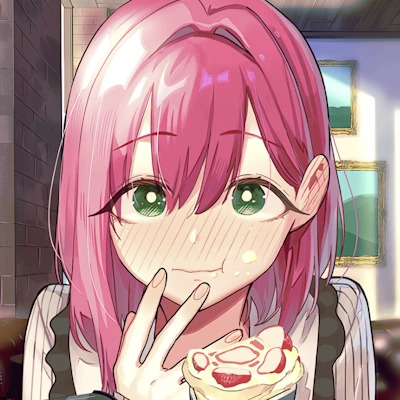
Hanazono Hakari - "Hana" means "flower" or "blossom" and "zono" means "garden". Her surname is a reference to the expression "Atama ga Ohanabatake," literally meaning, "flower garden in the head." This phrase is used to describe someone who is constantly delusional and imaginative, referring to her lustful daydreams and delusions along with the flower-shaped hairpins that she wears as a part of her character design. "Hakari" is also a homophone for "plan," highlighting her devious nature and scheming brain.

Inda Karane - Karane's full name is derived from a highly typical Japanese tsundere sentence "betsu ni anta no tame ni yattenain dakarane!" ("It's not like I did it for you or anything!") The "In" in "Inda" also means "hospital" which is where she keeps sending Rentarou.
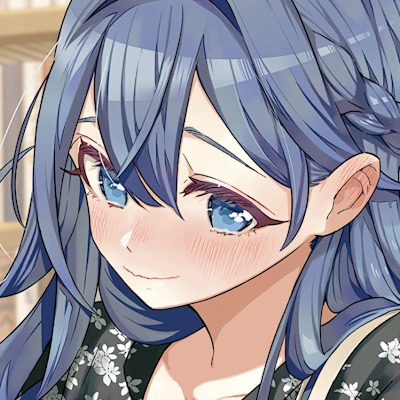
Yoshimoto Shizuka - Yoshimoto can translate to "Lover of Books" and "Shizuka" literally means "quiet."
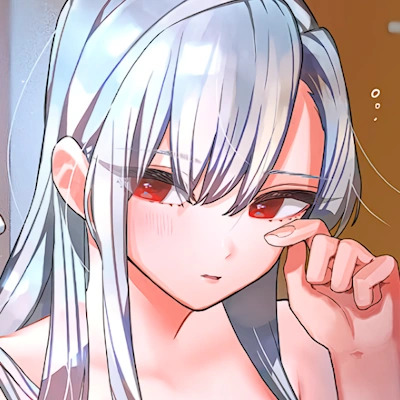
Eiai Nano - "Eiai" is derived from "A.I." and "Nano" is derived from "Nanotechnology," alluding to her straightfoward, computer-like intellect and mechanistic demeanor.
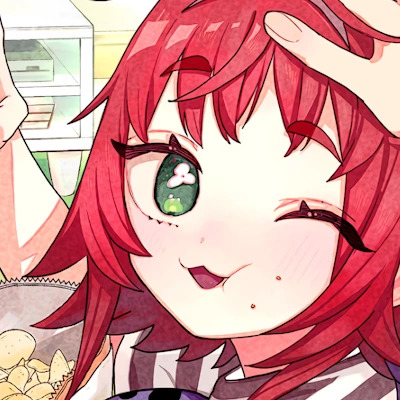
Yakuzen Kusuri - "Yakuzen" means "medicinal cooking" in literal translation, while "Kusuri" is a homophone for the Japanese word for drug or medicine.

Hanazono Hahari - Her name is the same meaning as Hakari's, fitting since she is also very deluded. Hahari also contains the word "Haha," which also means "mother."

Haraga Kurumi - The "Hara" in "Haraga" means stomach, referring to Kurumi's incredible appitite.

Meido Mei - "Meido" literally means "Maid"

Sutou Iku - Iku's full name is pronounced similarly to the Japanese word "sutoikku", meaning "stoic", as a testament to her high pain threshold.
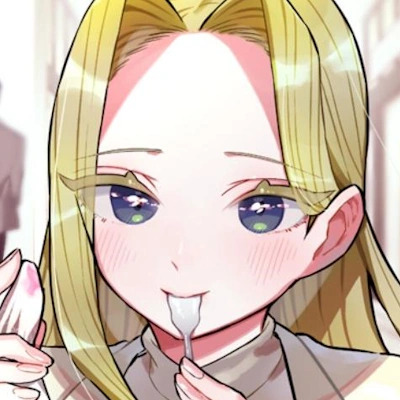
Utsukushisugi Mimimi - "Utsukushi" means "Beauty or Beautiful" Additionally, "Mimimi" has the kanji for "Beauty or Beautiful" twice, and employs the noma kanji, which repeats the kanji that comes before it. In her full name, the word "Beauty" is written in Kanji three times, and her family name and given name are pronounced in On'yomi and Kun'yomi, respectively. There are technically four counts if the Noma Kanji is counted. Therefore, her name can be interpreted as meaning "extremely beautiful."

Kakure Meme - "Kakure" means "to hide", and the "Me" in "Meme" means "eye," so her full name effectively means "two hidden eyes." The "Ka" in "Kakure" can also mean "splendor or flashiness" referring to the beuatiful face that she keeps hidden under her bangs as to not draw attention to herself.

Iin Chiyo - Highlighting Chiyo's position at her school, her full name written in hiragana strongly resembles the second half of the Japanese word for "class president," - "gakkyuu iinchou." "Chiyo" also has the kanji for "award" and "wisdom," and "Iin" has the kanji for "school" or "institution."
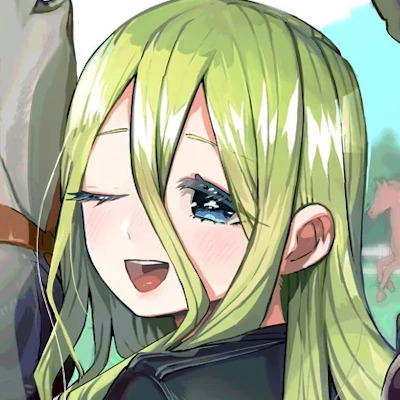
Yamato Nadeshiko - The phrase "yamato nadeshiko," describes the "personification of the idealized Japanese woman." Typically, a yamato nadeshiko is modest and courteous, with long, dark hair that is frequently styled nicely. They wear traditional Japanese attire, and they resemble the kind of woman Naddy's family attempted to turn her into before she rebelled and became obsessed with America. "Yamato" is a term for ancient Japan, and a Nadeshiko is a kind of pink carnation whose name translates to "Japanese Dianthus"
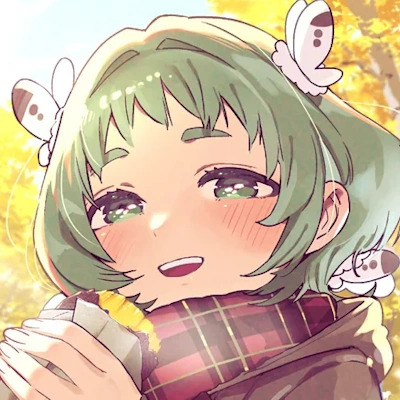
Yasashiki Yamame - "Yasa" means "gentle" or "affectionate", and "shiki" means "spreading" or "laying out" like one would do with seeds in a field. "Sashiki" spelled in a different kanji also means "cutting and planting." "Yamame" can literally be translated to mean "Mountain Woman" referring to Yamame's large size, but "mame" can also mean "hardworking" or "healthy" and "legume" which means "vegetable."
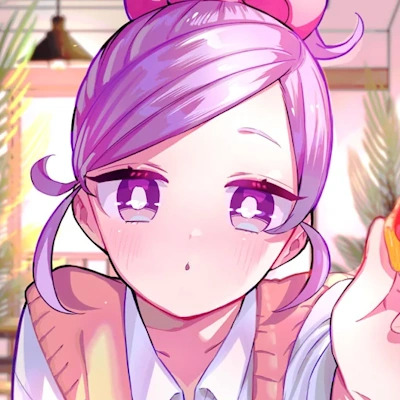
Momi Momiji - "Momimomi" is an informal way of saying squeeze or massage. "Momu" also means "to massage."
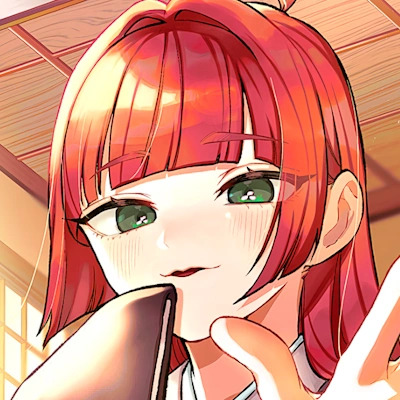
Yakuzen Yaku - Like Kusuri, the word "yakuzen" literally means "medicinal cooking," and her first name contains the same word, albeit written in a different kanji. Kusuri even mentions this in the manga directly, to which Yaku responds that her mother named her after her favourite tree, Yakusugi Cedars. Furthermore, when written using the Goroawase wordplay system, Yaku can be written with the numbers 8 and 9 ("Ya" and "Ku"), referring to how she is 89 years old.

Torotoro Kishika - "Torotoro" is a Japanese onomatopoeia that describes something becoming loose and viscous, which refers to the state Kishika enters when she is babied. Kishika also directly translates to "Flower Knight"

Kedarui Aashii - "Kedarui" means languid, listless or feeling sluggish and "Ashi" a slang version of the pronoun, "atashi" often used by gals. Beyond just Japanese, Aashi means "smile" in Hindi, which makes sense given the constant smile she bears on her face.

Nakaji Uto - The kanji for Nakaji is also used in the word "Chuunibyou," a colloquial term from Japan used to characterize early teens with grandiose delusions, a strong desire to stand out, and the conviction that they possess knowledge or secret hidden powers, i.e. exactly what Uto is. "Uto" is also an alternative interpretation of the kanj "shijin," which translates to "poet."
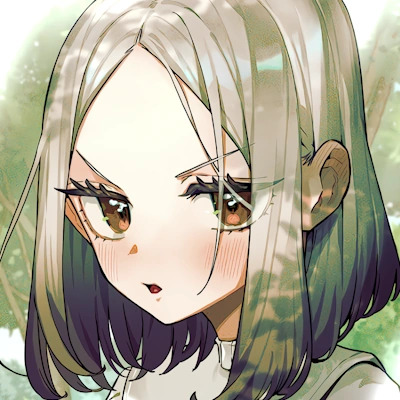
Meido Mai - Similar to Mei, Mai's surname, "Meido" is pronounced in Japanese similarly to how "maid" is. However, it is spelled with the wrong kanji, which could highlight how Mai is an inexperienced maid in comparison to the perfect maid that is Mei. "Mai" can also mean "little sister."
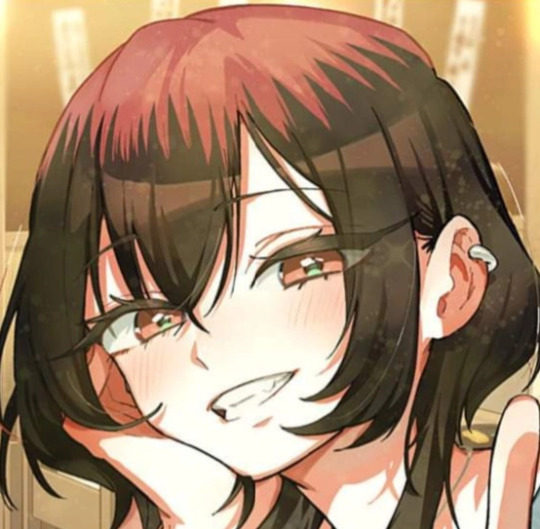
Bonnouji Momoha - The "Bonnou" in Bonnouji means "worldly desires," and "Momoha" means "108" referencing the 108 worldly desires of Buddhist terminology.
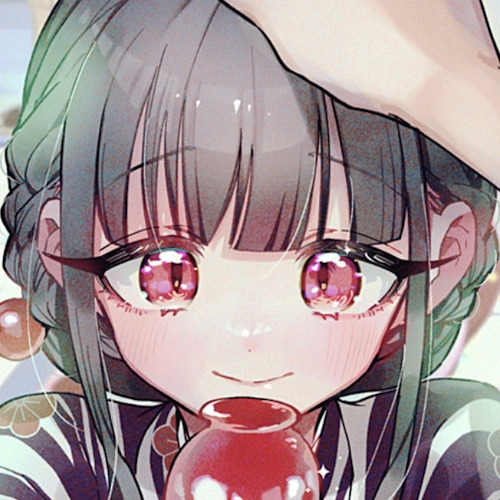
Baio Rin - Her full name is a pun on how the word for "violin" is pronounced in Japanese, but also sounds like the world "violent" or "violence." Her name is also a reference to "Biohazard" the Japanese name of the violent horror shooter game series, Resident Evil.

Hifumi Suu - "Hi Fu Mi" literally means "1 2 3" in the Goroawase wordplay system. Suu also means "number."
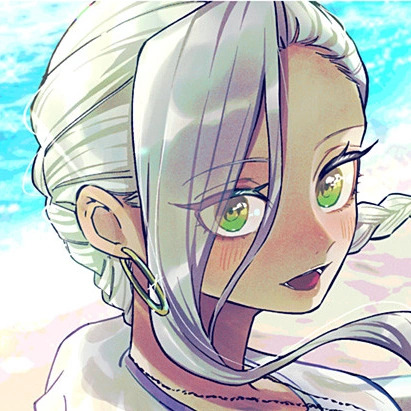
Kaho Eira - Kaho's name is a pun on "Capoeira" the style of Brazilian martial arts that she practices.

Nekonari Tama - Nekonari contains the kanji "Neko" and "Naru", which when put together means "to become a cat." Tama means "beads" but is also a homophone for "ball" referring to how cats like playing with balls of yarn.
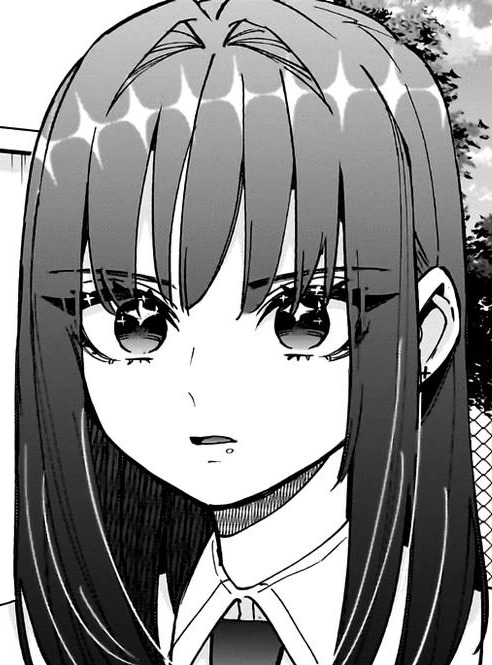
Saiki Himeka - "Sai" means "talent," "ki" means "strange." "Hime" means "princess" and ""ka" means "song." Himeka uses the first kanji of her first name and the second kanji of her last name for her stage name, "Kiki," literally translating to "weird princess" or "strange princess."
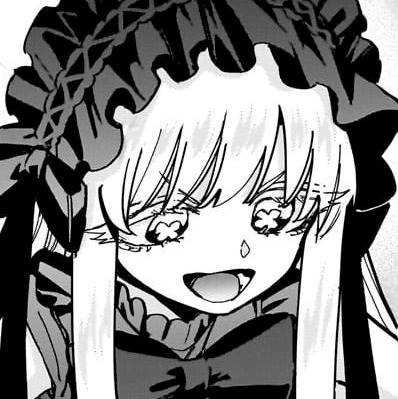
Dei Matsuri - "Matsuri" literally means "festival," and "Dei" is derived from the ending particle of Edo dialect speech. "Dei" effectively replaces the standard ending particles "desu" and "da," emphasizing Dei's cockney English dialect.

Usami Shiina - Usami is a short abbreviation of "Usagi no Mimi", which means "bunny ears." Additionally, her full name is a pun on "Ū samishī na" which means "Ugh, I'm so lonely," naturally referring to how Shiina is unable to engage in solo activities due to her autophobia
#the 100 girlfriends who really really really really really love you#kimi no koto ga daidaidaidaidaisuki na 100 nin no kanojo#aijou rentarou#hakari hanazono#inda karane#shizuka yoshimoto#nano eiai#kusuri yakuzen#hahari hanazono#kurumi haraga#mei meido#iku sutou#mimimi utsukushisugi#meme kakure#chiyo iin#yamato nadeshiko#yamame yasashiki#momiji momi#yaku yakuzen#kishika torotoro#kedarui aashii#uto nakaji#mai meido#momoha bonnouji#rin baio#suu hifumi#eira kaho#tama nekonari#himeka saiki#matsuri dei
101 notes
·
View notes
Text
ok I’m talking about this now just to get my own thoughts on it out there and bc i haven’t seen anyone else do it and if itll drive me up the walls if I don’t say anything. Anyway.
I really like the way Mizu’s gender is presented. I personally use he and they interchangeably, but I do actually feel like Mizu is the kind of character where having to use pronouns for the character at all is kind of….undermining him? does that make any sense?? obviously you have to but I’ve found myself using Mizu’s name a lot when talking abt them because of it. There is SO many different ways you can interpret Mizu, but to mizu himself you can see that they don’t care if people see them as a man Or a woman. When Ringo sees that Mizu isn’t “really” a man, he keeps using he/him for Mizu and referring to them as a man, and Mizu doesn’t correct this. At the same time, you can kind of see that Mizu was coerced into a life of masculinity that he seems uncomfortable with at first, but he grows into it. when the people in the picture encouraging or forcing him to live that way are gone, he continues to do so regardless. This could be taken either as him having grown comfortable with the way he presents, or continuing to live as a man because otherwise, despite his competence, they also firmly believe that women have very little options in Edo era Japan, and thusly his mission would be severely hindered. Honestly it’s so fascinating and I really like the way it’s done and all the different ways it could be taken!!
#speaking as someone who is transgender btw#but if you have any thoughts about this please please tell me I would love to chitchat about it#Blue eye samurai#I am only at the mere beginning of understanding gender.
240 notes
·
View notes
Note
To add onto Anons before me I’ve noticed that whenever misogyny is brought up in the PJSK fandom the people talking about it always specifically refer to L/N, MMJ and even N25. Which.
Actually I think we should talk about Emu Nene An and Kohane more. They face SO much misogyny. Constantly. And nobody even mentions them in discussions about misogyny BECAUSE of said misogyny. Literally every single time an Emunene or Anhane song comes out people call it bad or say it should’ve gone to someone else. Every time. Without fail. It gets ignored at best outright hated at worst.
Ok so thought experiment time. Name a popular Emunene or Anhane song that’s as beloved or gets as much attention as Aun no Beats and Fixer.
If you couldn’t name one - that isn’t even because they don’t have bangers people just don’t like women unless they’re standing right next to men. Anhane alone has Imperial Girl and Odo and Pheles and Love is War and the Night Sky Patrol of Tomorrow and Butterfly on your Right Shoulder archives and you’re telling me that none of those are “good enough”????? Idk I think that’s just bias. Ruikasa and Akitoya songs have gotten popular with worse. Anhane and Emunene could drop the most jaw dropping gorgeous songs ever and not a single person would care and I firmly believe and will stand by that statement.
This isn’t even getting into how they’re treated in group covers!!!!!! Everybody ignores or hates on them!!!! If people feel like they got even slightly more lines than Ruikasa or Akitoya, even in their *own focus songs* (cough forward cough) they get so upset. And yet when Anhane and Emunene get the EXACT same treatment in Ruikasa or Akitoya songs nobody says a single thing!!!
And that’s not just speculation I KNOW that’s the case I can literally prove it. An has three total solo lines in the entirety of blender. That’s the exact same amount of solo lines as Toya gets in Ready Steady. They pretty much have the exact same amount of duet lines as well. In both songs. But Ready Steady is infamous and hated for it whereas blender nobody has even pointed this out and it’s universally beloved. It’s not even just a “blender is a focus song” thing because this happened with Forward too. It’s just misogyny.
I’ve seen people complain about Daybreak Frontline. Because and I quote “I hate it when the girls get most of the lines”. I can’t even go into any of the Nene or Emu tags without filtering every single Tsukasa and Rui tag first and even then finding any sort of content is almost impossible I think that’s a problem.
People will call Kohane “just a girl” despite the fact that she has a solid character arc and a personality and development. You can think she’s boring or not for you but????????? Don’t call her “just a girl”????? Esp not when she has social difficulties that are intentionally supposed to be relatable to the audience. A lot of people might actually relate to her character and journey even if they don’t necessarily like her. Idk leaves a bad taste in my mouth.
An has it only SLIGHTLY better because there’s a niche little fanbase for her and she’s somewhat popular (in the western fanbase. I think Kohane is more popular in Japan iirc.) but she still gets treated as an accessory to Akito and Toya just like Kohane. Also people keep trying to be weird and frame her as abusive or toxic which. Considering that possibility isn’t like a bad thing but people are just straight up reaching to try to prove stuff that either isn’t implied at any point or is outright refuted in the text just to villainize her??? Which is weird??? Especially because these people will turn around and defend Rui and Akito. Like. What did she ever do to you….. you’re willing to defend Rui who has canonically put people in mortal danger because teehee autism (I am autistic FYI I still think that’s a really stupid thing to use as justification especially if he’s aware it’s dangerous????) but An. Just existing with her fear of abandonment was too much??????
I could go ON and on and on there are so many examples….. help me……… help me anons…..
It’s not even that liking Akito and Toya or Rui and Tsukasa is inherently bad!!!!! But the favoritism as a whole is…….. something. Especially when it turns into hating the fem characters.
Also Mizuki suffers this too with Rui as another anon mentioned and it’s like. Really guys. Like first off it’s not about him it’s about Mizuki and if you’re gonna involve anyone else it should be the Nightcord girlies. Second off It’s a double whammy because people will bring up Rui but make no mention of An despite the fact that An is the one who’s canonically defended Mizuki from transphobes. Like. Why only Rui.
(I tried to word this as neutrally as possible I hope it didn’t come off as too aggressive ausuxuvhxhgxhgshg…. Anyways….. introspection and growth is good and cool actually…. Also I’m using Anhane and Emunene and Akitoya and Ruikasa for ease of use not as like a ship thing just to clarify it’s just tiring typing out each name individually)
.
#pjsk#project sekai#prsk#fandom take#an take#kohane take#emu take#nene take#an shiraishi#kohane azusawa#emu ootori#nene kusanagi#event take#song take
44 notes
·
View notes
Text
Chapter 52 Hype Posting
Hi void. I am going to vibrate out of my seat. Oh I'm going feral, absolutely feral. Another WSJ cover and lead colour page next week already! Promotion on TV during prime-time in Japan! The insanely good volume 4 PV! Hokazono-sensei judging for a manga award! Kagurabachi's getting the push to be the Next Big Thing at last- you love to see it.
Kind of.
I want Hokazono-sensei to get all the recognition he deserves, but I also don't want the fandom to explode and become yet another annoying dudebro space. The success of the series is more important though, so I'm happy to see Kagurabachi get so much support. Everyone needs to know about this manga! ANYWAY.
LOOK AT THIS TROLL.
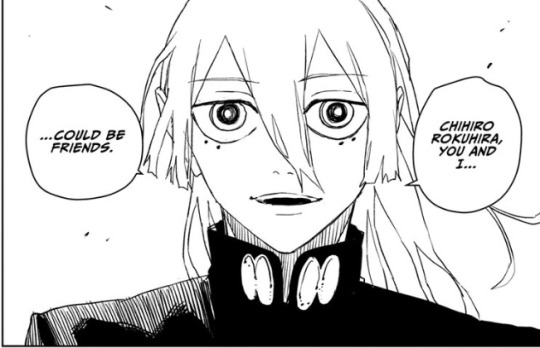
It's Chihiro's turn to have a creepy parasocial admirer now.
Hiruhiko's not doing this just for kicks, however- he deliberately (and successfully) triggered Chihiro to orchestrate his dramatic fall. Given what happened at the end of this chapter, I would not be surprised if Chihiro's literal descent is foreshadowing a metaphorical one of some kind down the line.
And this just breaks my heart:

Triggers Chihiro's rage then fucks off only to do this? I will not be mourning Hiruhiko's death.
Chihiro's not built for being a murder bot and it pains him so much to be seen as equivalent to someone like Hiruhiko. But he was taught to see things through and uses his hatred for the Hishaku to keep going. Revenge is probably the only thing he wakes up every day for- he wasn't kidding about that "fresh hatred" line in chapter 1. And neither was Shiba when he said living like this would break him. This kid needs a hug and a safe place to cry out the pain so badly, man...
More than that, though... more than anything...
HIRUHIKO'S THE FUCKIN' ANTI-HAKURI.
"We're equals", he says. "I killed my family", he mentions. "Let's be friends," he asks as he forces his way into Chihiro's life. "I'm the only one who can understand you." The hell you aren't you rat bastard. Hakuri's the one whose soul resonates with Chihiro's. He's the one Chihiro acknowledged as an equal and a friend. BEGONE, FOUL DEMON.
God damn it. Hokazono, I love you for making my most hated villain archetype into a character I want to see more of. I've never understood why playful psychopaths are so beloved but I get it with this guy. Smooth move making him the evil version of my favourite character in all of fiction, Mr. Author. Now I need Hiruhiko and Hakuri to face off over their ideals about who Chihiro really is. It would be the perfect reprise to the Sojo arc! PLEEEEEEASE. There's so much HakuHiro potential in this setup... Hakuri being the one to pull Chihiro forward again would be amazing. But not for his own goals this time- just to help Chihiro as a true friend and partner. Not gonna get too attached to this since it's just one potential development out of many... I won't let myself... (too late).
(Psst... 昼チ or 昼チヒ will probably be the JP ship tag/name for Hiruhiko/Chihiro. Ain't no way Chihiro is the top in this pair for most Japanese fujin lol.)
The Show
The main character of the play's name is Sasuke and Hokazono-sensei is a huge Naruto fan. So much so that he's taken his own spin on Naruto and Sasuke three times now (Enten, Roku no Meiyaku, Kagurabachi). Chihiro is, in fact, his OC donut steel character inspired by the most annoying emo ninja boy ever. I see you, Hokazono-sensei.
The Battle of Soshima might be a made-up title to reference the real historical event The Battle of Tsushima, which fellow Golden Kamuy fans will recognize. At any rate, there aren't any famous Japanese stage plays with the same name, so there's no direct narrative parallels to draw insight from (sad trombone noises). Fortunately for us Hiruhiko is a yapper like I hoped and tells us the plan pretty plainly anyway:
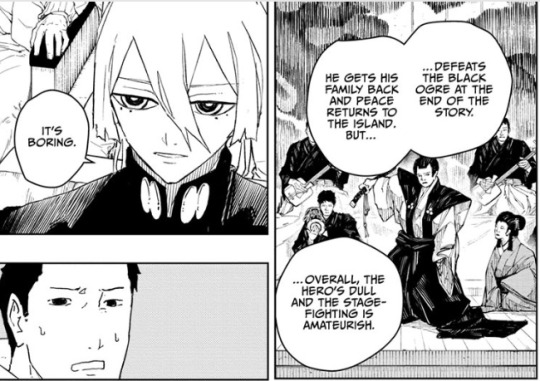
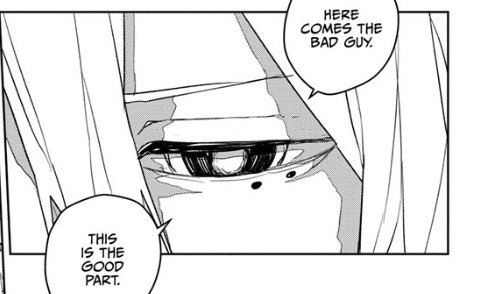
I relate so hard right now, random audience guy.
Hiruhiko says the plan to kill Chihiro's not a bluff. But he's not acting like he's intends to make good on that statement. So that means...
Perception vs Intent

Chihiro looking his best: stressed and menacing
This is gonna be huge I think. Remember what Azami said back in the Sojo arc in ch. 9:



Azami, please come back soon. I need you carnally.
Then consider likes like this...
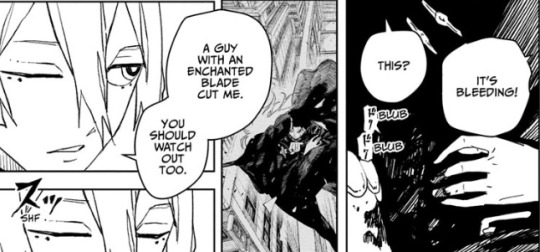
Local violent gang member still pretty tough after becoming human shishkebab through a moving train.
Chihiro could be set up to tarnish his father's legacy.
The public doesn't know the true strength or capabilities of the weapons that won the war- they just know that Rokuhira Kunishige made them and they were the key to winning. So Chihiro dropping in on a stage play to splatter the audience with a headless corpse's blood is not a great first impression. He looks downright villainous in this scene. Awesome, but villainous.

The Hishaku are going to metaphorically "kill" Chihiro somehow. For some reason, tormenting this poor guy is absolutely vital to John's plans... it's probably more along the lines of Chihiro being a useful pawn to move around to create conflict they can exploit, but still. They're going to try to break his spirit this arc for sure. Leave Chihiro alone! He's been through enough!
I've got a hell of a lot to say about this but I need some key details from the next few chapters before going off on lunatic tangents. Fuckin' hell though, this is great. This is exactly the type of development I was hoping we'd see after Samura's chapter. Chihiro's committed to the cause of killing the Hishaku, who so far have been wholly unsympathetic villains. But killing is a wrongful act. And this chapter sets up that Chihiro might not be the sympathetic avenging swordsman we love him as in the eyes of the public- he appears to be more of a menace like some of the members of the Kamunabi accused him of. He might be challenged on his murderous modus operandi via a Hishaku-backed smear campaign. Seriously, using Chihiro's brutality against them to ruin his father's legacy would be so evil and cruel. I love it.
We'll be able to count on Shiba and Hakuri to make sure Chihiro doesn't go off the deep end at least. I wouldn't be surprised if Hiyuki played a pivotal role in helping Chihiro out this arc too, but I don't want to commit when we've hardly seen anything of her so far (my spaghetti sovereign... please come back to the main story full-time soon).
Whether or not I'm right (I'm not, I never am), Chihiro's murder sprees fueled by Fresh Hatred are going to get looked at in a critical way. High time and I am definitely here for it. Tell me what you've got to say about violent revenge motivated by grief, Hokazono-sensei. You have more space to examine the topic now compared to Farewell! Cherry Boy.
Shorter than usual but that's not a bad thing. I can always come back and edit this (came back to do so twice now already) or make another addendum post, but...
... Just choose kindness, people. For yourself and others. See you later.
#kagurabachi#I told you I'd yap about Hakuri no matter how small his appearances are (he doesn't even have to show up)#Hiyuki also appeared this chapter yay#Chihiro looks AMAZING this chapter I can't get over it
35 notes
·
View notes
Text
MIZUKI IS NOT CIS!!! (I made this for myself)
I just need to keep track of my brain
So, Mizuki is definitely not cis. We've all heard of it. I'm just gonna bring up some reasons why.


First of all, Mizuki's chest in their 3D model is much flatter compared to the other female in the game. Don't get me wrong, you can be a flat woman. However, with all the context we have about Mizuki, I think in their case, it has to do with their biological sex.


They also often use butterflies or flowers in Mizuki's event name thingies. Butterflies and flowers often represent change. Which can add to the change in gender


Mizuki's models when they were younger appear more androgynous or masculine. This was probably due to the peer pressure of to be a boy since it's probably their biological sex.

Also in the Kamiko festival event Mizuki doesn't change due to there being no privacy. A problem most trans people deal with is restrooms or changing rooms. Most of the time they have to go to their biological sex which is bad on their part since to them if makes them feel weird. So though Mizuki definitely passes as a girl they would still have to go to their biological sex, which makes them feel uncomfortable.

Also Mizuki's sex is stated as "?" In the official website. Which give us more of the feeling about their gender and how they're not cisgender.

Another point I'd like to add is that femininity is actually very important in Japan. Looking cute is important to woman in Japan since it's their standard. So being judged for wearing cute clothes would only apply of you're of the male sex. So being judged for this if they were female would be very odd.
Also Mizuki used the Boku pronoun which is often more masculine. However, it can be a more cutesy way too to refer to yourself. Also tomboys use to but Mizuki definitely isn't a tomboy. In recent events they started to use Atashi more which is more gender neutral but still more feminine. Japanese pronouns work differently from English ones so keep that in mind.
Also, about the crossdressing Mizuki theory. Crossdressing is more normalized in Japan so why would Mizuki take is so far just to hide their secret? If they were a crossdresser then they might feel happy about passing but in the end still identify as a boy. Wouldn't they correct Niigo when they use she/her pronouns of then? There's just weak evidence to show how they can be a crossdrssser.
Anyways, so what's Mizuki? Mizu5 is coming so we'll know soon but for now I think they're transfem. Transfem is when you identify with femininity. Not the same as transgender but that's not off the table either. Maybe non-binary or a non-binary gender identity but who knows? We'll find out soon!

#hatsune miku colorful stage#vocaloid#pjsekai#pjsk#project sekai#proseka#n25 mizuki#pjsk mizuki#mizuki pjsk#mizuki akiyama#akiyama mizuki#N25#Niigo#25 ji nightcord de#nightcord at 25:00#Trans#Rant
41 notes
·
View notes
Text
Thoughts on Season 1 of Suits:Japan




I finished the first season of the Japanese adaptation of Suits (conveniently titled スーツ which is just a transliteration) I was actually really surprised by how faithful it tried to be, to the point where whole chunks of dialogue are taken from the original and even certain stylistic elements of the sets are copied.
But Japanese society is both more conservative and much more patriarchal than American society, not to mention Japan is a completely different country with different laws and different institutional structures. It would be impossible for them to translate the American series without any changes. Most of the storylines wouldn't make sense set in Japan exactly like they are in the original. It was interesting to see what they changed and what they kept.
(I'll be referring to the characters by their original names to keep it from being confusing but, yes, all the characters actually have Japanese names)
They made a lot of little changes to make Mike more palatable to a Japanese audience. He no longer smokes pot so all the drug-related storylines were either adjusted to make Mike unaware of the drug element, or changed to alcohol instead. Jenny is not Trevor's girlfriend in this version, she's his little sister. When Trevor betrays Mike to Jessica, it's not because he caught Mike sleeping with his girlfriend but because Mike has broken his little sister's heart by liking someone else. Since Mike never sees her as more than a little sister, the love triangle between Mike-Jenny-Rachel is maintained but does not complicate Mike's "nice guy" image. Instead of Mike flipping between his affection and attraction to both girls, Jenny essentially casts herself as Mike's pseudo-housewife--cooking him dinner when he comes home and checking in on Grammy--and Mike just accepts this without reciprocating any romantic feelings. Mike seems oblivious to the context of allowing his "childhood friend" to essentially play his wife and it's only after he corrects several people who refer to Jenny as his girlfriend that he decides to clarify his non-feelings with Jenny.
Across the board, a lot of the romantic and sexual content of the show is removed. Scottie is swapped out completely for a minor male character they used in another plotline. And then fake!Scottie is himself swapped out for Robert Zane, who is styled as a much more traditional villain with much stronger loyalty to Hardman whereas in the American version he was definitely more neutral. The character who shows up originally as the Japanese version of Vivian Tanaka at times fills in for Scottie, Alison Holt, and Zoey in scenes. Her relationship with Harvey is a bit flirtatious but not at all sexual.
In fact, Harvey has basically no personal life at all. We get one classic Harvey Specter man-slut scene where he's in a tuxedo taking a beautiful woman to the Phantom of the Opera only to ditch her for work. But immediately we find out that it actually wasn't a date at all, he asked her out to set her up in order to help a client.
Donna is basically just Harvey's secretary. They don't have much notable banter, there is no can opener (they do have this weird thing with gum but it's not a pre-trial ritual or anything) Although she does what she does against Cameron, it's not portrayed as anything other than normal loyalty.
The closest thing Harvey has to sexual tension is with Jessica ... but not the way he does in the original. They made Harvey ten years older, so the mentor-mentee relationship between him and Jessica is gone. The actors are about the same age!
They cut basically all the associates' storylines 😭 I mean those were some of the best/funniest interludes in the original. No rookie dinner, no Bainbridge briefs, there is a Harvard quiz but Mike loses (not sure why they changed that) This means Mike and Rachel do not actually interact that often, despite Rachel still being the primary love interest. And just like they toned Mike down, they toned Rachel way waaaaaaayyy down. She's a classic good girl, a bit robotic and drone like in her seriousness.
But they kept many of the cases! Even cases that seemed like they could not work outside of a NYC setting like Harvey defending Ray post-traffic accident. They make a lot of cosmetic changes--McKernon Motors is changed to a luxury watchmaker--but nothing so severe that you do not recognize the original immediately.
On the other hand, there are some changes that would make fanfic readers nod their heads in approval: Mike buys the suits from Rene (and charges them to Harvey's account), Harvey pays for Mike to get a new apartment, when Harvey asks Mike how he took tests for female customers in his cheating side hustle Mike tells Harvey that sometimes he dresses up like a girl. And ... Harvey might have sent Mike to Harvard Law in the end? It's a little vague ... In the last episode Harvey hands Mike a ticket to Boston and a check for some absurdly large sum of money and tells him he has two years, go have some fun. Mike responds "I'll only need one year" (although Harvard Law is a three year program so fuck both of you)
Conclusion, is this worth tracking down and watching? Mmmm... depends, if you're a fan of J-dramas and love Suits you will probably be amused by how familiar characters and stories pop up. But to be honest, one of the things that made the show so compelling to me was the moral ambiguity of the main characters. It's a show about corporate lawyers, people typically portrayed as villains or henchmen are in fact our heroes and people who want to follow the law tend to be villains unless they get with the program and start enabling the Harvey Specter's Fantastic Crime Wave (Sean Cahill, we're looking at you)
21 notes
·
View notes
Note
Hello! Love your ogre research, first of all. So something weird here, in my English translation of Ariosto the monster that threatens Angelica (the orca) is translated as “sea orc”, and the blind ogre who acts like Polyphemus (the orco) is translated as “land orc”. (And by extension “sea orc” evolved into a dragony thing in some modern fantasy books). Any idea why that happened instead of just calling them “orca” and “ogre” or something?
Ah yes the Orlando Furioso. I meant to include this in my big "What makes an ogre" series but never got the time.
So... I have to admit I am not an expert on Italian language, especially old fashioned Italian language, and I also am no expert on the full Orlando Furioso (it is a very complex work I only got started on recently). But here's the thing...
It is well-known that the Orlando Furioso was put together by taking elements of Greco-Roman mythology and reinventing them completely. The Orco and Orca are this. The Orco is basically Polyphemus reinvented - but here with two eyeballs made of bone instead of one eye promptly gouged out. The Orca meanwhile is the sea-dragon of the Andromeda story given a new name. So far so good.
But "Orca" is not meant to evoke the sea animal of the same name, the "killer whale", and that's something everybody has to remind people of (even the Wikipedia article for the Orca in Italian points out it is NOT the "orca" as in the sea creature). Orca is used here as the male form of "orco" - and the "orco" is indeed the same name of creature used by Basile to designate his proto-ogres. The "uercos", which is just "orcos" spelled differently.
So should we translated "Orco" as "ogre" and "Orca" as "ogress"? Well... No, it wouldn't work. At least for the Orco it can work since he sports typical ogre traits and DID influence the rise of the ogre figure in France (I don't think it is a random choice if madame d'Aulnoy's ogres are cyclops). But the Orca clearly isn't the same kind of creature - it is a sea dragon, or a sea monster, or some big sea snake. So this hints at the fact that "orco/orca" doesn't actually translated, in the context of the Orlando, as "ogre"...
You see, by Basile's Pentamerone, the "orco" is clearly an "ogre" in the fairytale sense of the word - though some English translators decided to go for "ghoul" because they didn't understand why an ogre would have magical powers, unaware that ogres were originally sorcerers/fairies of their own rights. They preferred to evoke the shapeshifting Arabian demons, allowing for an easier explanation of "Oh yes the ogre turns into all sorts of animals and curses people when it can't eat them".
[Note: As I write this I realized "orchi" is apparently the plural of "orco"? Well... I'll keep calling them "orcos" for now, but another proof I am not expert when it comes to these things]
But the author of the Orlando Furioso seems to have had a different and more ancient meaning in head for "orco". If you ask me, what seems very likely (though I am no expert) is that "orco"/"orca" is here taken as meaning "man-eating monster". Not just a fairytale ogre, but any kind of creature that wants to devour human beings. As a result the "orco" is an ogre-like giant, while the orca is a sea monster-dragon. "Orco/a" is used in the same broad sense as how "fairy" could be used in the British Isles to refer to all sorts of creatures, or yokai in Japan - or at least, that's what it seems to me. This is probably why the translator chose to prefer the term "orc", more neutral and evoking the older roots and mysterious figures behind the word "orc" before Tolkien made it famous. Calling the sea creature "orca" feeds the confusion with the killer whale ; while calling the land monster "ogre" might remove the idea that he is another form of the sea creature met earlier. One could keep the cohesion by having "ogre / ogress" but it would be mistranslating to call the sea monster "ogress" when it is clearly not just a female version of the land creature. So ultimately I think this is why the terms "sea orc" and "land orc" were chosen - it keeps the unity, while pointing out that the term does not designate a specific type of being, more a large class of man-eating beings. You could easily go with "sea monster" and "land monster" too.
At least that's how I perceive things - but again I am NO expert and any actual Italian insight on this topic would be more than welcome.
124 notes
·
View notes
Text
IN THE SPOTLIGHT; First selection; chapter 2: the fire inside of you
Blue Lock x transmasc!reader; reader is referred to with fem terms and pronouns until he realizes he's trans; reader's last name is Hoshino; series masterlist
Blue Lock, block five. Team Z vs Team X.
Chaos. That's the only word on your mind as you watch turmoil unfolding on the field just moments after kickoff. Everyone is yelling at each other and nobody stands on the position that was assigned to them. Including you.
Because you were the one who started it. You were the first one who decided to ignore the positions you and your teammates agreed on. You were the one who stole the ball from your team's striker. You were the one who immediately decided to not give a damn about being a midfielder, even if it was for only this one game.
There is no way in hell you'd play any position you weren't made for.
Despite being surrounded by your own teammates and the opposing players, and all of them trying to steal the ball from you, you somehow outsmart them and begin dribbling to the goal.
You're about to shoot when a voice you don't recognize yells from behind you. "I'm not letting a girl shoot the first goal!"
You can't help but let out a laugh as you get ready to make your first goal. "Hah, keep dreaming!"
Maybe you shouldn't have let yourself get distracted. Maybe you shouldn't have listened to that comment. Maybe you shouldn't have responded.
Maybe you should have focused on shooting the ball.
Barou was quick enough to steal it, thanks to you taking only a few seconds locker to position yourself properly in front of the goal.
The chaos on the field continues. It's no longer the kind of chaos you can control. As much as you try, you can't get the ball anymore. Team X is dominating this game with Barou shooting goal after goal and the rest of his team adapting to his way of playing.
If only your team did the same. If they had agreed to make you the center forward and adapted to your style, you would have-
You're thrown out of your thoughts when Isagi and Bachira begin to coorporate. With a few cursewords under your breath you decide to join them. This might end up convincing them that you'll be the one to lead Team Z to victory.
The match continues. There isn't enough time left for you to win, but you agreed with Isagi's idea of shooting at least one goal to establish some sense of teamwork.
The match still resulted in a 5:2 and Team Z lost. That was inevitable.
Kunigami shot the first goal after Isagi passed to him, and you shot the second goal after Bachira dribbled all the way towards the goal but suddenly got surrounded by opponents. Luckily, you were in the perfect position to receive a pass and shoot another goal.
But still, you lost. A feeling you haven't known in ages.
Japan's Supernova lost.
"Listen here, Superloser", Barou hovers above you, his height only making him more intimidating to you sitting on the ground as you try to catch your breath. "You being the greatest in girls' soccer doesn't mean you have even the slightest chance against me."
You've become used to this already. All you do is stare back at the self-proclaimed "King" as you stand up. A mix of frustration, determination and anger washes over you.
Barou grins and continues in a mocking tone. "What? Too afraid to talk back? If you've got no bite, you're not made to be a striker."
So many things you'd wish to say, but so little coherent thoughts form in your mind. Combined with a pressure in your chest that feels like a spark about to burst into a flame.
This is the final time you'll let someone speak to you like this.
You cross your arms in front of your chest and get a little closer to Barou. "You may call yourself a king, but I've been called Supernova by all of Japan. If it was only you and me without these other idiots on the field, I'd beat you without even trying."
#💟 maochira writes#blue lock#bllk#blue lock x reader#bllk x you#bllk x reader#shouei barou#barou shouei#barou x reader#shouei barou x reader
20 notes
·
View notes
Note
Holy shit Hc's for a Kitsune!reader w kiriko? I think it'd be so funny and cute with how her spirit animal and reader might interact with each other 💀💀
Also hope you're having a good day!
(Might send a crap load of requests cause my brain can't stop coming up with things 😭)
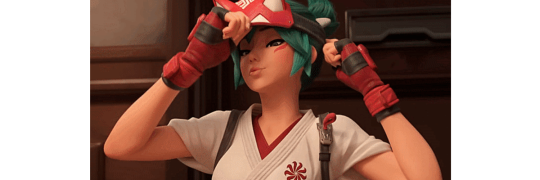
★ O' fox spirit...
Hey !! I love getting requests, and if you're the same anon that requested Genji with a dog!reader, then I'll call you silly animal anon lmao :3 unless if you want to assign yourself w/ a name, that is!
With first impressions, Kiriko would've been pretty pumped about it all!
It wasn't an everyday occurrence that you'd see a yōkai out and about. If you are taking on a human form, then she'd know not to cross with you—not just because of your heritage, but because she knew wise you were! As she has practiced under many ceremonies relating towards the kitsune, she understood the nuances of those mythical creatures; how elegant, yet sly they were with their cunning attitudes.
Kiriko would be very understanding of many things, and would not go around and tell everyone that you were a kitsune—considering her most loyal companion is one, and there'd be no use in letting really anyone know about that without your permission—if you were secretive about it.
She'd love to know how you were doing, and would equally love the chance to strike up some small talk.
The girl would laugh at the silly interactions between you and her companion, always wondering what'll happen next.
Her fox friend would be very interested, I'm sure! I like to imagine that it doesn't appear very often, only in times of need (such as combat) then it'll be summoned. Or, around the comfort of Kiriko and her family. Not everyday you'll see a ghost, eh?
That's how she'd know that you were a kitsune; if you did not have anything outright screaming at her that you were one. If you didn't have the tail(s), ears, or a mask (though, she understood that people may wear them for just apparel), judging by the energy you give off—Kiriko would sense something. Also, it's terribly obvious if her kitsune is also reacting to it, as well.
If you were comfortable with turning into your animal form, she'd then lovingly sigh, as she's crouch down to level the height of the two foxes before her. She'd jokingly chide the two of you to behave; which you two do... sometimes. Causing mischief has never been more fun!
Kiriko would always respect you, and understand if you ever need your time and space. Spirits get busy, and she gets busy—so, it's only fair for her to try her best to ensure that you're okay.
She knows that you can take care of yourself; without needing anyone's help. Judging by your abilities and powers, you were older than the oldest businesses here in Japan that she could think of. If you needed help with anything whatsoever, specifically in reference to adjusting towards human life, she'd do her best!
If you were reluctant with interacting with others, she understands. Humanity is pretty terrifying at times; especially with the Hashimoto now clogging up the streets of Kanezaka. Kiriko would say that, even if those criminal organizations keep up piling on and on, if you were to try and persevere, and focus on the good you're doing now—it's worth it in the end. Even if you just make a few people smile, it's still worth it; even for those few people.
Kiriko would be all up for causing some fun-loving trouble, however, she will back out if things get too dicey. If you wanted to help her with the current yakuza problem, then sure! She'd hate to rope you into something that you may not want to get involved in, so she would want your ultimate consent.
Hanging out with her would be so fun! You're surprised by how she is able to think of so, so many things.
Having trouble with cleaning? She understands! Either that's helping you pick out the best shampoos for your fur, or brushing out and straightening it all—she's got you. Though, be careful about shedding everywhere...
Want to go win some costume contests for Halloween? You guys could go as, well, kitsunes together! Though, Kiriko may say that she'd rather go as something else; knowing she could excell in such a costume, the fox spirit, so she'll dress up as other things—witch, fortune teller, or cosplays from her favourite animes.
All in all, she would adore to have you—even if her hands were already full with her current fox, she's lucky to've been able to meet you.
#overwatch x reader#ow x reader#kiriko x reader#kiriko kamori x reader#kiriko yamagami x reader#x reader#gn reader#gender neutral reader#overwatch headcanons#req#reqs open
79 notes
·
View notes
Note
I have two questions.
1. What is the Youkai Expansion Project?
2. What does Reimu think about it?
in perfect memento in strict sense, our favourite unreliable narrator hieda no akyuu talks about the formation of gensokyo in yukari's article. it's worth noting that it's actually pretty obvious when akyuu is lying, because akyuu lies either as speculation (which she does other times, in obvious ways, in yukari's article) or to keep villagers from knowing how gensokyo works - whereas the explanation provided for the formation of gensokyo in pmiss aligns pretty accurately to others we've seen before and since, and explicitly states that gensokyo was created for youkai. in other words, knowing about the formation of gensokyo isn't something that would threaten the youkai's dominance of gensokyo - bear in mind that pmiss is part of the chronicle, which is (ostensibly) written as a reference for humans.
and the plan to create gensokyo is given a name here, and it's a really interesting one - "妖怪拡張計画", the Youkai Expansion Project. kind of an odd name for a plan to create an isolated little refuge, don't you think?
there's one other time where akyuu really talks about gensokyo and that's in the monologue. she talks about how peaceful gensokyo is, how nice it is that humans (by which she means villagers, because that same chronicle also notes that outsiders absolutely die regularly) don't have their lives threatened by youkai anymore - and then notes something a bit odd.

in the same paragraph, akyuu notes that gensokyo is too small for its youkai population, then basically goes "well, it's probably not worth worrying about, they have the zen nature" in regards to creatures who go out of their way to attack every human unfortunate enough to end up in their path. she simply just... doesn't worry about it. gensokyo will remain as it is, a humble little refuge, forever!
yakumo yukari, foremost of the sages, girl from a dying future, the youkai who invaded the moon, a woman who loves the sounds of the city and hates the tranquillity of a static world, created gensokyo as a place to gather youkai, and she called the plan to do so the Youkai Expansion Project.
the youkai expansion project is pretty simple, and i've talked about the process in specifics before, but basically the idea is that as the population of the outside declines, gensokyo is going to get bigger. the bigger it gets, the more things can't be explained by science, the more people are drawn into gensokyo, and it becomes a self-perpetuating cycle. eventually it's big enough that it takes over all of japan, and from there the entire world. it's literally just Yukari Yakumo's Plan For World Domination
SORRY. THAT WAS A BIG EXPLANATION i kinda wanted to have it all in one place, y'know?
anyway reimu is entirely in favour of it. she has to be, she's the hakurei shrine maiden. she's a core component of the entire thing. she dislikes youkai because it's her role to dislike youkai, kills villagers who become youkai because it's her role to ensure that villagers never strive for anything beyond their meagre humanity - she is all in on the gensokyo con
54 notes
·
View notes
Text
Eijiro Kirishima: Positively Reclaiming National Identity and Making Masculinity More Inclusive (featuring surprise guest Mina Ashido!)
Link to the Bakugo presentation 2.0: Part 1 | Part 2
Link to the Bakugo presentation 1.0: Part 1 | Part 2
Link to the Kirishima presentation 1.0
Link to the Todoroki presentation
Link to the Deku presentation
Link to the Uraraka-Bakugo-Toga presentation
Link to the Shigaraki-All for One presentation
Link to the Spinner-Shigaraki-Bakugo-Deku presentation
Link to the BNHA presentations masterpost
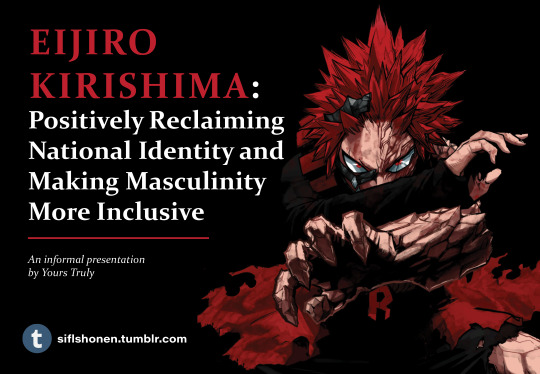
Welcome to the Kirishima presentation 2.0!
What you are about to read combines manga analysis, meta analysis, trope breakdowns, watered-down Japanese history as explained by an outsider Westerner (please take it with a grain of salt), and thematic parallels with other characters. Beware of spoilers up to manga chapter 383.
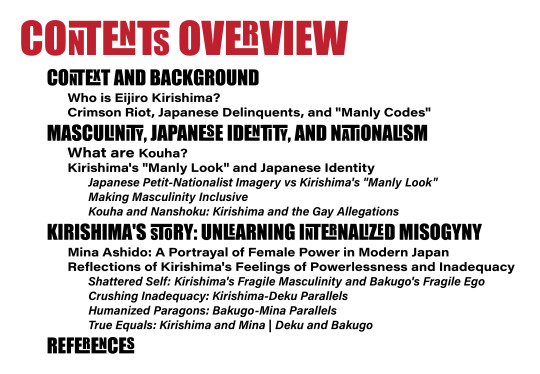
This “presentation” post discusses Eijiro Kirishima’s character and arc as well as the real-life references his character’s aesthetic and “manly” actions and credo are meant to communicate. This post includes a discussion of Japanese delinquents and bosozoku, a brief and simplified history of the relationship of Japanese hypermasculinity and military and naval power, a brief discussion of kouha and nanshoku, and a brief general analysis of how Kirishima's early-series insecurities reflect those of an “emasculated” and outdated Japan in relation to Mina’s “effeminate” Japan of today. It also compares Kirishima and Mina’s history and character growth to Deku and Katsuki. Some of the Wikipedia links are also mildly NSFW, so be careful.
If you take whatever I say about the story personally, or get upset about spoilers that’s on you. On the flip side, if you have something to say on context and history, tell me more! If I offend or misinform in the context of history, please let me know! I have only one perspective, and it is my own.
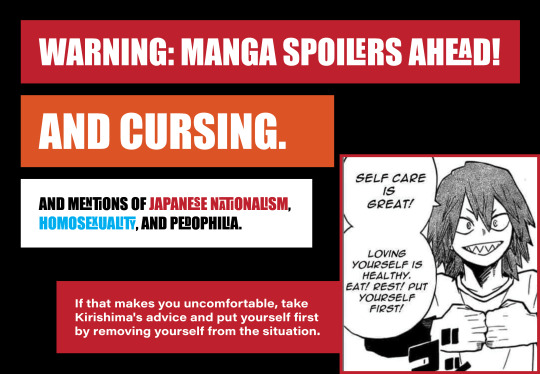
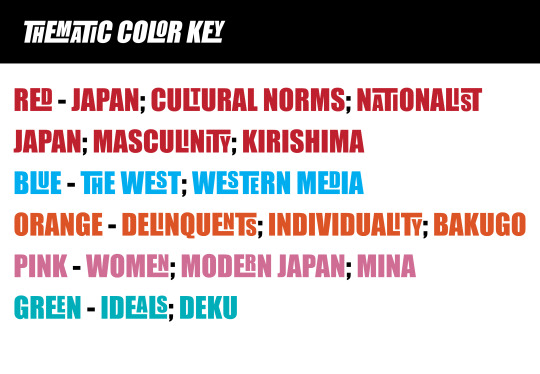
The color key will make sense in time. I promise.
Who Is Eijiro Kirishima?

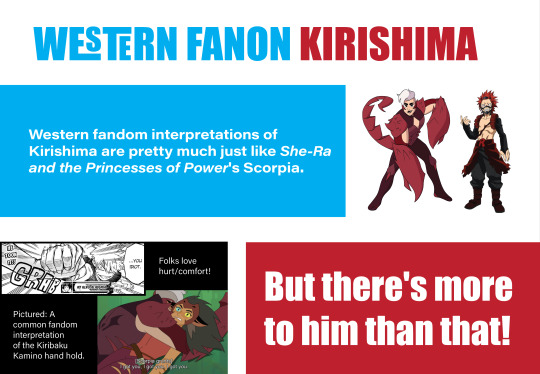
Personally, I love Scorpia. I also love Kirishima. But I do not like it when Kirishima is portrayed to be just like Scorpia in fandom works. Sure, they have similarities (some of which may or may not have been intentionally chosen for Scorpia’s part), but they do not have the same character arcs.
In particular, Kirishima’s arc is very pointedly about his pride and identity as a modern Japanese boy unlearning his internalized toxic masculinity and biases as he grows into a man.
But let’s start with the basics.
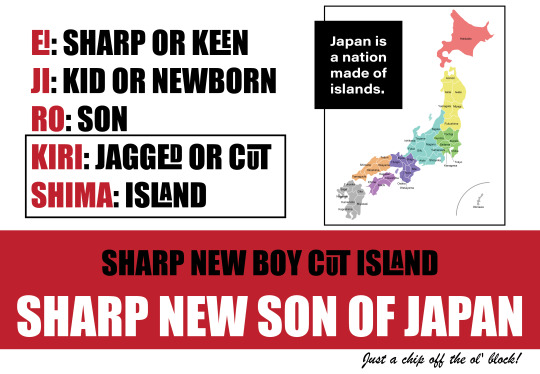
In case Kirishima’s association with his nation of origin wasn’t clear, his name is a dead giveaway.
Ei: sharp or keen
Ji: kid or newborn
Ro: son
Kiri: jagged or to cut
Shima: island
Eijiro means, as this kind person on the internet puts it, “sharp boy”. They also point out that the “Ei” is written in a way not ordinarily associated with names (which is usually “sharp” like “keen” or “intelligent”), so his name subtly “blunts” his intelligence while still pointing (ha) out that he’s a guy made of sharp rocks. And while that’s cute, it’s his last name that gives us more mileage for interpretation.
Kirishima. “Cut island”. Japan is a nation made up of multiple islands.
Kirishima is meant to be, very literally, a fresh-eyed child of his nation. He is emblematic of masculine heritage and identity. That’s a little more nuanced than saying Kirishima is Japan, but he definitely represents a significant pre-World War II slice of it. And he is on a mission to improve himself, and therefore the country, through a new and improved kind of “manliness”. Plus Ultra, bitches.
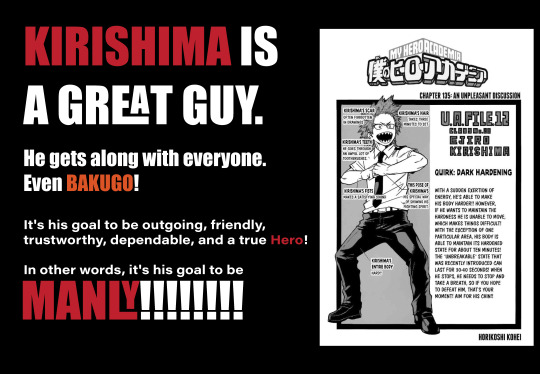
Kirishima is a truly wonderful guy and a unifying factor for the class.
One of the first people Kirishima forms a friendship with is Bakugo. I pointed out some of the similarities between Bakugo’s chosen presentation inspiration and Crimson Riot’s background in the Bakugo presentation. I’ll explore that extensively later on, but just keep in mind that it’s not exactly surprising that Kirishima is one of the first to find a common understanding with the class’ resident foul-mouthed, delinquent, western-style-military-costumed bomb.
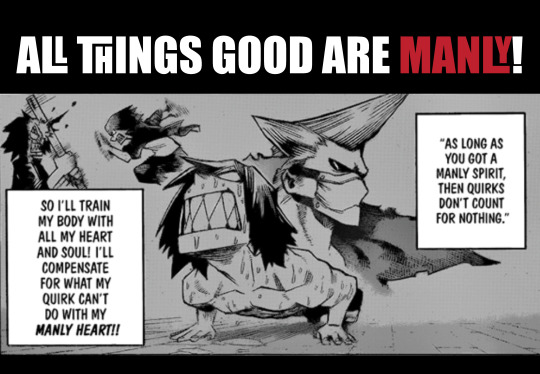
One of Kirishima’s most notable qualities is his tendency to describe anything he thinks is positive - the ability to show emotional strength as well as physical, shed tears and show sensitivity, do something competently, show consideration for others, act heroically in a general sense - as “manly”. The gender of the person performing the admirable action is irrelevant.
That last part is a big deal for his character, so I will say it again. The gender of the person performing the admirable action is irrelevant.
Crimson Riot, Japanese Delinquents, and “Manly Codes”
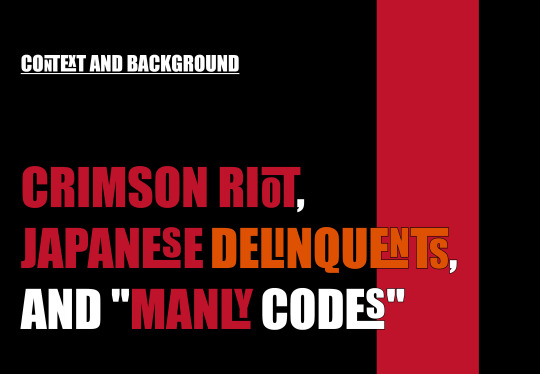
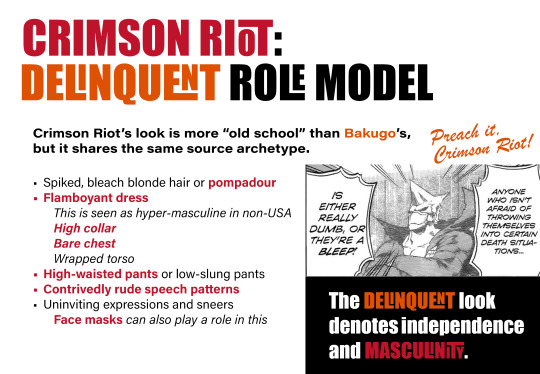
Kirishima’s penchant for calling admirable things “manly” isn’t random - it comes from someone else. His personal hero and role model, Pro Hero Crimson Riot, inspires him to use the language and associate it with positive things not limited or defined by gender. Crimson Riot’s dress, speech, and mannerisms, from which Kirishima also draws inspiration, also tell us a lot about him and his beliefs. Basically, we know he’s a Japanese delinquent/Yankee or bosozoku (which is basically a delinquent on a motorbike.)
Crimson Riot’s “manly” credo is rooted in the values and presentation of this real-world delinquent subculture.
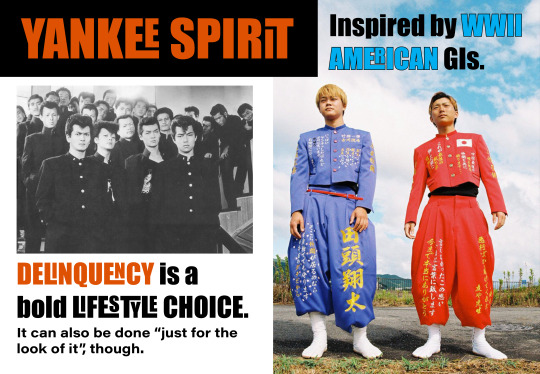
If you read the Bakugo presentation, you’ve seen this slide before.
The term “Yankee” was brought over by US soldiers (if you are from the States, you likely already know that a Yankee is someone from the northeast part of the country) and became synonymous with someone from the United States. Japanese delinquents are called “Yankees” because they walk around like a GI from the United States would - rudely, without consideration for others or the existing culture, and with a seeming need to flaunt their status as foreigners (and, more nastily, “winners” over the Japanese.) I talk more about the origins of the Japanese delinquent subculture in the Bakugo presentation, but the subculture’s origin comes down to this: dissatisfaction with the current society and a desire to express individuality born from something that can best be described as Western envy.
In appearance and attitude, Bakugo is also very obviously a Japanese delinquent boy, though he doesn’t use the same iconography of national pride. For the most part, neither do Crimson Riot or Kirishima. There’s a reason for that.
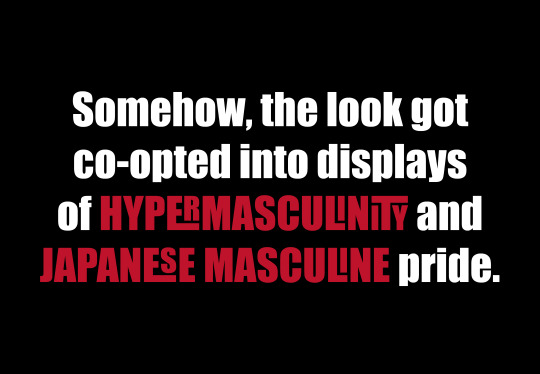

Interestingly, Bakugo lacks these visual markers of the “classic” delinquent look while Kirishima embraces some of them (the color red, the dyed hair with its wild styling, and the modern Japanese flag.) Instead, it seems Bakugo’s chosen delinquent visual identity markers are taken exclusively from the filter of shonen anime delinquents rather than the real world subculture! Their differing attempts to separate the things they like from its historic baggage is fascinating to me, personally.
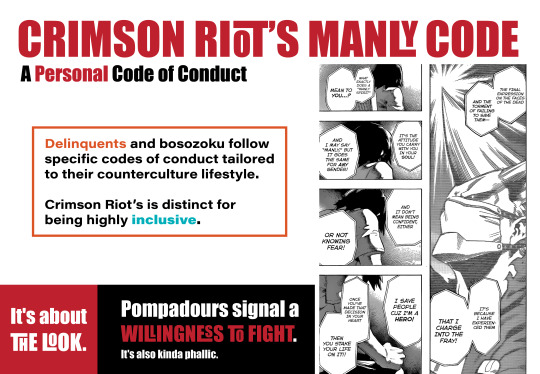
Bakugo’s outlook and personal presentation leans more towards a fictionalized version of the delinquent than Kirishima and his “manly” mentor’s, but the connection between their masculine presentations and implied personal conducts – or the fact that an underlying code of conduct is central to both identities – is still present.
If you read the article on delinquents I linked, you might notice that it emphasizes that a sense of community and closeness is a probable reason for the delinquent subculture’s enduring existence simultaneous to its rebellious and individualistic slant.
Kirishima and Bakugo are good representations of those two seemingly opposite poles, no? Kirishima focuses on creating a sense of community with himself as the unifying factor while Bakugo initially seeks to separate himself through his individuality.
The Yakuza framing of chivalry is not exactly the same as bushido, but rather the idea of “acting chivalrously” through what they refer to as ninkyodo, or the “way of humanity.” There’s still influence from and elements of bushido in this, however.
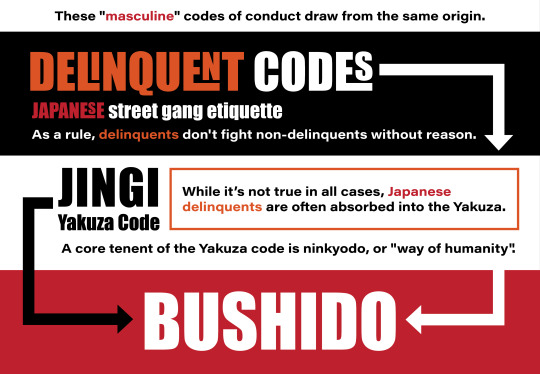
If you’re reading this, you’re probably a weeb, so you have likely heard of Way of the Househusband/Goshufukudo. The series’ tagline, “housework without honor or humanity!” is a play on the main character’s status as an ex-Yakuza because he left the Yakuza - or strayed from his ninkyodo/path of humanity - to be a househusband. It’s also a play on the Battles Without Honor or Humanity movies revolving around the same sentiment – except without the househusbandry part, of course.
(Also, the Yakuza created a recruitment website called ninkyodo. Considering the bigger discussion of social unrest and subdued envelope-pushing inherent in this manga, this wacky little blog post is worth a look since it pivots around the Japanese mob being upset with the government’s social programs.)
Delinquent codes draw from the Jingi, or Yakuza code and ninkyodo, which draws from bushido. You know what else draws from bushido? Most forms of contemporary and historic Japanese government.

Bushido has seven core values: gi (justice), yu (courage), jin (benevolence or another word for humanity - and yes, this is the same character as the “Jin” in Twice’s given name, Jin Bubaigawara), rei (gratitude - and no, this is not the same character as Rei Todoroki’s given name but it sounds the same), makoto (sincerity), meiyo (honor), and chugi (loyalty).
Why is this important? Because there is one VERY big difference between Kirishima’s presentation and aesthetic and that of Crimson Riot and Bakugo’s, and it also involves bushido and its masculine, militaristic associations.
In addition to Crimson Riot and delinquent culture, Kirishima blatantly includes kouha as one of his inspirations. Bakugo does not, and it is unclear if Crimson Riot pays attention to them specifically.
What Are Kouha?

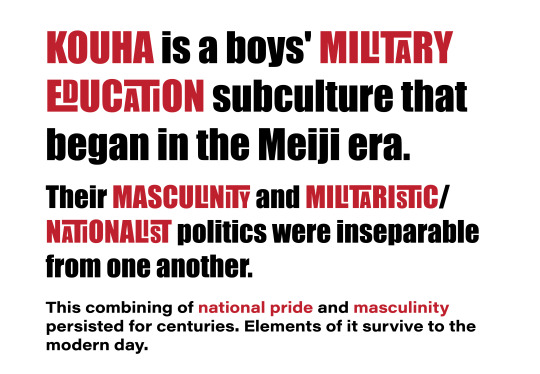
Kouha are, as Kirishima’s middle school classmates might say, “old school”. They’re even more old school than delinquents (or Crimson Riot), and they are also deeply nationalist. Kouha were a cultural phenomenon born from the student populations of Japanese military schools (the establishment of the Japanese Imperial Army is considered the first formal step of Japan’s westernization, by the way!) during the Meiji era. They held specific beliefs about male supremacy, masculinity, and national pride. To kouha, these concepts were inseparable from one another. They, and their resulting legacy as soldiers and Navy members in subsequent wars, are the main reason that quasi-nationalist or outright nationalist symbolism is so thoroughly entrenched in Japanese presentations of hypermasculinity even in the modern day.
Basically, kouha = Japanese Nationalists. This is an simplification, but you can read this entire Wikipedia article if you want a better picture of what I mean or need a starting point for your own research.
But don’t freak out! Kirishima’s admiration of kouha is, mostly, for the sake of a pun.
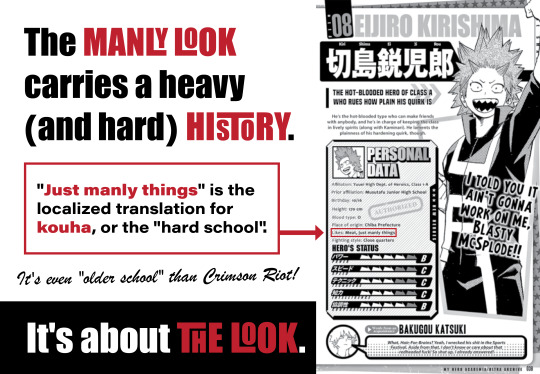
Horikoshi lists one of Kirishima’s favorite things as kouha (called “manly men” or “just manly things” in the most commonly circulated English versions), which means, more or less, “hard school”. It’s a pun on Kirishima’s hardening quirk. However, it also refers to Kirishima’s penchant for historically manly things and hypermasculine presentation.
Kirishima’s “Manly Look” and Japanese Identity
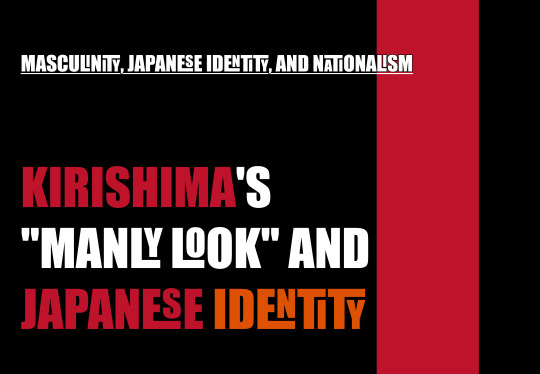
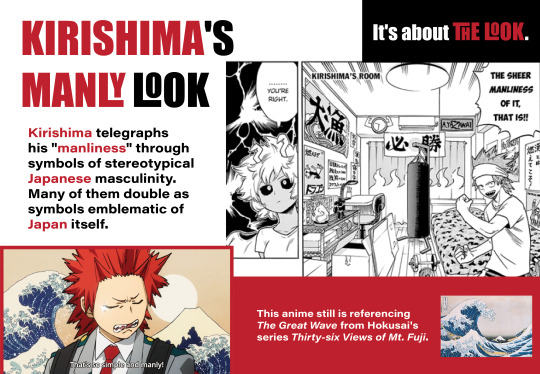
So, to review: Kirishima’s Crimson Riot-inspired philosophy and aesthetic is drawn from delinquent culture, which is a subculture that takes its cues from bushido – literally “warrior way” but sometimes called “samurai code” in English – which is in turn associated with Japanese pride and even nationalism. This association is very clear in Kirishima’s aesthetic. Look at his room. The Mount Fuji and ocean wave iconography, his hachimaki (admittedly this is relatively common among modern Japanese students, but it still carries a history), the tacky flames in representation of a “burning soul”…
But you know what he doesn’t use? Red sunbeams. This is really important.
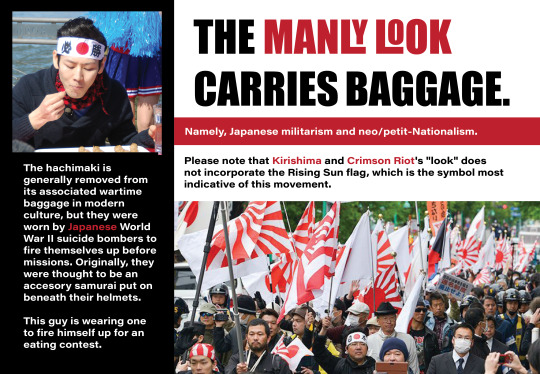
The specific “tackiness” and “kouha look” Kirishima enjoys can definitely be indicative of outright nationalism, but it is also associated with other hypermasculine subcultures that are not necessarily nationalists, including delinquent subcultures (though modern ones don’t often use the sunbeam-laden rising sun flag anymore. Modern delinquents usually stick to the modern Japanese flag as part of their uniforms or flags)
The fact that Kirishima’s “kouha look” does not include the sunbeam-laden Rising Sun flag (which, from the perspective of non-Japanese, is associated internationally with war crimes and, for related reasons, the Japanese Navy. Consider it a Japanese swastika—not to be confused with the Japanese manji, which is actually a totally different thing) or red sunbeam motif. This could be because My Hero Academia is set 200 years in the future and the rising sun imagery has fallen out of public memory. But personally, I think it is more likely that Horikoshi (and therefore Kirishima) wants to signal that Kirishima doesn’t hold the same beliefs as kouha and Japanese nationalists.
Even so, Kirishima’s “look” still suggests kouha and still associates his masculinity with his national identity.

This isn’t a perfect one-to-one localization, but, for us in the West, we can sort of think of it like this: the difference between Kirishima and a neo-nationalist is not unlike the difference between guys who authentically really like Viking iconography and neo-Nazis who appropriate Nordic iconography for their beliefs. It’s just that Kirishima seems to be reclaiming these symbols in reverse. (It’s probably a really good thing Mina knows Kirishima from his time before UA, or else she might have given him a way more intense and judgemental side-eye over what’s in his room.)
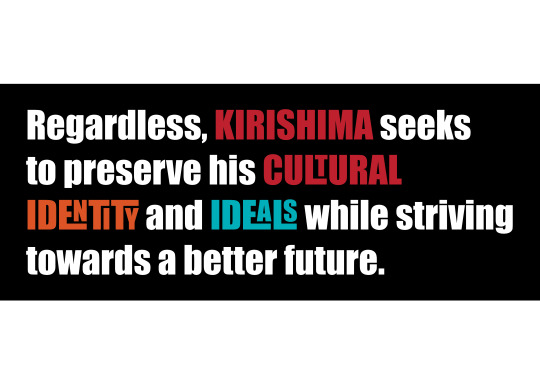
I suppose if one really wanted to, one could use everything I’ve written as an argument to say, “If you like Kirishima, you fell for the Japanese militarism and neo-nationalism apologist ploy”, but I don’t think portraying him as an apologist was the intent. I choose to see this as a shonen comic about superheroes and connecting the past with the present in pursuit of a better future because that’s all I think it is trying to be.

Again: Kirishima and Crimson Riot’s “manliness” philosophy departs from that of the kouha, Japanese nationalists (and neo-nationalists) because it is inclusive. The use of elements of their aesthetic preserves Kirishima’s personal pride as a Japanese guy - specifically as a “masculine” man - while his take on “manliness” is modern and geared towards celebrating the intrinsic goodness of humanity that isn’t defined by gender, sex, skin color, or even nationality, really, except as it applies as it being a thing for each individual to celebrate about themselves.
There’s other stuff kouha did and didn’t do that Kirishima doesn’t seem concerned about, either.
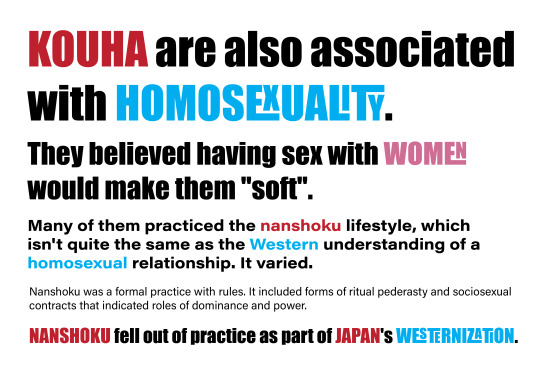
As I’ve said, modern Japanese sociopolitical (and masculine) identity is strongly associated with bushido. Bushido and kouha, particularly during the Meiji era and Russo-Japanese war (y’all ever read or watched Golden Kamuy?), is consequently associated with the Japanese Navy and nanshoku (THIS WIKIPEDIA ARTICLE IS MILDLY NSFW), or the practice of male-male relationships ranging from ritual pederasty to what one could interpret as “just plain gay” by modern western standards.
Whenever the Eastern or Western fandom discusses the possibility of Kirishima being gay-coded, this association between his kouha aesthetic and nanshoku is almost always at the heart of it. Well, that, and Kirishima’s dogged telegraphing of how much he’s into the kouha aesthetic and other “manly” things. To the modern Japanese, a high degree of overblown hypermasculine presentation and speech can come across as performative overcompensating.
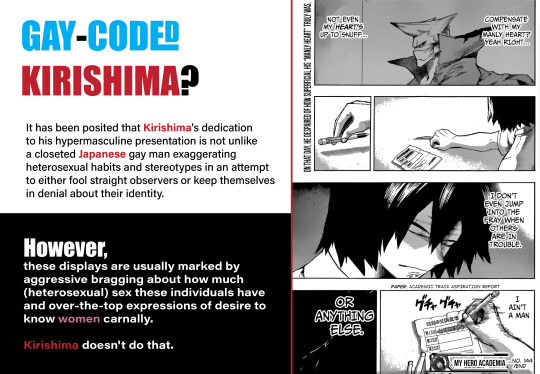
However, there’s one big detail that’s usually missing from these discussions in fandom: generally, the display of hyper-masculinity that is associated with performative overcompensating from closeted gay men includes constantly talking about how much heterosexual intercourse they have (which, according to them, is a whole lot) and how much they love women. Carnally. Sometimes they may even hit on women to an absurd and almost cartoonish degree – but usually only performatively in front of others or to try and fool (or repulse) the woman on the receiving end! The goal of a closeted gay person telegraphing heterosexual stereotypes to such an extreme degree is to either:
1. fool other people into thinking that they are not gay (which is often not very successful)
or
2. Keep themselves in denial by playing the part of an ultra-straight dude.
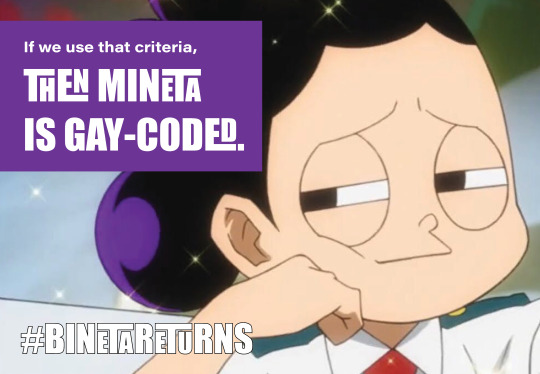
So, if I am using hypersexualized hetero behavior as the main parameter for how gay-coded a character is, I could argue that Mineta is more gay-coded than Kirishima is. He’s not, but I could make the argument.
But why would a gay person feel the need to do either of these things? Oof. Ain’t that the question. Masculine fragility has different nuances between cultures, but it isn’t exclusive to English-speaking countries. Modern Japan (read: Meiji era to post-World War II Japan that did its damnedest to Westernize as rapidly as possible) is relatively homophobic and views homosexuality as, well, “unmanly”. You can read more about that in the kouha and nanshoku Wikipedia articles I’ve linked. That’s the power of comphet!
That said, I don’t think Kirishima is gay-coded based on his affinity for manly stuff. He’s not using it to compensate for his sexuality. If anything, at his lowest, he used his “kouha-manly” presentation to compensate for his self-perceived lack of heroic and “manly” spirit. True heroism is what defines Kirishima and Crimson Riot’s perception of “manliness”, not sexuality. In fact, that’s the core of why their ideology is so progressive and why it flies in the face of its kouha-presenting packaging.
I mean, Kirishima could have any sexuality out there, but I don’t think his “kouha-manly” look is meant to be indicative of it, whatever it is.
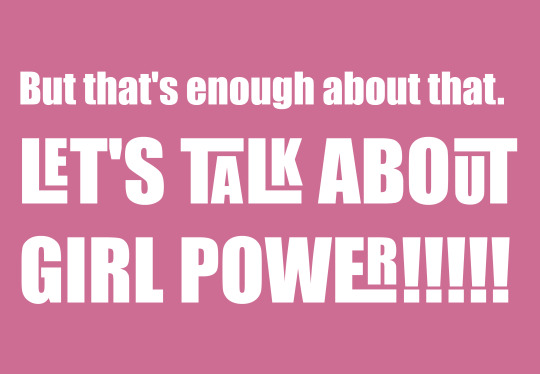
Mina Ashido: A Portrayal of Power in Modern Japan
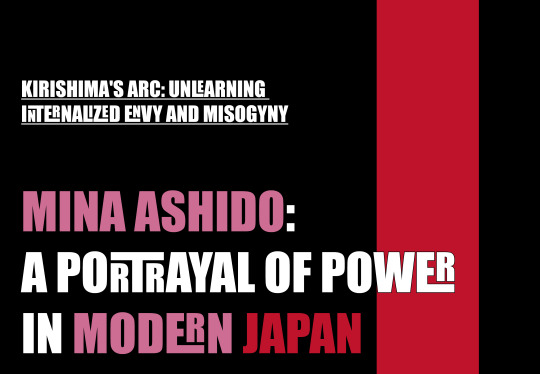
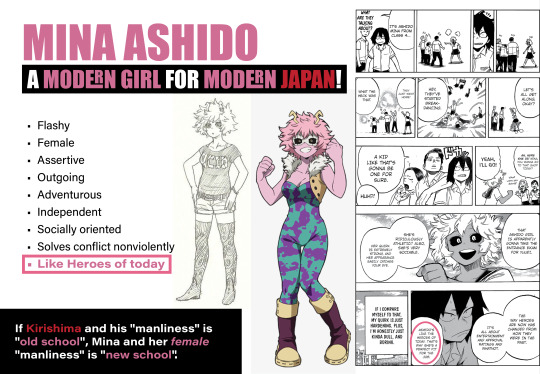
Mina is a major foil to Kirishima, so this writeup would be incomplete if I didn’t talk about her. If Kirishima is the “manly” Japan of a bygone era questioning how he can be relevant, Mina is “effeminate” modern-day, westernized Japan. Also, Kirishima’s key color is red. Hot damn, that’s flashy! It’s also the color of the sun on the Japanese flag! How fitting that Mina is represented by pink, or “light red”.
Simplifying the characters of Mina and Kirishima primarily by gender categories like that is a little more charged than I would prefer, but let me explain my logic.
During Japan’s occupation by the Allies after World War II, women gained, among other things, the right to vote. To quote Wikipedia directly: “It has been argued that the granting of rights to women played an important role in the radical shift Japan underwent from a war nation to a democratized and demilitarized country.”
They also were no longer bound exclusively to the home as wives and mothers, but could also take employment. Got it? Good. While I needed to explain this to set the stage for the stark difference in gender politics between the kouha’s heyday and womens’ standing after World War II, this is only loosely related to Mina and her portrayal.
Much like Kirishima, the biggest tells are evident in Mina’s look. In simple terms, traditional Japanese femininity isn’t flashy, isn’t westernized, and women don’t take the lead. Mina is flashy, westernized, and she does lead. In the manga, this is framed as a positive by her peers and something Kirishima admires and envies. (I have no idea how the older generation feels about it. We don’t know much about Mina’s personal life, unfortunately.)
Mina is a very modern girl. She stands out because of her natural appearance, but she also dresses ostentatiously whenever she isn’t wearing her high school uniform. Her look favors an updated spin on the gyaru subculture. In fact, while part of her natural appearance rather than intentional choice, I could argue that Mina’s startlingly black eyes and “unusual” skin is meant to indicate the yamanba (spinoff from ganguro) fashion subculture, but I’m not sure I am meant to go that far. Regardless of the specifics, everything about her appearance implies the largest commonality between most modern young Japanese women and every female-specific fashion subcultures (including lolita or kogal – Toga is a kogal): rejection of traditional gender roles and presentation.

I’m gonna sum up Kirishima’s own personal plot and backstory for the sake of reference.
Kirishima is a guy with a hardening quirk. It’s not flashy or particularly suited for offense or rescue, and he’s self-conscious about how “worthy” he is to be a hero not just because of his lackluster power, but because, in the past, he’s avoided stepping in situations where, if he were a true Hero, he would have stepped in and offered support without thinking about it!
Sound familiar?
Instead, his childhood friend (that he secretly admires very much but also feels very insecure around) stepped in to be capital-H heroic while he stood and gaped uselessly! And what’s worse? She is a GIRL. A WESTERNIZED GIRL did what he couldn’t do. So, obviously, if he can’t be more heroic and “manly” than a GIRL, he isn’t manly at all. And he’s scared of that.
Sound familiar?!
In high school, Kirishima puts on an outgoing persona (complete with a new hairstyle) inspired by his childhood hero (and also, lowkey, the childhood friend with which he associates the same kind of true heroism) to cover for his insecurities!
SOUND FAMILIAR?!
But that’s enough about how Kirishima and Mina’s story parallels Bakugo and Deku’s for now. Allow me to throw the other parallel in your face - the one between Mina and Kirishima and Japan and the US’s policy changes after WWII.
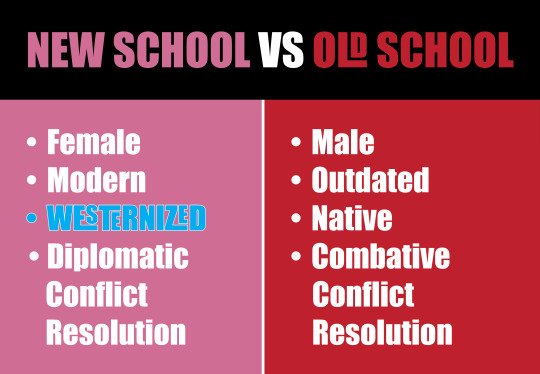
Mina, the modern, westernized Japanese girl, was first to act when “foreign power with old loyalty” Gigantomachia threatened their classmates. She solved the confrontation – and solved other confrontations with her peers – nonviolently. Meanwhile, kouha-aligned (militaristic and masculine Japan) Kirishima was not only unable to act (aka did not have any military influence), but felt completely useless and superfluous in both of these instances. (But later, when Gigantomachia re-emerges in a context that Mina cannot possibly solve on civil terms or with misdirection, Kirishima is able to defend her and do what she can’t. Even later, Mina learns the best ways to kick someone’s ass with her acid. She acts as the sword - or perhaps more precisely, the spear - to Kirishima’s shield.
If you didn’t know, the “sword and shield” analogy, or more commonly, “spear and shield” analogy is, or, at least, was, used to describe the US and Japan’s relationship after WWII. Whenever Kirishima talks about being the “ultimate shield” or “ultimate spear”, this means something.)
So, yes. This story is about the modern and traditional; the feminine and the masculine; the West and East. Just like Bakugo and Deku.
There exists a complicated relationship between national shame over losing the war, shame from Japan’s own war crimes, shame in Japan’s continued political ineffectiveness without a strong established military, and outright Japanese envy of the West for not only winning the war but epitomizing prosperity and modernity (or appearing to do so, at least.) I really don’t have the background to talk about this in-depth or respectfully. The point is that overt pride in the Japanese identity is a complicated issue, but particularly as it reflects in expressed Japanese masculinity. For Kirishima, his early relationship with Mina and the envy he feels towards her is a succinct crystallization of these feelings in allegory form.
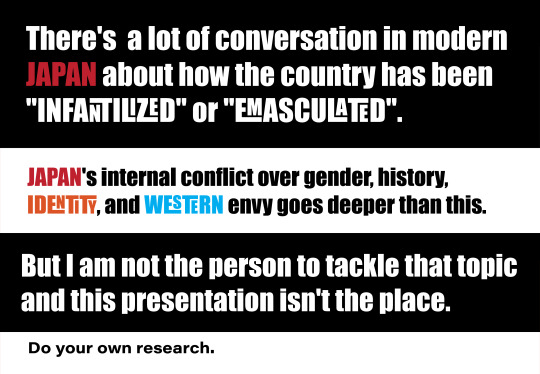
In the Bakugo presentation, I mentioned that the shonen genre was “born” after World War II and the art form still incorporates postwar baggage. This includes the aftermath of the nation reeling from its lack of military power after the war. I’ve already drawn a clear line between Japanese military might and its masculinity, so I don’t feel I need to elaborate much about why I make this next statement: a significant swath of the Japanese felt the loss of military power emasculated the country (which, as discussed through Mina, made it “effeminate”. Or, depending on the perspective, it “infantilized” the country. This introductory course examining shojo manga and identity touches on the infantilization of Japan through media exports and branding if you’d like to read another perspective using this terminology.)
I feel I should mention that Japan’s current crisis regarding declining birth rates is often associated with the lack of “properly masculine” men and the growing ability of modern Japanese women to put off or refuse marriage.The first observational piece about male subgroups discusses how masculine identity and neo-nationalism seem to be closely associated or even conflated for one another by the individuals in the neo-nationalist subgroup, but also alludes to the fact that a lack of clearly defined masculinity is being treated as a national crisis since it is seen as a prohibitive factor for Japan’s current generation to start families. To that end, Prime Minister Shinso Abe pushed for a variety of measures to encourage people to have kids.
In fact, Shinso Abe has achieved meme status in international otaku circles because whenever an anime or manga encourages or portrays sex for the purpose of procreation and raising a family as expected and singularly correct, the community wonders if it’s anime propaganda aimed at encouraging Japanese viewers to go have kids. This, combined with the fact that Shueisha/Shonen Jump upholds certain beliefs and gender/sexuality power dynamics in their company policy that is reflected in their published titles, will be important later in this series of presentations. For now, it’s just something to think about.
In shonen manga, including this one, the focus on men/growing mens’ identity (and the Japanese-specific flavor of masculinity) in a modern and changing world comes up a lot. While not directly related to Kirishima’s chosen counterculture influences, here’s a link to download an observational piece describing three notable cishet male Japanese subgroups struggling to define (or redefine) their own masculinity and identity: herbivorous men (kind of like western hipster metrosexuals), otaku (you know what these are), and Japanese petit-nationalists (basically neo-nationalists. And yes, they share elements from Kirishima’s aesthetic. If this were about Spinner and any heteromorph characters, this particular group would be much more relevant to this discussion.) Here’s another piece focused on “genderless” danshi and masculinity. Both of these pieces discuss the precarious correlation between male identity, community, presentation, and values. That, and I think they’re neat topics – though I do suggest you think critically about what you read in them.
Anyway, let’s get back to talking about this damn manga.

If you ever asked yourself, “How would Bakugo and Deku’s relationship differ if Deku had a quirk?” or, “How would Bakugo and Deku’s relationship differ if one of them was a girl?”, here’s your answer: it would be very similar to the relationship between Kirishima and Mina. Most of the relationships between pairs or sets of characters is meant to reflect off of the relationship between Bakugo and Deku in some way as either a compare/contrast exercise or to show how different things could be if fate had conspired to make one or two small differences in their lives.
This is thematically crucial to understand for almost every moment in the story.
Reflections of Kirishima’s Feelings of Inadequacy and Powerlessness

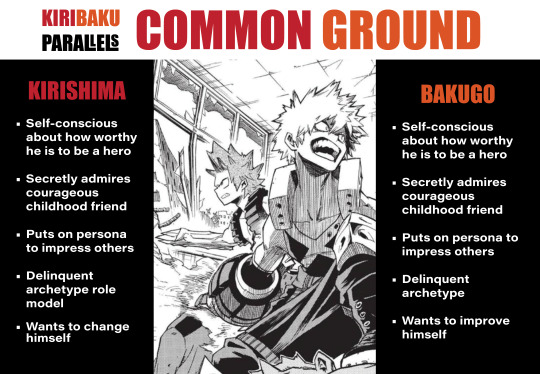
Kirishima and Bakugo have a lot in common. It’s not terribly surprising they became friends even when Bakugo was at his worst, since Kirishima could likely relate to where he was coming from and how he was feeling on some level.
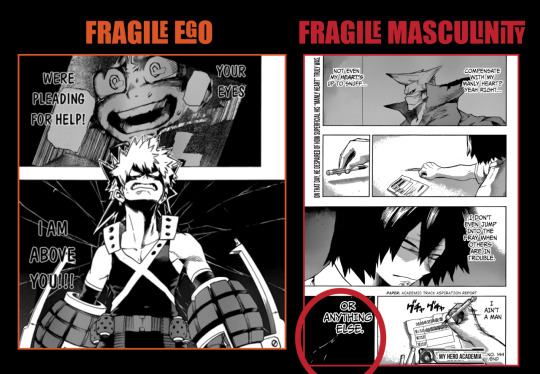
If you thought Mina being a girl was inconsequential to Kirishima’s feelings of inadequacy, think again. Luckily for everyone, Kirishima isn’t as much of a sensitive, fragile, and dramatic bitch as Bakugo about his insecurities.
Kirishima also hadn’t been explicitly stewing on them as they applied to one specific person for roughly 11 years of his life, either, so. There’s that.
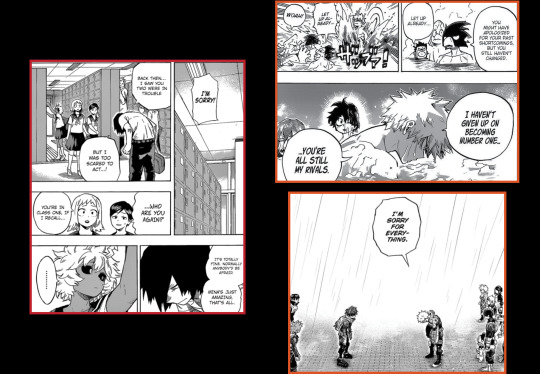
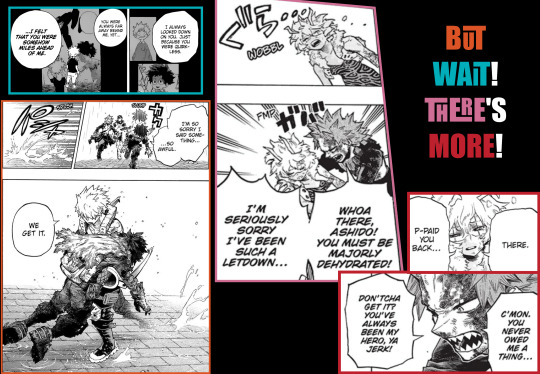
Bakugo’s relationship with Kirishima is an introductory course for him on how to have a positive relationship with Deku. For Kirishima, Bakugo is a proxy for relating to and helping the person in his life that he admires most: Mina.
But the Kirishima-Bakugo parallel isn’t the only parallel we need to draw.
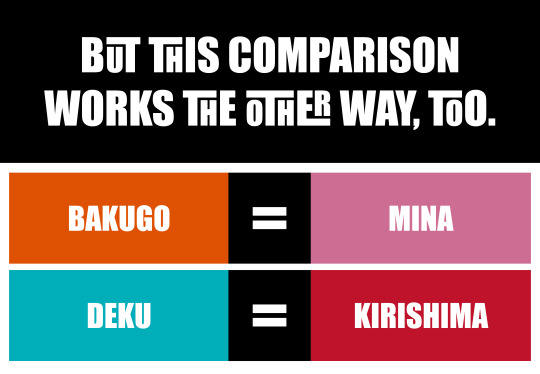
Arguably, Kirishima shares more similarities with Deku than Bakugo (but, of course, Deku and Bakugo are also very similar, too.) Kirishima is not confident in himself, mimics his idol very closely, is very concerned with upholding the status quo (through interpersonal harmony), got into UA through his effort rather than because he has a well-suited quirk, is quick to act “heroically” and put others before himself, is quick to throw himself into danger on others’ behalf (he’s got a hardening quirk, so unlike Deku he doesn’t mangle himself repeatedly with these stunts), and has an I-won’t-admit-it-for-most-of-the-series-but-I-will-broadcast-it-in-other-ways object of admiration in his childhood friend Mina.
Also, Kirishima feels woefully inadequate when compared to Mina because, in his eyes, she already has the appearance of a hero (and professional Hero.)
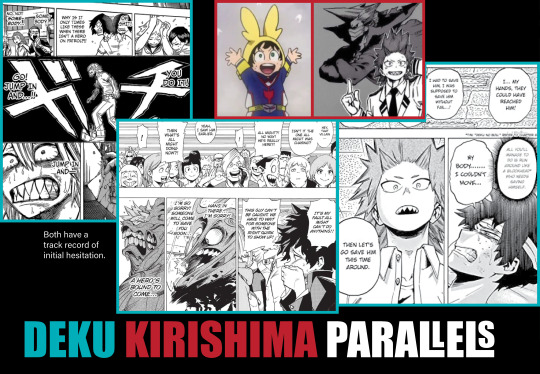
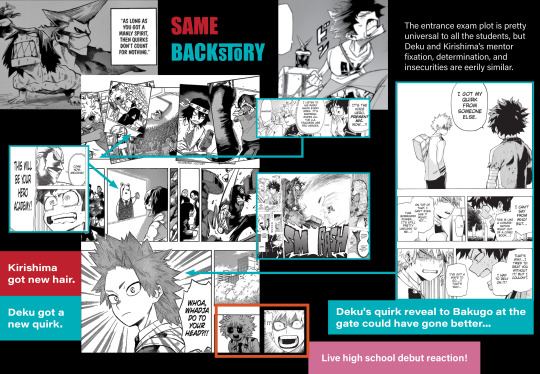

Kirishima’s outgoing attitude is a product of him pushing himself to be more like Mina in charisma and approachability. The horns of his hair are also inspired by her, too. While both of these things can be framed as parallels to Bakugo’s admiration of Deku as I did earlier, they are more on-the-nose for Deku’s penchant for intentionally talking like Bakugo when he wants to psyche himself out and copying all of Bakugo’s moves in order to best harness his quirk. And, of course, when Kirishima and Deku don disguises to go save Bakugo, they choose outfits with exaggerated horns (like Mina) and a Yakuza/delinquent persona (like Bakugo) respectively.

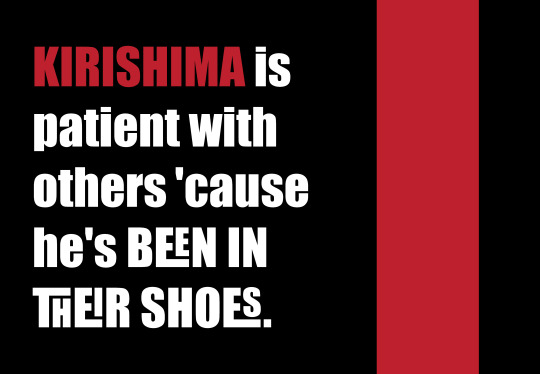
Kirishima seems to be able to “read the room” when it comes to the relationship between Deku and Bakugo - and in both directions. Personally, I am not surprised that he chooses to quietly support both of them when it comes to the other.
But perhaps the more interesting parallel is the one drawn between Bakugo and Mina.
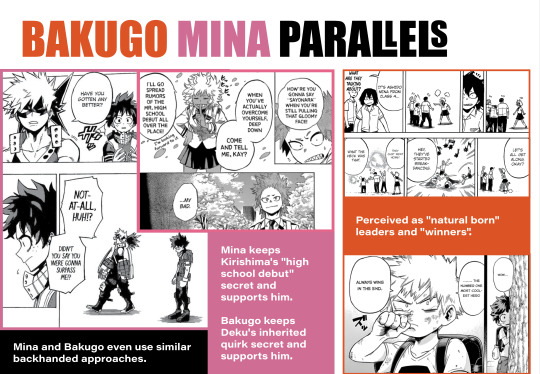
When Mina uncovers Kirishima’s “secret” (he dyed his hair and changed his outward persona to make a good impression as a friendly and outgoing guy with his “high school debut” rather than come off as a shy fanboy), it’s analogous to Deku telling (albeit vaguely) Bakugo about One for All at the beginning of the manga. Both scenes even take place at the start of the school year with cherry blossoms in the background and stuff. Later in the series, after Bakugo figures out the full secret of OfA (much like Mina figures out that Kirishima wants to be popular), he even explicitly says he’ll keep Deku’s secret.
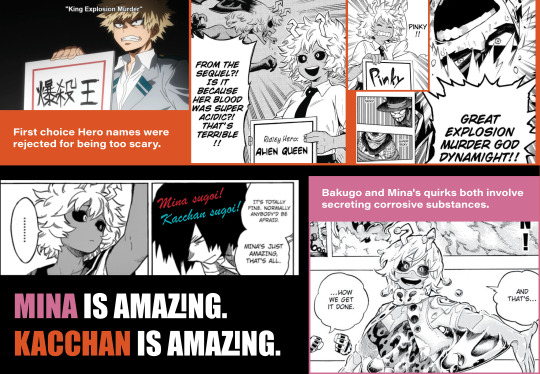
Mina and Bakugo are both described as “amazing” and both imply significant discomfort over the generalized compliment. It’s a huge expectation to carry.
Mina’s “Alien Queen” is denied as a Hero name just as Bakugo’s “King Explosion Murder”. Huh. Funny, that.

Kirishima and Mina are constantly improving using the other as inspiration, just as Deku and Bakugo do. They learn from other sources, too, of course, but these two sets of characters have an established feedback loop.
While Bakugo doesn’t struggle academically like Mina, especially during the training camp, his personal failures, many of which are social, are often broadcast on television. Both of them look like idiots in front of their respective foils.
Also, Bakugo and Mina both kicked ass at the school festival - Mina with the dancing and Bakugo on the drums. Deku and Kirishima were, you know, support. Extras.
During the festival, Mina and Bakugo were also both demanding taskmasters - Mina expected the best of her dance crew while Bakugo always had something to say about the pace and technique of his band members. Ha!
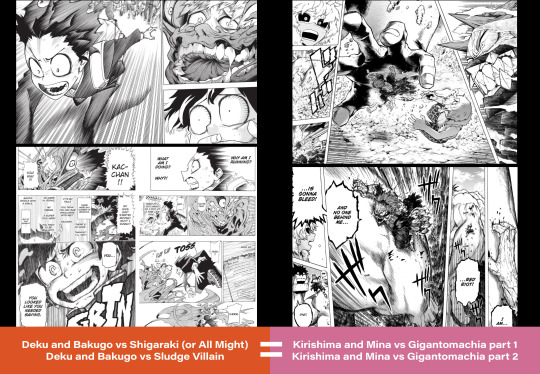
When Kirishima saves Mina in their confrontation with Gigantomachia, he does it without regard for his own safety (after initially hesitating and panicking like Deku did for the first part of the sludge villain incident!) Gigantomachia is also, interestingly, a shared past foe of Kirishima and Mina much like the sludge villain is for Bakugo and Deku.

Considering how they parallel one another and how Mina’s Acidman Alma is inspired by Todoroki and Bakugo, I like to think that her win against the sludge villain was an inadvertent moment of revenge on Bakugo’s behalf, even if her character didn’t intend for it to be.
Chapter 383′s initial fan title translation of “A Small Heart” is also interesting, considering how the turn of phrase relates to the figures of speech used for Bakugo’s ego in the manga’s early chapters (inflated heart.) Viz translated it as “Meek Spirits”. A “small heart” seems to indicate cowardice or fear on Mina’s part (or the Sludge villain’s.) Despite Bakugo’s inflated ego (heart), his was also rather small in terms of facing his secret fears of inadequacy and, well, Deku.
The point is, even when Mina and Bakugo’s hearts were “small”, they saved Kirishima and Deku respectively.
Someone who knows more about Japanese could say more on this, as well as share more disambiguation between whether the English or Japanese connotations of the word “heart” are at play here. There’s some discussion about that in the Uraraka-Bakugo-Toga presentation.
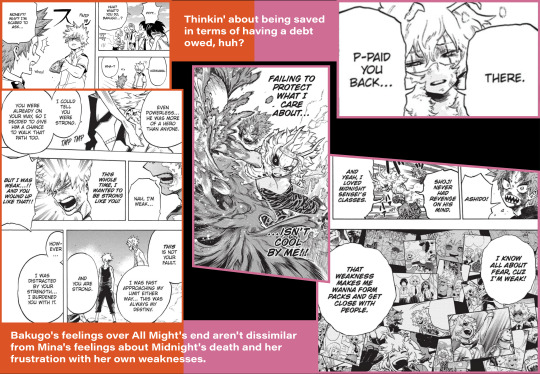
For all her confidence, Mina gets scared and nervous, too. But she doesn’t give up!
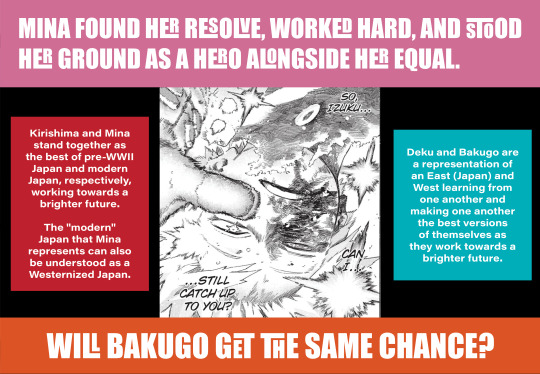
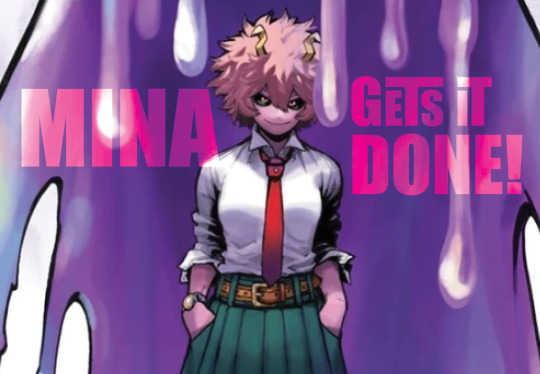
Mina gets it done!
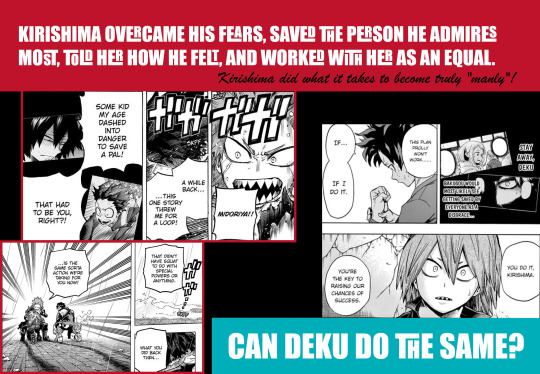
Will Bakugo and Deku accomplish what Mina and Kirishima have? I dunno. But even so,
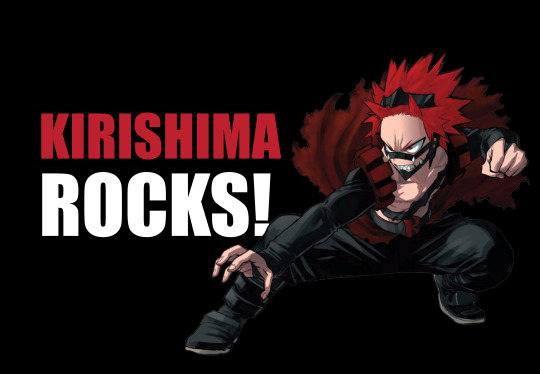
Kirishima rocks on his own and alongside Mina!
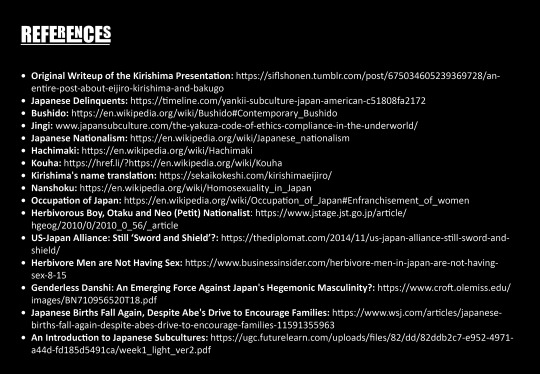
#bnha#bnha meta#bnha manga spoilers#kirishima eijiro#mina ashido#kirimina#bakugo katsuki#izuku midoriya#bakudeku#kiribaku#mha meta#mha spoilers#my hero academia#kirishima presentation
248 notes
·
View notes
Text
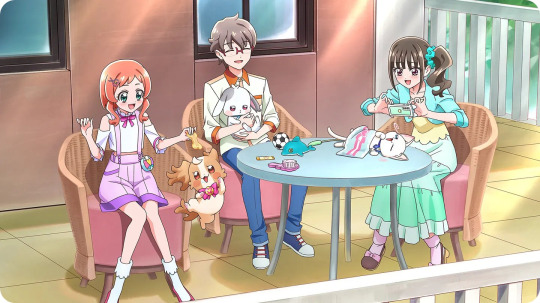
An image of what seems to be the main cast for Wonderful.When it comes to the little bit of details being expressed so far it's a mix of weirdness but I generally have a good feeling over the upcoming season's theme and execution.The main idea is showing us that our leading Cure is actually a dog who gains the ability to transform into a human girl and of course a Pretty Cure.I can excuse her name being Cure Wonderful thanks to that,if anything thanks to the pun it might be better off calling her Cure Wan-Derful.
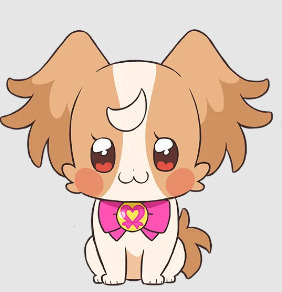
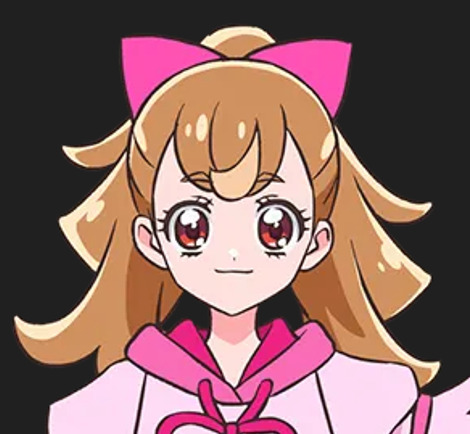
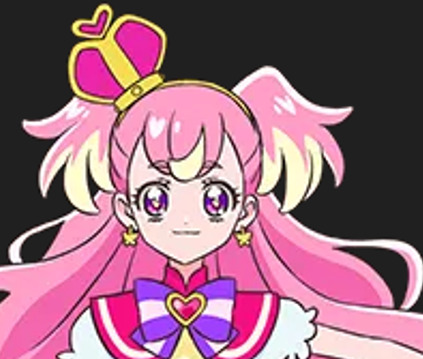
For past experiences her voice actor has taken credit for that's a character I know she's supposed to be Kanna from Dragon Maid.So using that for reference this isn't her first time dealing with what I think can classify as "Shapeshifter".Her dog genetics also say she's the Papillon breed which being more of a cat person I don't really have much experience to but a page on the American Kennel Club website did provide some handy statistics that might be worked into her character.
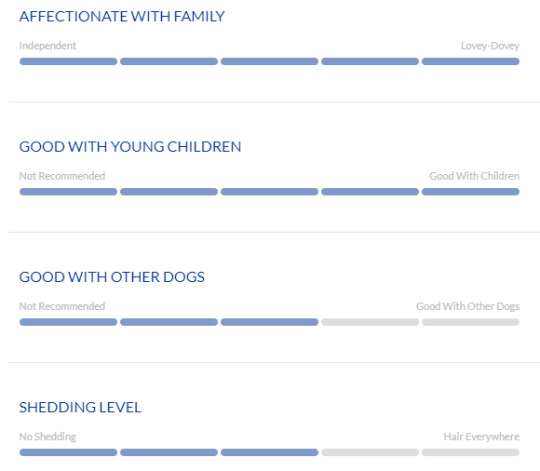
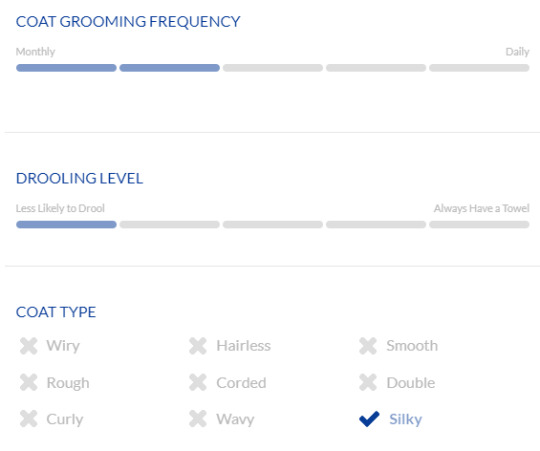
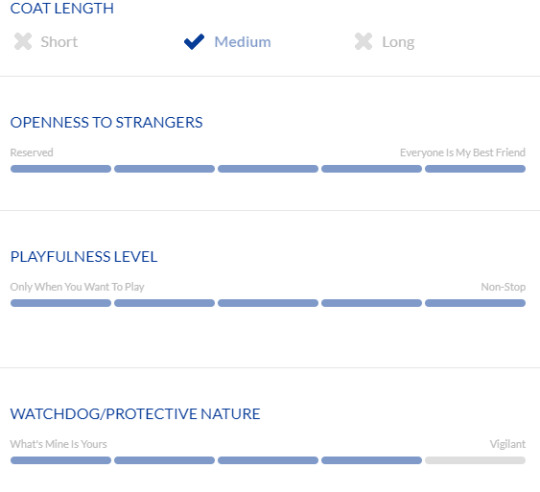
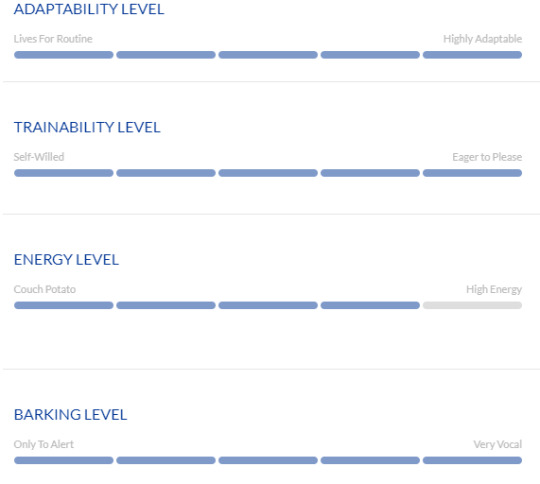

As I said already the naming scheme for the initial Cure Status Quo feels a bit weak compared to the motifs of previous seasons but I can excuse that when your team leader is an actual dog most of the time.
Bringing us to our next most major Cure we have a bit more info on,Iroha Inukai aka Friendy.Her name in magical girl form is likely rooted to how dogs get referred to as "Man's Best Friend".
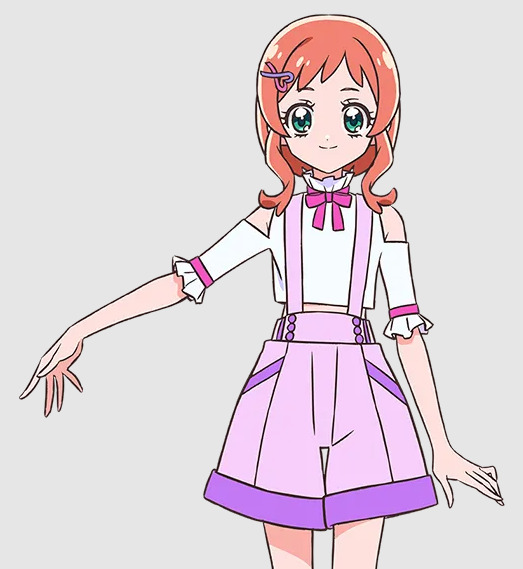

Design-Wise I'm not quite sold on her default outfit and hope the fashion she'll get later on(When the seasons change or similar) and I think the hat would look better if it covered her whole head rather than being a tiny thing on the side.Her voice apparently being who does Anya [Forger] among a few other characters makes me really want her to be worthy of my ever expanding list of favorites and shows this isn't her first time being a magical girl or dealing with a weird dog.
Similar to the season we're closing off on we don't have true details for Nyammy and Lillian but it isn't too hard to put the clues together.
"Nyammy" contains Nya which is how Japan tends to express what English would call "meow".There is a white cat named Yuki present along with her owner,Mayu Nekoshiyama.
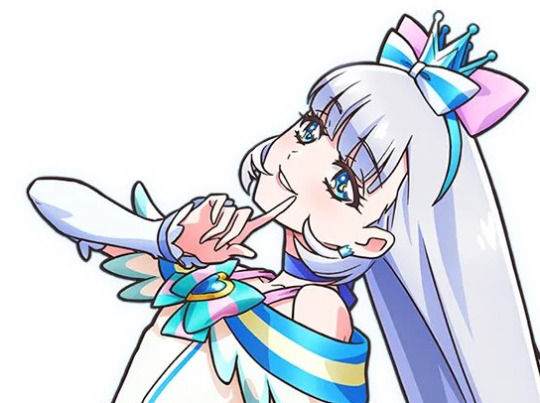
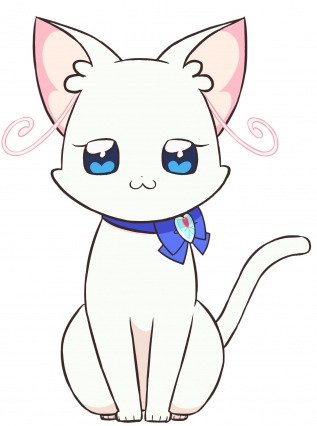
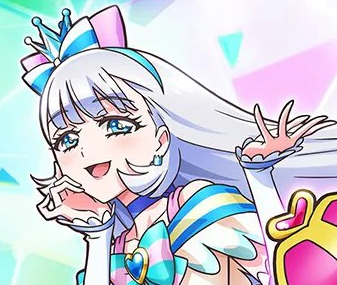

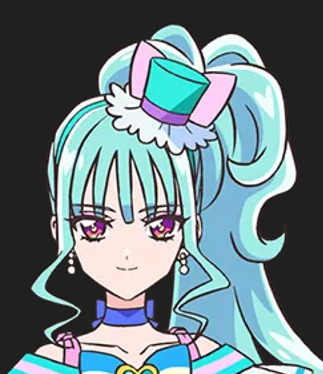
The pink ribbon placements sort of remind me how Blake concealed her cat ears in the first volumes of RWBY.With how order is place in the quartet Yuki is going to be the one who transforms first followed by her owner.Not too sure how much of a time skip this will be in the grand scheme but the little bit of info presently given on Mayu says she recently moved into the town."Lillian" might also be an odd choice of name considering the limited knowledge at the moment for it's a name that seems rather human instead of descriptive or constructive(Then again,Laura just used her last name) and seeing the meaning of it as a girl's name it's supposed to give a sense of peace and passion but at the same time it's based on lily flowers...Which I have seen several informative sources say are HIGHLY TOXIC TO CATS and it might be very telling that a cat is possibly implied to have assisted in her owner's Cure name.
Our last duo in the visual is currently more for the hypothetical theories right now than outright stated from initial visual choices.If it's going the way they're wanting us to think they're who I am really pinning the money on.
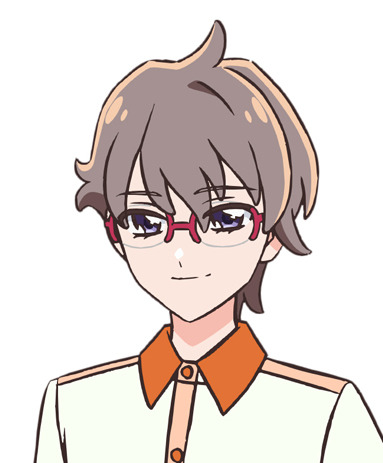
Glasses Boy is Satoru Usayama while his bunny's name is Daifuku
The former is definitely hinting to have a lot of those marks I said I'd want for a male cure successor for Tsubasa:
Classmate to one of the main characters(So he does attend the school)
Outfit hints he's going to fill the niche of the yellow/orange/gold member to the team
Ends up needing to be a secret keeper about the girls' being Pretty Cure
If he keeps his glasses or they turn into a monocle when the time comes and everything checks out that's perfection in my book.In regards to his rabbit...

Apparently that's one brave bunny not that I can read that going by the facial expression the first impression is giving.Need to wait for the show proper to truly see the loppy lapin in action.
Now for the final shreds of detail that more-or-less are "public"...

Whatever role these animals will be serving they very much seem a bit like an extended cast including recolors of the animals from Healin' Good

Lastly is our first shot at one of our monsters of the episode which this time around are starting out with the name of "Garugaru"
This might very well be best viewed as the Pretty Cure spin on some subject matters Animal Detectives Kiruminzuu dealt with and all we have to do is wait for the fourth of February to see it start to unfold
#Pretty Cure#PreCure#Wonderful PreCure#Komugi Inukai#Cure Wonderful#Iroha Inukai#Cure Friendy#Yuki Nekoshiyama#Cure Nyammy#Mayu Nekoshiyama#Cure Lillian#Satoru Usayama#Daifuku Usayama
39 notes
·
View notes